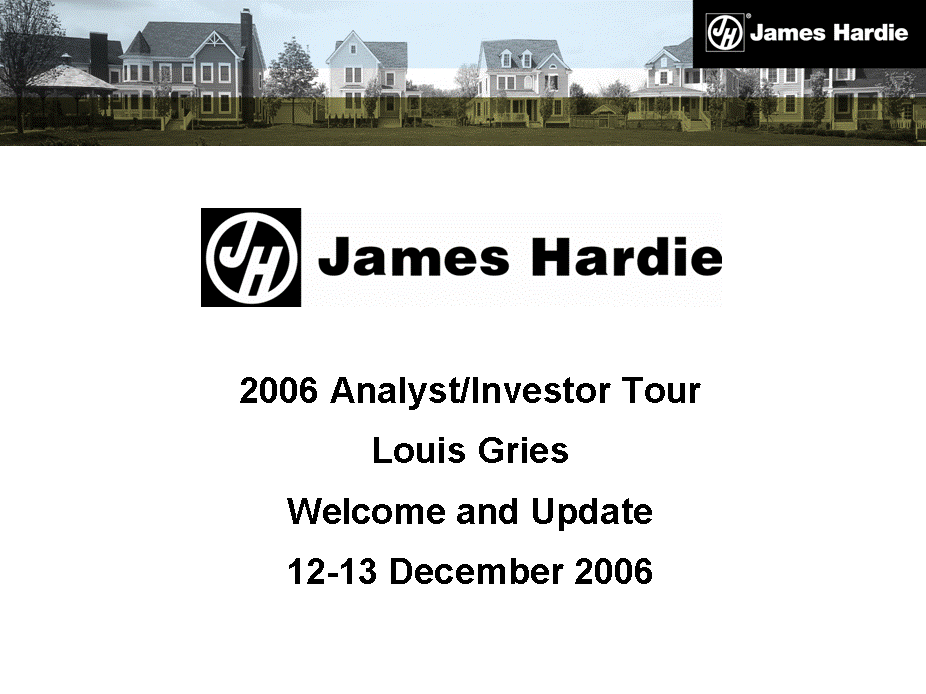
1

| 2006 Analyst/Investor Tour Louis Gries Welcome and Update 12-13 December 2006 |
2
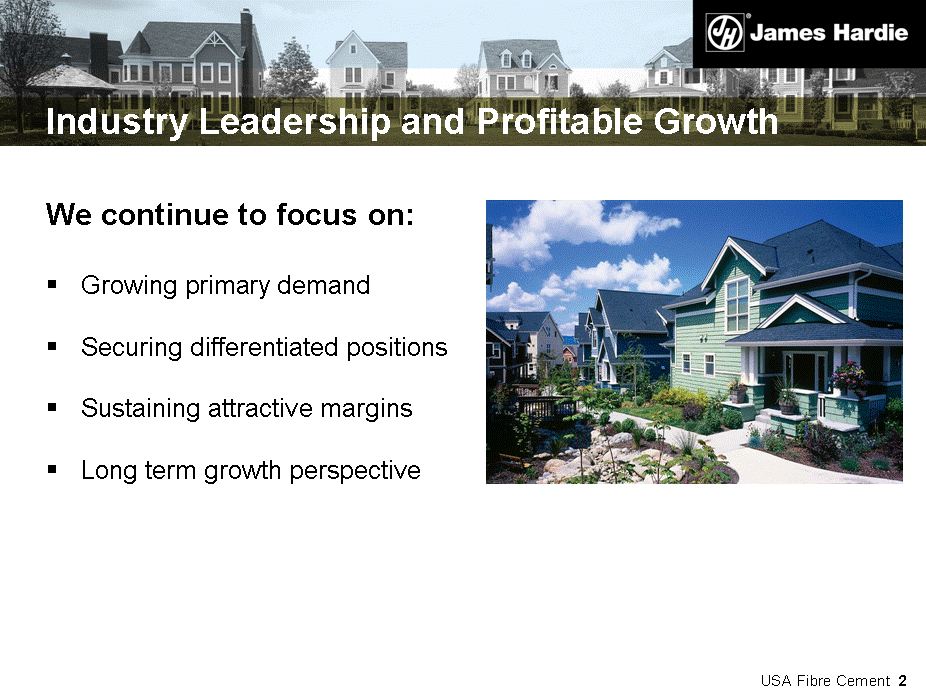
| Industry Leadership and Profitable Growth We continue to focus on: Growing primary demand Securing differentiated positions Sustaining attractive margins Long term growth perspective |
3
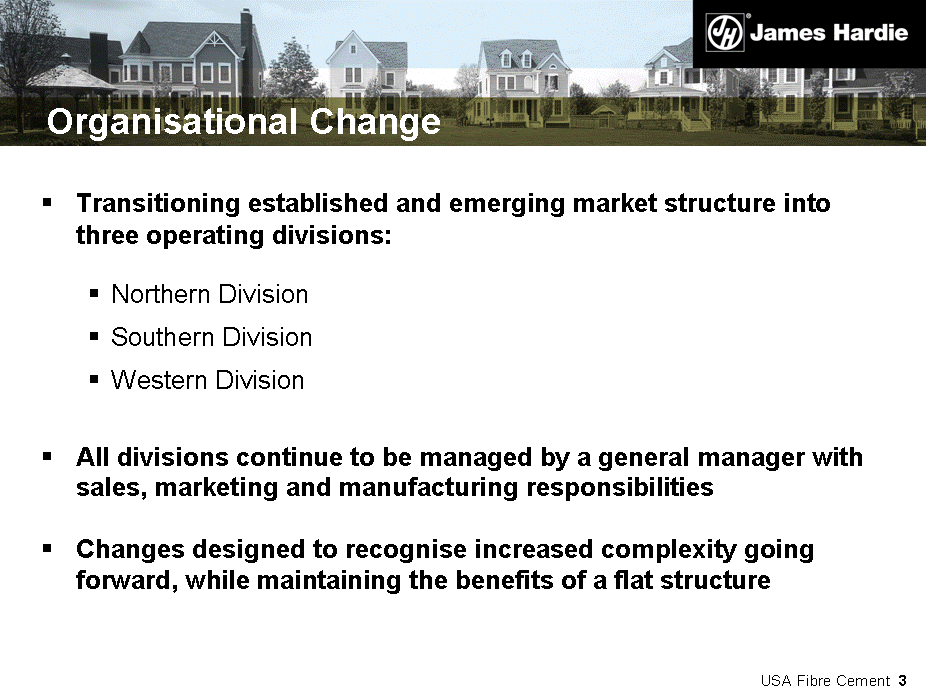
| Organisational Change Transitioning established and emerging market structure into three operating divisions: Northern Division Southern Division Western Division All divisions continue to be managed by a general manager with sales, marketing and manufacturing responsibilities Changes designed to recognise increased complexity going forward, while maintaining the benefits of a flat structure |
4

| Senior Leadership Team - Operations Louis Gries Chief Executive Officer/ President USA FC Grant Gustafson VP Interiors and Business Development Nigel Rigby VP/General Manager Northern Division TBA VP/General Manager Southern Division Gigi Myung VP/General Manager Western Division Jamie Chilcoff VP Marketing/ International Business Mark Fisher VP Research and Development Robert Russell VP Engineering and Manufacturing |
5
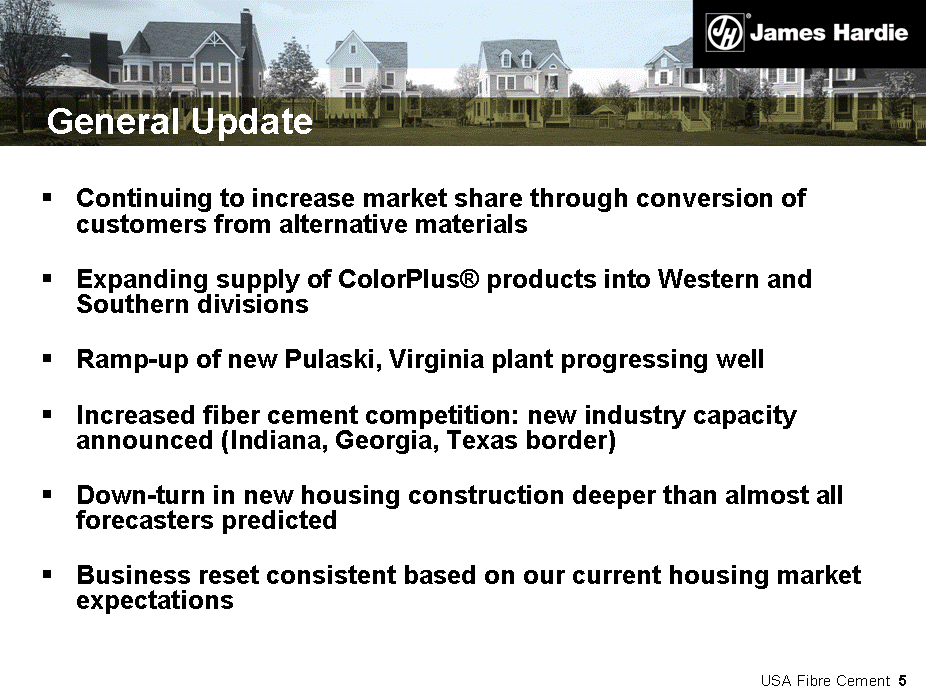
| General Update Continuing to increase market share through conversion of customers from alternative materials Expanding supply of ColorPlus(r) products into Western and Southern divisions Ramp-up of new Pulaski, Virginia plant progressing well Increased fiber cement competition: new industry capacity announced (Indiana, Georgia, Texas border) Down-turn in new housing construction deeper than almost all forecasters predicted Business reset consistent based on our current housing market expectations |
6
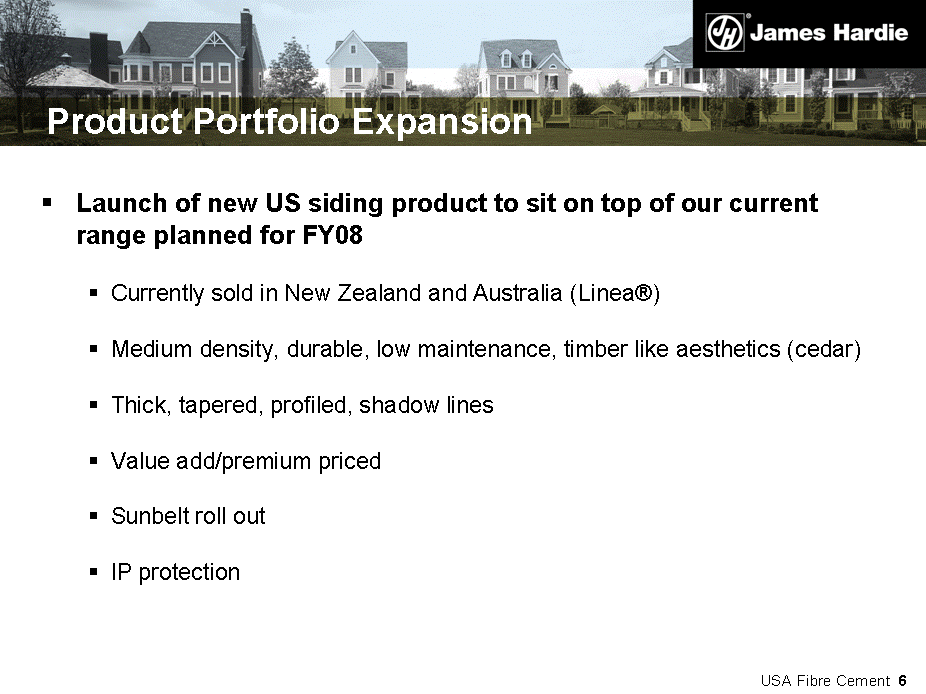
| Product Portfolio Expansion Launch of new US siding product to sit on top of our current range planned for FY08 Currently sold in New Zealand and Australia (Linea(r)) Medium density, durable, low maintenance, timber like aesthetics (cedar) Thick, tapered, profiled, shadow lines Value add/premium priced Sunbelt roll out IP protection |
7
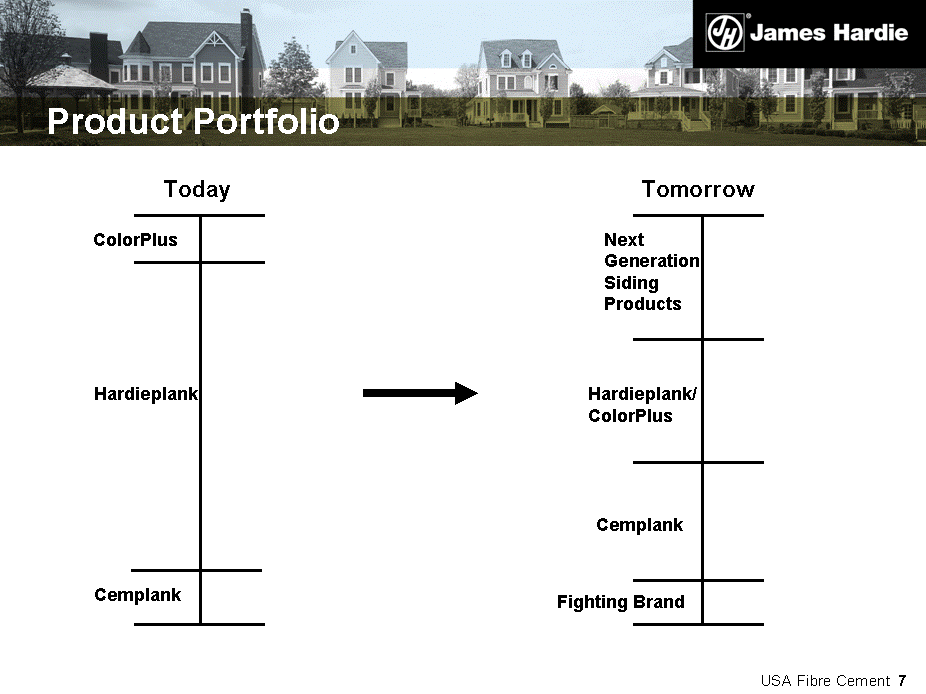
| Product Portfolio Cemplank Hardieplank ColorPlus Next Generation Siding Products Hardieplank/ ColorPlus Cemplank Fighting Brand Today Tomorrow |
8

| Housing Down-turn Reset Business model adjusted down, but able to 'flex up' quickly Production rescheduling to balance supply and demand Sales and marketing activities reviewed and reallocated based on lower market opportunity Corporate wide review undertaken of cost saving opportunities Continue to: Focus on market share gains Fund growth initiatives Target manufacturing efficiencies Build organisational capabilities |
9
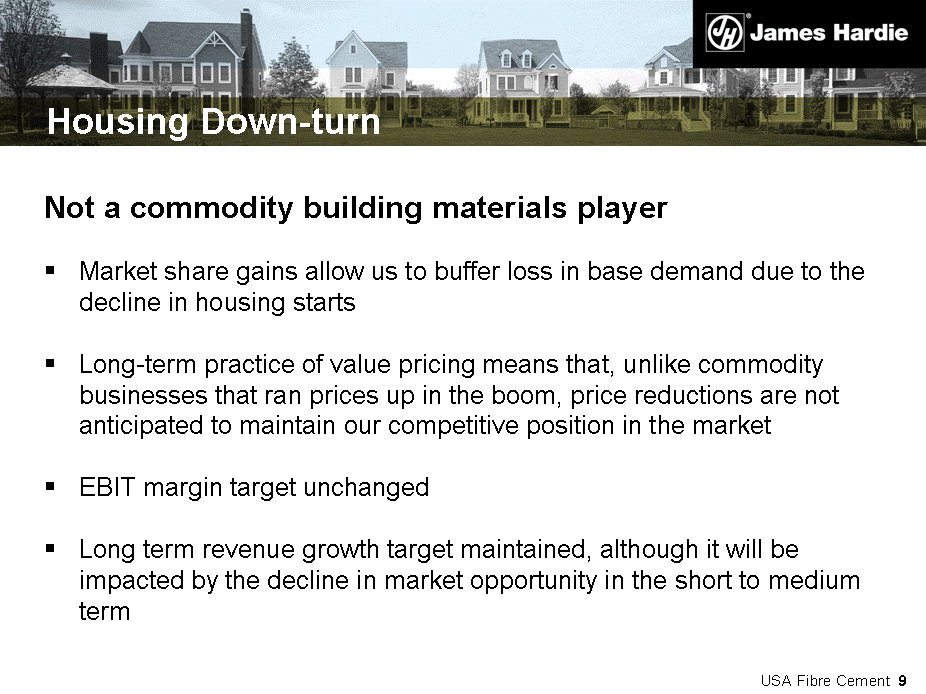
| Housing Down-turn Not a commodity building materials player Market share gains allow us to buffer loss in base demand due to the decline in housing starts Long-term practice of value pricing means that, unlike commodity businesses that ran prices up in the boom, price reductions are not anticipated to maintain our competitive position in the market EBIT margin target unchanged Long term revenue growth target maintained, although it will be impacted by the decline in market opportunity in the short to medium term |
10
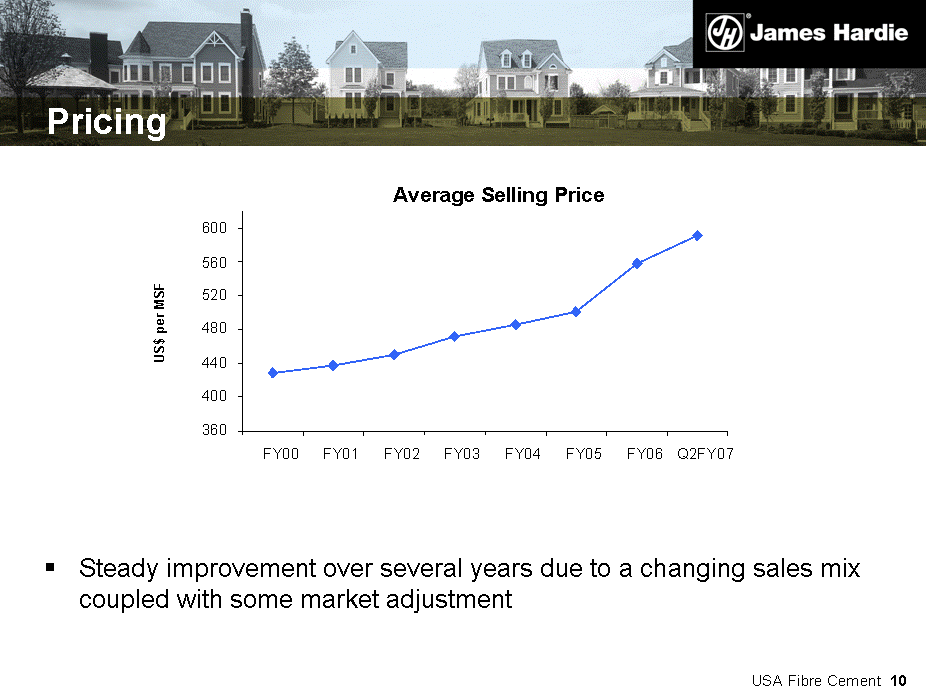
| Pricing Average Selling Price US$ per MSF 360 400 440 480 520 560 600 FY00 FY01 FY02 FY03 FY04 FY05 FY06 Q2FY07 Steady improvement over several years due to a changing sales mix coupled with some market adjustment |
11
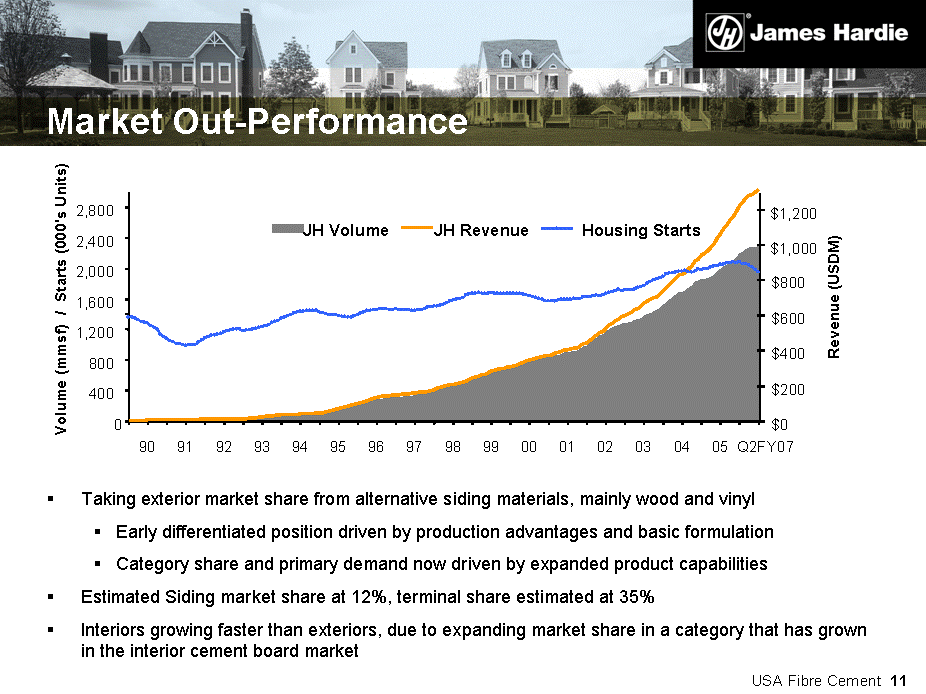
| Market Out-Performance Taking exterior market share from alternative siding materials, mainly wood and vinyl Early differentiated position driven by production advantages and basic formulation Category share and primary demand now driven by expanded product capabilities Estimated Siding market share at 12%, terminal share estimated at 35% Interiors growing faster than exteriors, due to expanding market share in a category that has grown in the interior cement board market 0 400 800 1,200 1,600 2,000 2,400 2,800 90 91 92 93 94 95 96 97 98 99 00 01 02 03 04 05 Q2FY07 Volume (mmsf) / Starts (000's Units) $0 $200 $400 $600 $800 $1,000 $1,200 Revenue (USDM) JH Volume JH Revenue Housing Starts |
12
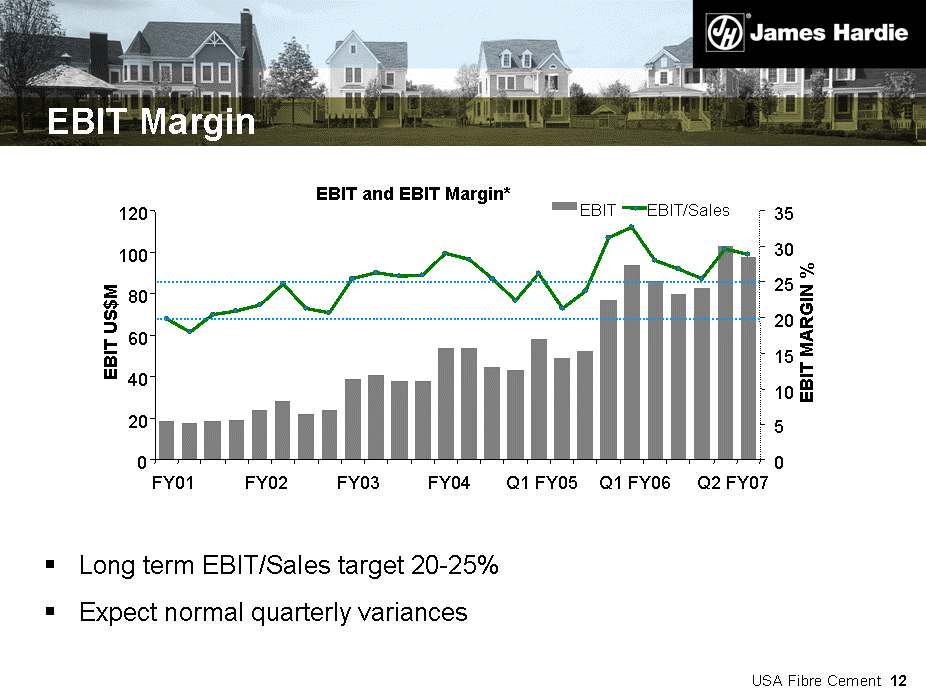
| EBIT Margin EBIT and EBIT Margin* 0 20 40 60 80 100 120 FY01 FY02 FY03 FY04 Q1 FY05 Q1 FY06 Q2 FY07 EBIT US$M 0 5 10 15 20 25 30 35 EBIT MARGIN % EBIT EBIT/Sales Long term EBIT/Sales target 20-25% Expect normal quarterly variances |
13
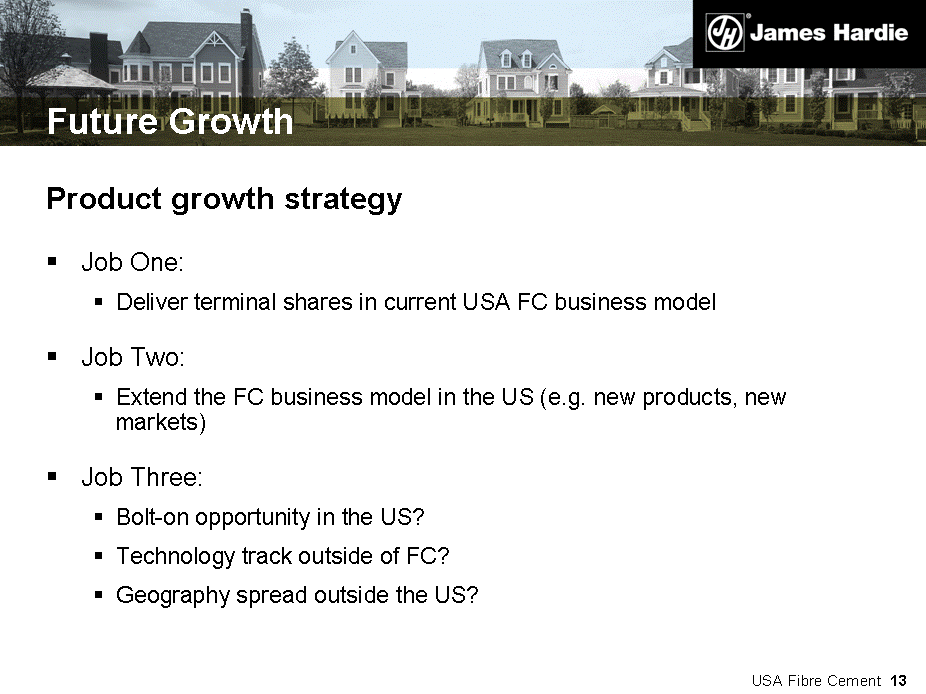
| Future Growth Product growth strategy Job One: Deliver terminal shares in current USA FC business model Job Two: Extend the FC business model in the US (e.g. new products, new markets) Job Three: Bolt-on opportunity in the US? Technology track outside of FC? Geography spread outside the US? |
14

| Future Growth Geographic growth North America focus for short to medium term growth Important country attributes for further expansion: Framed construction (product attributes) Large population (manufacturing scale advantages) Wealth (target middle class with our value add products) Open business system (don't JV with core technology) |
15
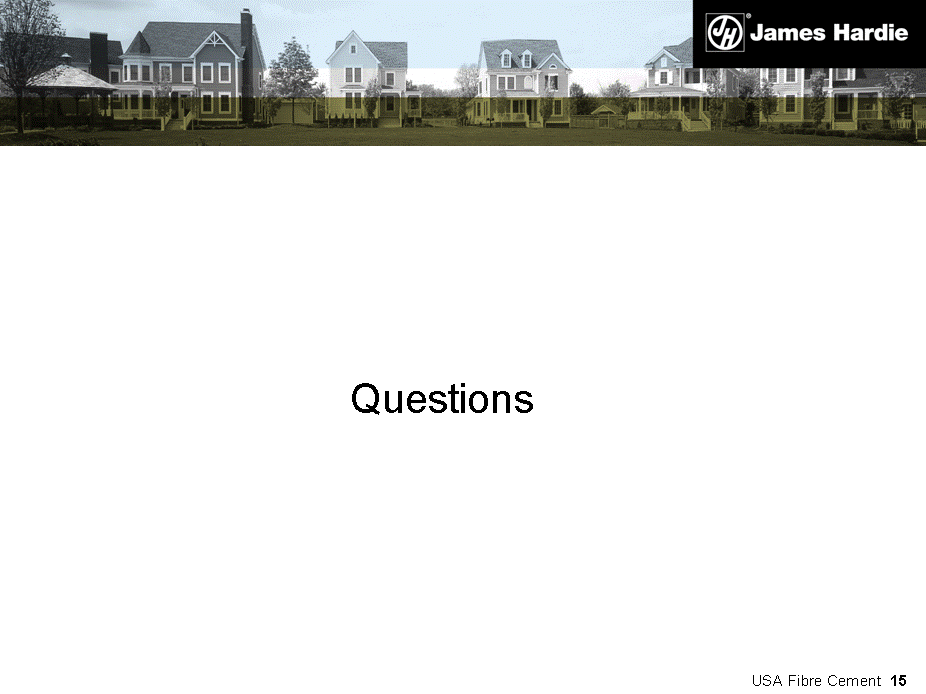
| Questions |
16
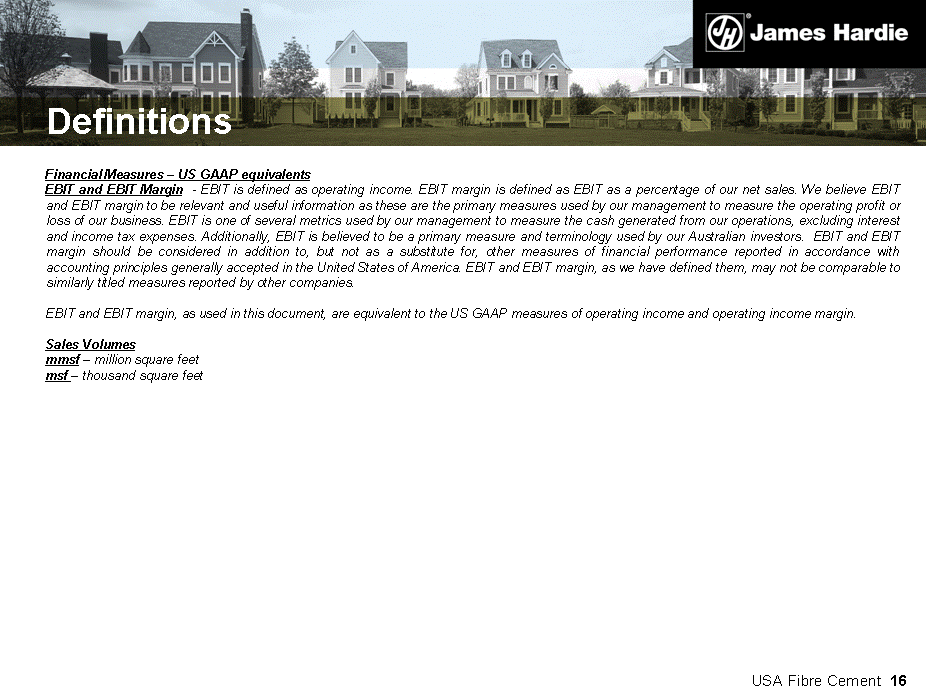
| Definitions Financial Measures - US GAAP equivalents EBIT and EBIT Margin - EBIT is defined as operating income. EBIT margin is defined as EBIT as a percentage of our net sales. We believe EBIT and EBIT margin to be relevant and useful information as these are the primary measures used by our management to measure the operating profit or loss of our business. EBIT is one of several metrics used by our management to measure the cash generated from our operations, excluding interest and income tax expenses. Additionally, EBIT is believed to be a primary measure and terminology used by our Australian investors. EBIT and EBIT margin should be considered in addition to, but not as a substitute for, other measures of financial performance reported in accordance with accounting principles generally accepted in the United States of America. EBIT and EBIT margin, as we have defined them, may not be comparable to similarly titled measures reported by other companies. EBIT and EBIT margin, as used in this document, are equivalent to the US GAAP measures of operating income and operating income margin. Sales Volumes mmsf - million square feet msf - thousand square feet |
17
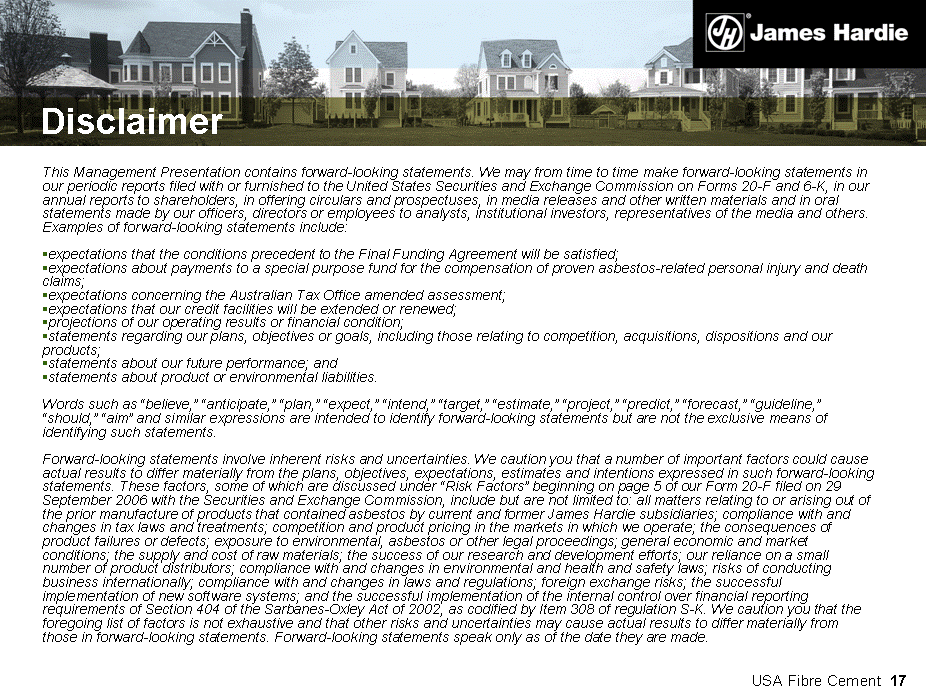
| Disclaimer This Management Presentation contains forward-looking statements. We may from time to time make forward-looking statements in our periodic reports filed with or furnished to the United States Securities and Exchange Commission on Forms 20-F and 6-K, in our annual reports to shareholders, in offering circulars and prospectuses, in media releases and other written materials and in oral statements made by our officers, directors or employees to analysts, institutional investors, representatives of the media and others. Examples of forward-looking statements include: expectations that the conditions precedent to the Final Funding Agreement will be satisfied; expectations about payments to a special purpose fund for the compensation of proven asbestos-related personal injury and death claims; expectations concerning the Australian Tax Office amended assessment; expectations that our credit facilities will be extended or renewed; projections of our operating results or financial condition; statements regarding our plans, objectives or goals, including those relating to competition, acquisitions, dispositions and our products; statements about our future performance; and statements about product or environmental liabilities. Words such as "believe," "anticipate," "plan," "expect," "intend," "target," "estimate," "project," "predict," "forecast," "guideline," "should," "aim" and similar expressions are intended to identify forward-looking statements but are not the exclusive means of identifying such statements. Forward-looking statements involve inherent risks and uncertainties. We caution you that a number of important factors could cause actual results to differ materially from the plans, objectives, expectations, estimates and intentions expressed in such forward-looking statements. These factors, some of which are discussed under "Risk Factors" beginning on page 5 of our Form 20-F filed on 29 September 2006 with the Securities and Exchange Commission, include but are not limited to: all matters relating to or arising out of the prior manufacture of products that contained asbestos by current and former James Hardie subsidiaries; compliance with and changes in tax laws and treatments; competition and product pricing in the markets in which we operate; the consequences of product failures or defects; exposure to environmental, asbestos or other legal proceedings; general economic and market conditions; the supply and cost of raw materials; the success of our research and development efforts; our reliance on a small number of product distributors; compliance with and changes in environmental and health and safety laws; risks of conducting business internationally; compliance with and changes in laws and regulations; foreign exchange risks; the successful implementation of new software systems; and the successful implementation of the internal control over financial reporting requirements of Section 404 of the Sarbanes-Oxley Act of 2002, as codified by Item 308 of regulation S-K. We caution you that the foregoing list of factors is not exhaustive and that other risks and uncertainties may cause actual results to differ materially from those in forward-looking statements. Forward-looking statements speak only as of the date they are made. |
18
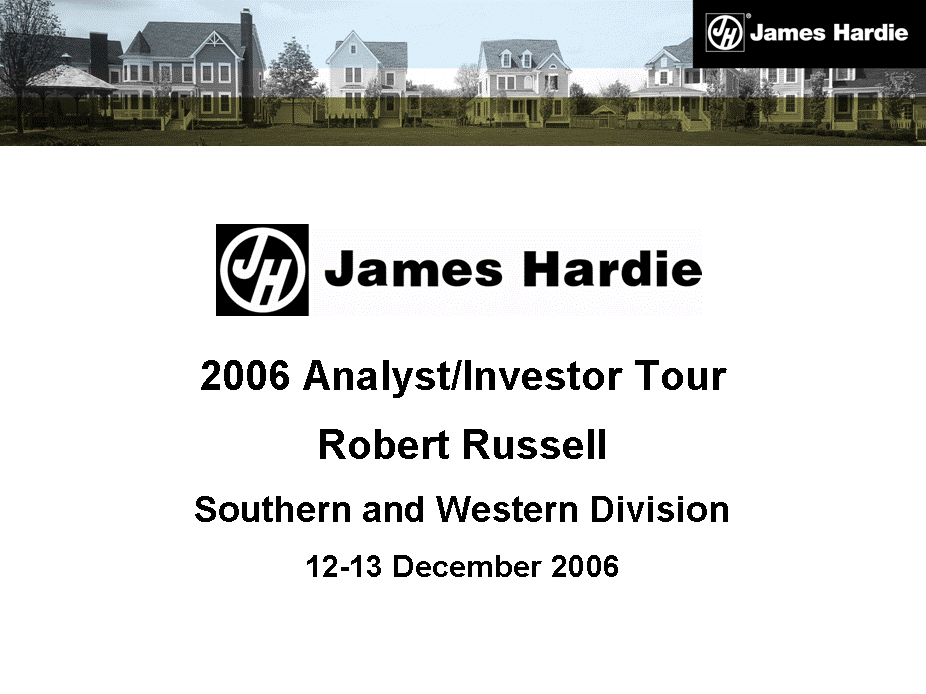
| [Name of presentation] [Your Name] 2006 Analyst/Investor Tour Robert Russell Southern and Western Division 12-13 December 2006 |
19
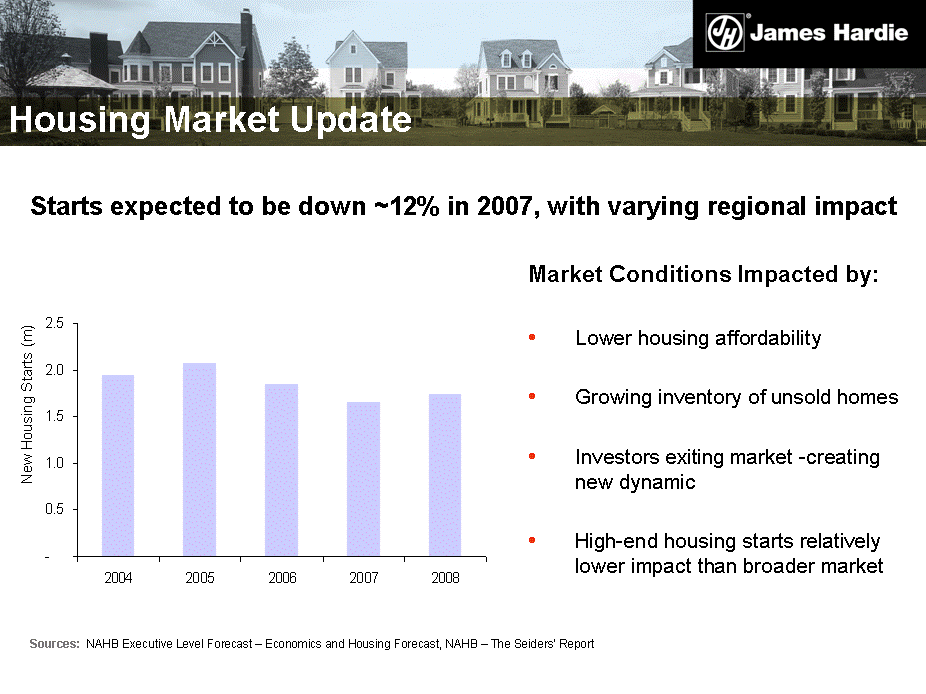
| Housing Market Update Starts expected to be down ~12% in 2007, with varying regional impact Market Conditions Impacted by: Lower housing affordability Growing inventory of unsold homes Investors exiting market -creating new dynamic High-end housing starts relatively lower impact than broader market Sources: NAHB Executive Level Forecast - Economics and Housing Forecast, NAHB - The Seiders' Report |
20

| Market Conditions - Historic Overview Market Conditions - Historic Overview |
21
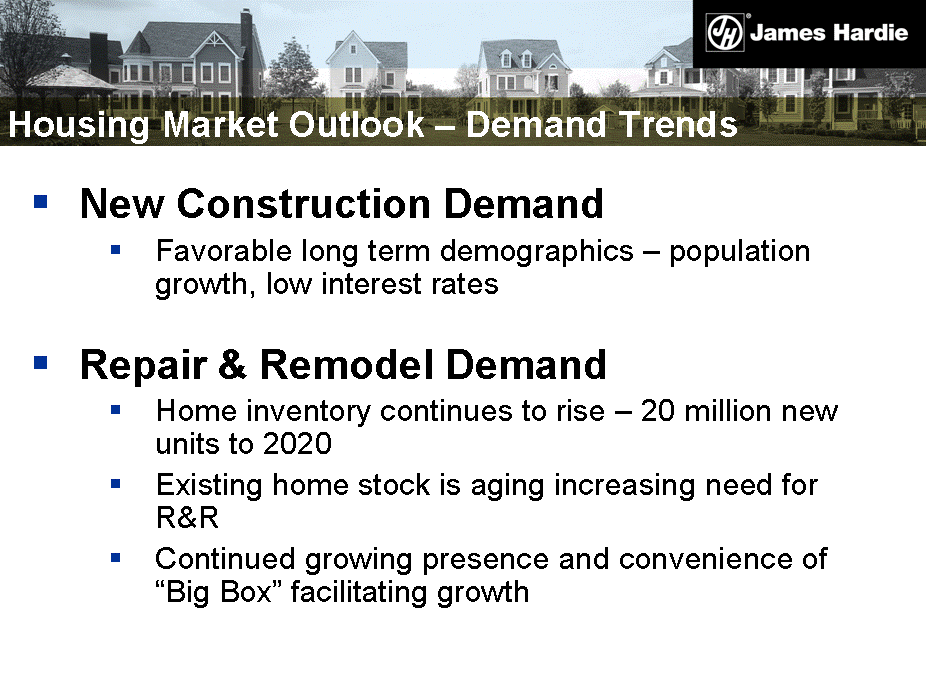
| Housing Market Outlook - Demand Trends New Construction Demand Favorable long term demographics - population growth, low interest rates Repair & Remodel Demand Home inventory continues to rise - 20 million new units to 2020 Existing home stock is aging increasing need for R&R Continued growing presence and convenience of "Big Box" facilitating growth Source: The State of the Nation's Housing - 2004, Joint Center for Housing Studies of Harvard University |
22
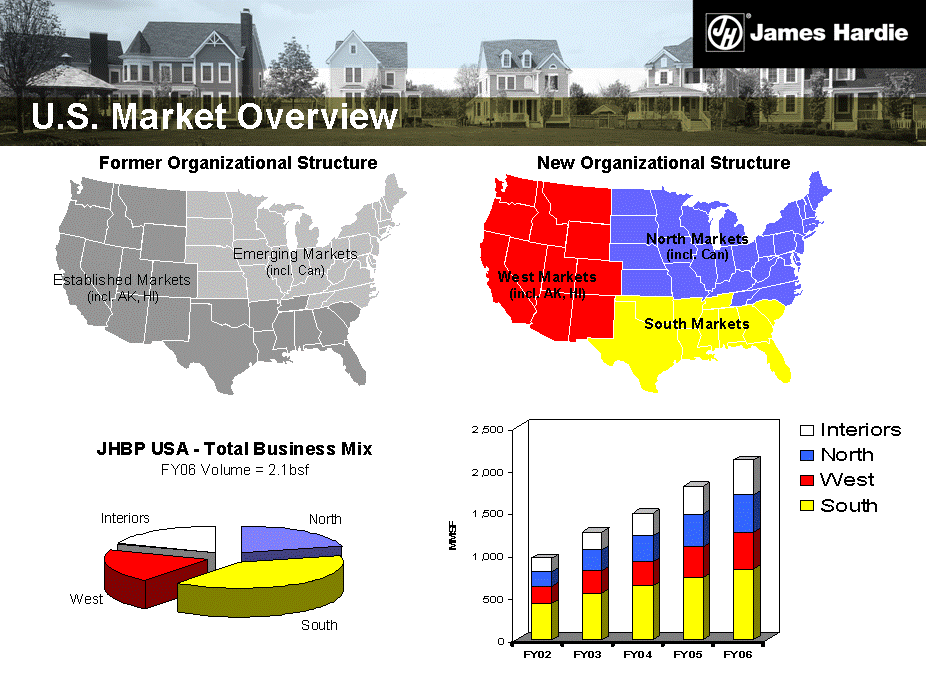
| U.S. Market Overview Former Organizational Structure New Organizational Structure Established Markets (incl. AK, HI) Emerging Markets (incl. Can) West Markets (incl. AK, HI) North Markets (incl. Can) South Markets |
23
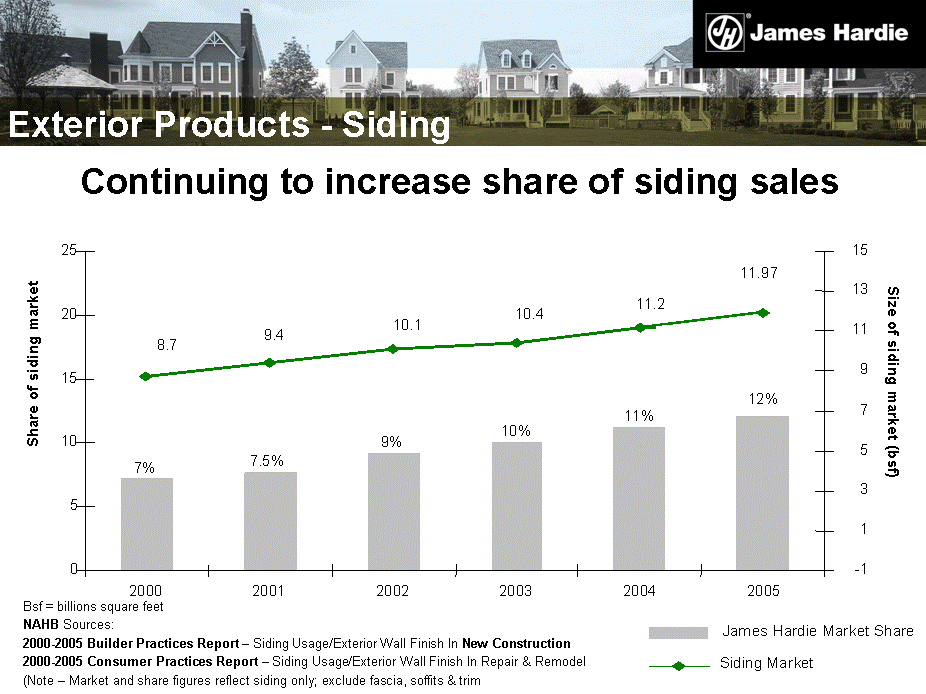
| Exterior Products - Siding Continuing to increase share of siding sales Bsf = billions square feet NAHB Sources: 2000-2005 Builder Practices Report - Siding Usage/Exterior Wall Finish In New Construction 2000-2005 Consumer Practices Report - Siding Usage/Exterior Wall Finish In Repair & Remodel (Note - Market and share figures reflect siding only; exclude fascia, soffits & trim 7% 7.5% 9% 10% 11% 12% 8.7 9.4 10.1 10.4 11.2 11.97 0 5 10 15 20 25 2000 2001 2002 2003 2004 2005 Share of siding market - -1 1 3 5 7 9 11 13 15 James Hardie Market Share Siding Market Size of siding market (bsf) |
24
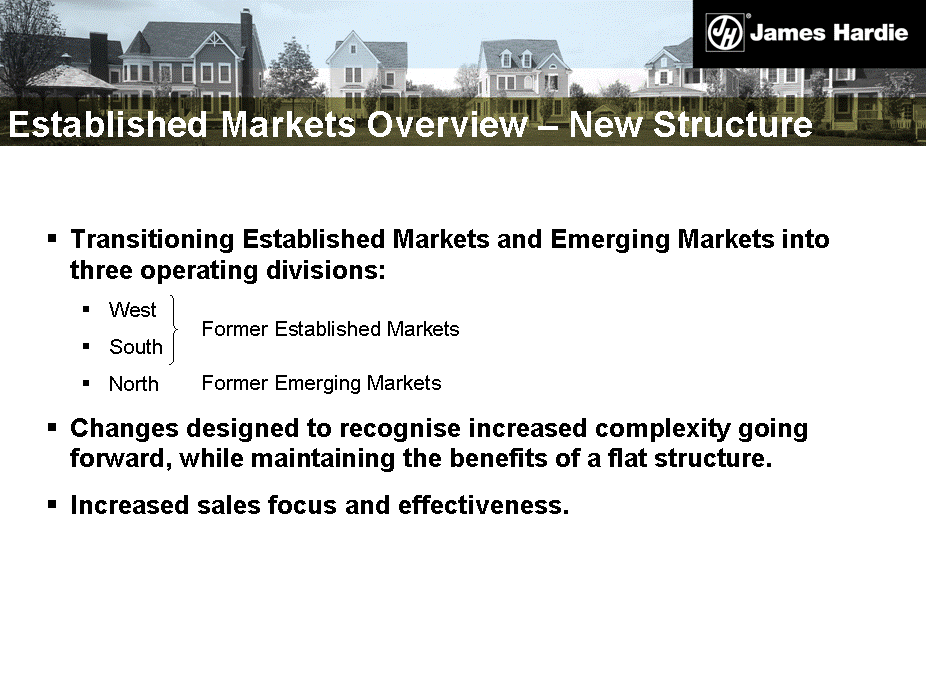
| Established Markets Overview - New Structure Transitioning Established Markets and Emerging Markets into three operating divisions: West South North Changes designed to recognise increased complexity going forward, while maintaining the benefits of a flat structure. Increased sales focus and effectiveness. Former Established Markets Former Emerging Markets |
25
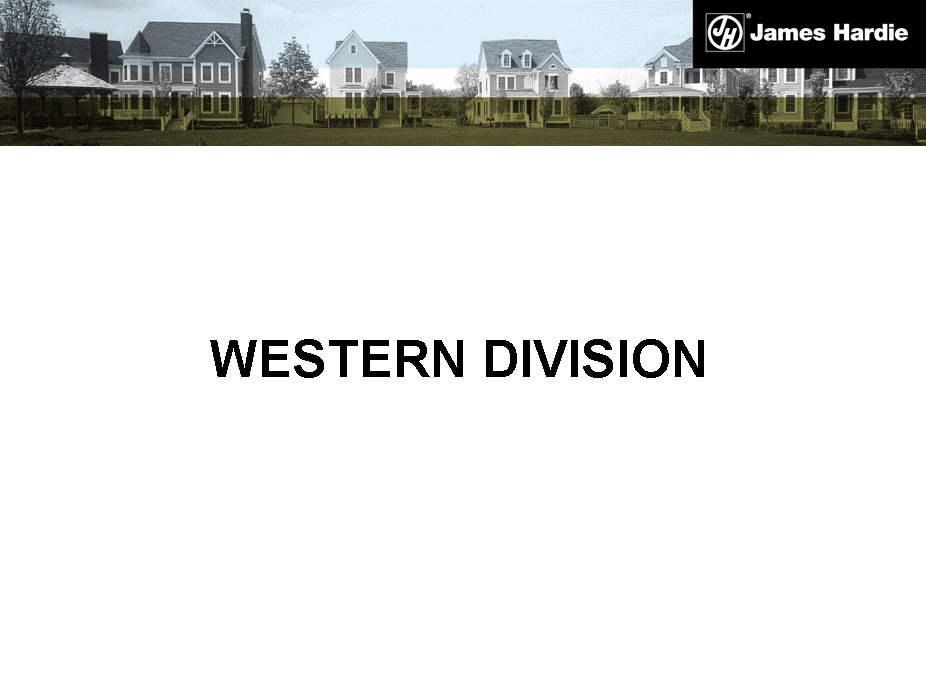
| WESTERN DIVISION |
26

| West - Market Overview West - Exteriors Division Map Pacific North West RSM Gary Fausset Southwest ASM Structure - - No Cal - - So Cal - - Denver PNW SW Total Population 14.6M 53.2M 67.8M Housing Starts 2006 115K 397K 511K Western Division Overview The Pacific Northwest remains structurally the same as we commence the launch of Color Plus in a heavily penetrated market. The restructuring of the Southwest Region involves a more focused market approach by desegregating the Region into three primary areas: 1. Northern California 2. Southern California 3. Denver |
27
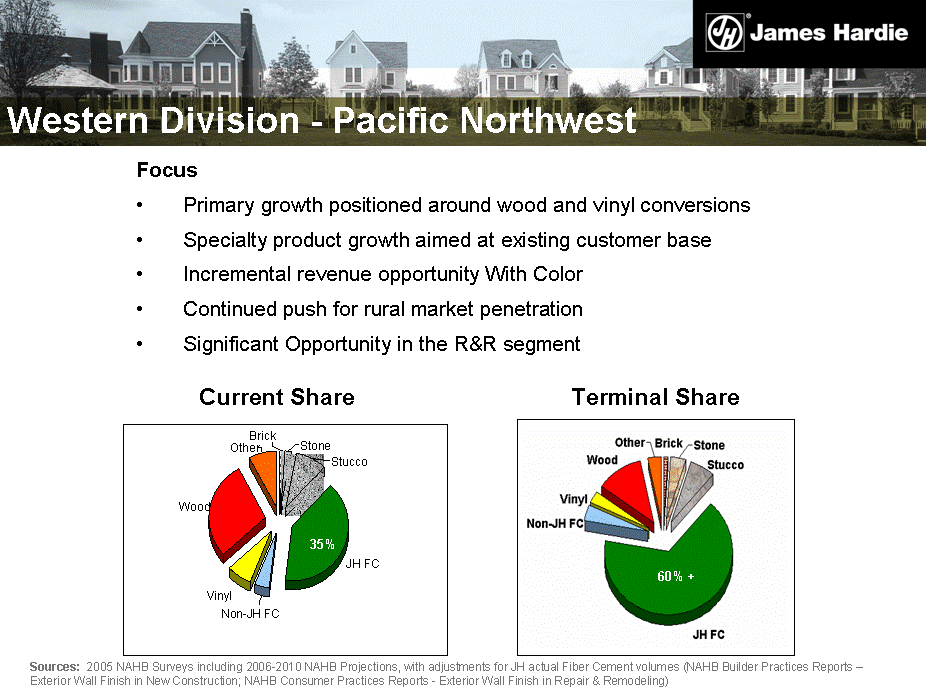
| Western Division - Pacific Northwest Focus Primary growth positioned around wood and vinyl conversions Specialty product growth aimed at existing customer base Incremental revenue opportunity With Color Continued push for rural market penetration Significant Opportunity in the R&R segment JH FC Vinyl Wood Non-JH FC Stucco Stone Brick Other 60% + Current Share Terminal Share Sources: 2005 NAHB Surveys including 2006-2010 NAHB Projections, with adjustments for JH actual Fiber Cement volumes (NAHB Builder Practices Reports - Exterior Wall Finish in New Construction; NAHB Consumer Practices Reports - Exterior Wall Finish in Repair & Remodeling) 35% |
28
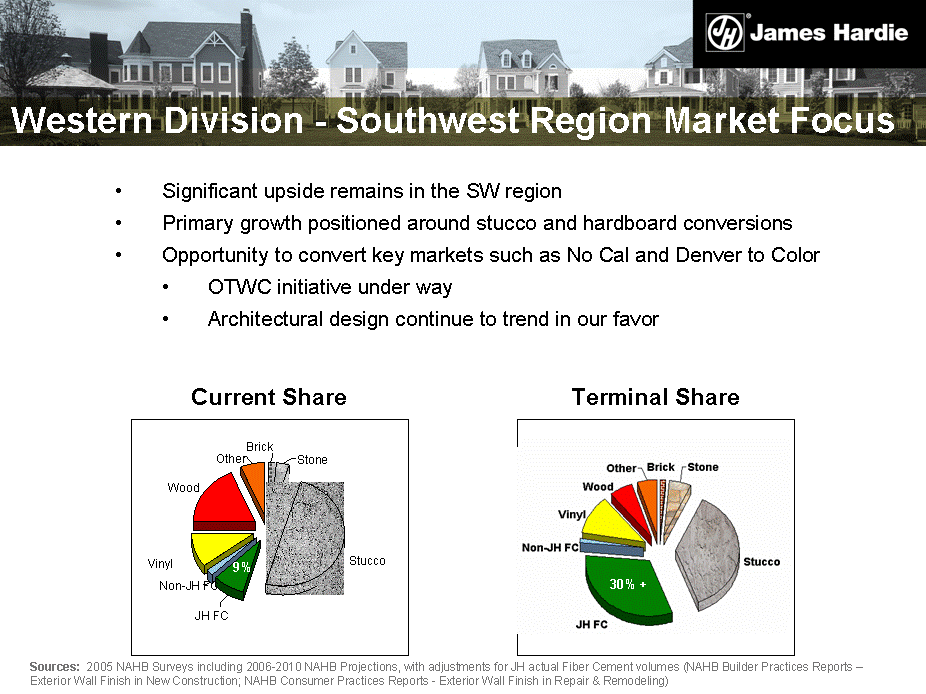
| Western Division - Southwest Region Market Focus Sources: 2005 NAHB Surveys including 2006-2010 NAHB Projections, with adjustments for JH actual Fiber Cement volumes (NAHB Builder Practices Reports - Exterior Wall Finish in New Construction; NAHB Consumer Practices Reports - Exterior Wall Finish in Repair & Remodeling) Significant upside remains in the SW region Primary growth positioned around stucco and hardboard conversions Opportunity to convert key markets such as No Cal and Denver to Color OTWC initiative under way Architectural design continue to trend in our favor Stucco Vinyl Wood Brick Stone Other JH FC Non-JH FC 32% Current Share Terminal Share 30% + 9% |
29

| SOUTHERN DIVISION |
30
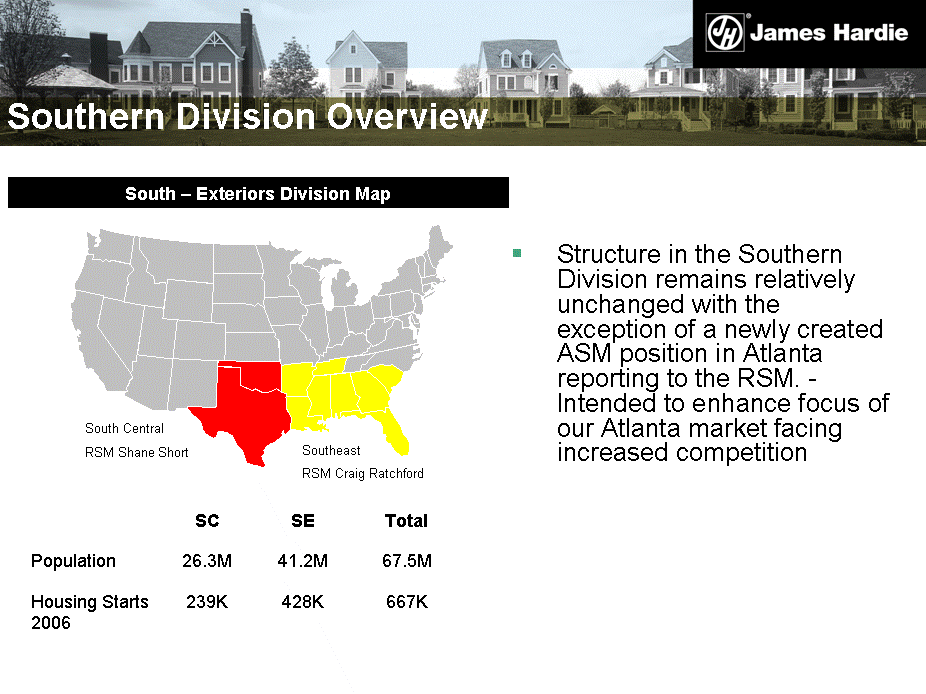
| West - Market Overview South - Exteriors Division Map South Central RSM Shane Short Southeast RSM Craig Ratchford SC SE Total Population 26.3M 41.2M 67.5M Housing Starts 2006 239K 428K 667K Structure in the Southern Division remains relatively unchanged with the exception of a newly created ASM position in Atlanta reporting to the RSM. - Intended to enhance focus of our Atlanta market facing increased competition Southern Division Overview |
31
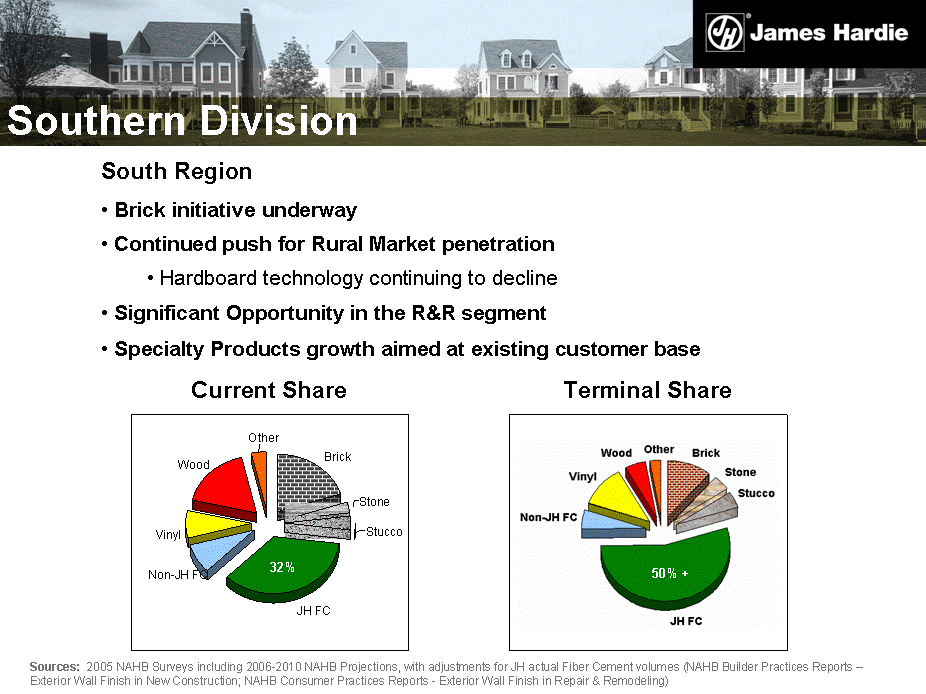
| Southern Division South Region Brick initiative underway Continued push for Rural Market penetration Hardboard technology continuing to decline Significant Opportunity in the R&R segment Specialty Products growth aimed at existing customer base Brick JH FC Non-JH FC Vinyl Wood Other Stucco Stone 50% + Current Share Terminal Share Sources: 2005 NAHB Surveys including 2006-2010 NAHB Projections, with adjustments for JH actual Fiber Cement volumes (NAHB Builder Practices Reports - Exterior Wall Finish in New Construction; NAHB Consumer Practices Reports - Exterior Wall Finish in Repair & Remodeling) 32% |
32
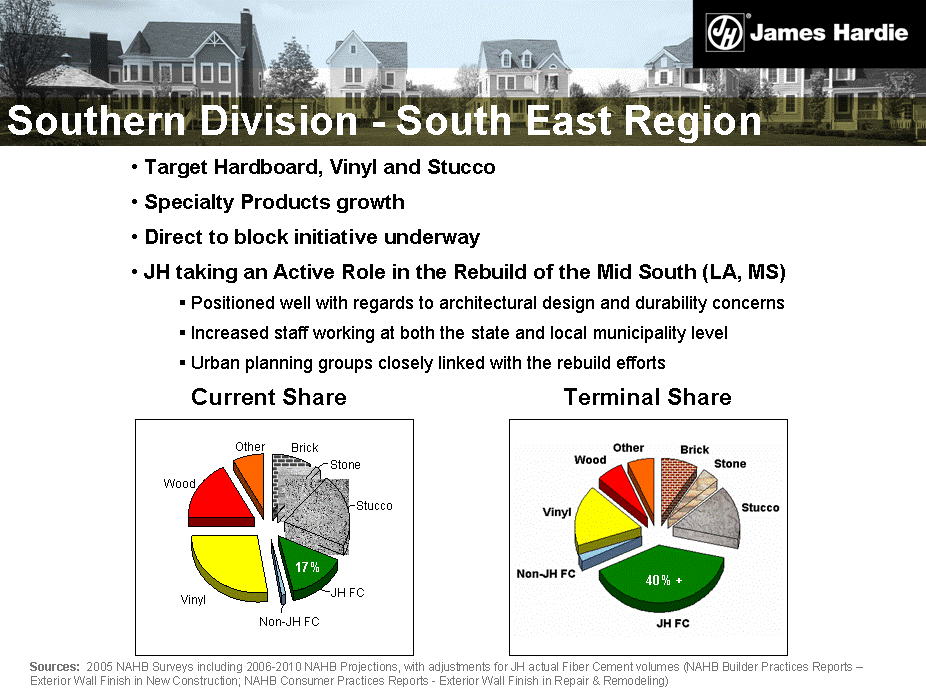
| Southern Division - South East Region Target Hardboard, Vinyl and Stucco Specialty Products growth Direct to block initiative underway JH taking an Active Role in the Rebuild of the Mid South (LA, MS) Positioned well with regards to architectural design and durability concerns Increased staff working at both the state and local municipality level Urban planning groups closely linked with the rebuild efforts Brick Vinyl Wood Other Stone Non-JH FC JH FC Stucco 40% + Current Share Terminal Share Sources: 2005 NAHB Surveys including 2006-2010 NAHB Projections, with adjustments for JH actual Fiber Cement volumes (NAHB Builder Practices Reports - Exterior Wall Finish in New Construction; NAHB Consumer Practices Reports - Exterior Wall Finish in Repair & Remodeling) 17% |
33
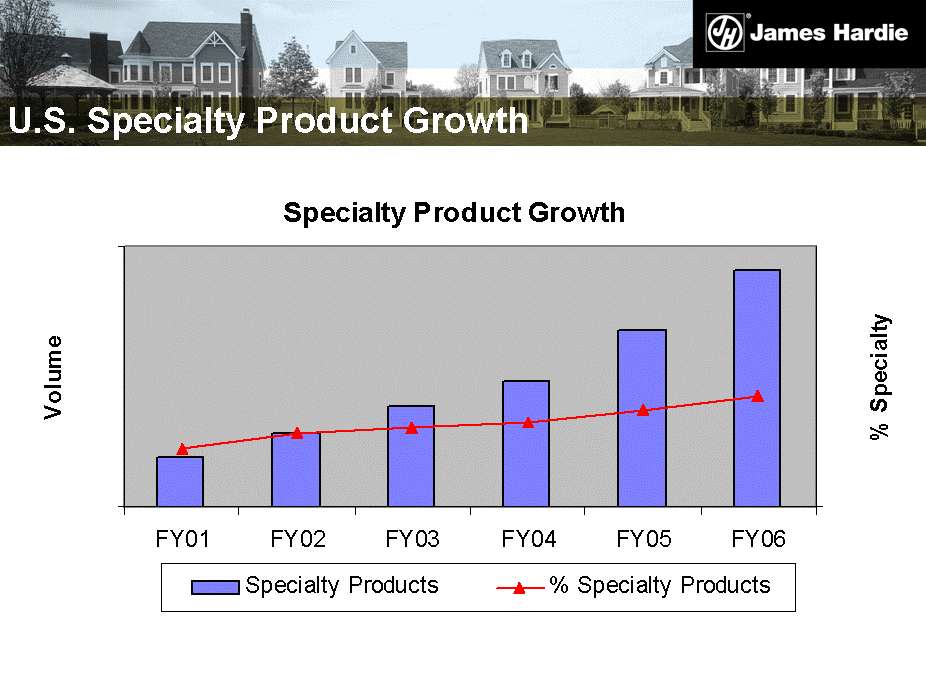
| U.S. Specialty Product Growth |
34

| Competitor Overview MAXI Overview Largest share of fiber cement panel segment in Japan Specialty siding products and trim accents Shake, brick and stone textures U.S. distribution through Nichiha USA Inc., Atlanta GA Sells through loose dealer network. Announced First U.S. mfg. plant in Macon, GA; scheduled on-line late 2007 [Insert comment] Division of Saint Gobain - Multinational mfr. building materials, glass, high- performance materials; No.1 bldg. materials distributor in Europe; HQ France Construction Products Business Sector includes Insulation, Pipe, Industrial Mortars, Gypsum products, Exterior Products including vinyl & FC siding Two fiber cement siding plants in Roaring River, NC and White City, OR Recently announced plans to build a third FC plant in Terre haute, IN; 2007 Mexalit - manufacturer of Maxi products in Mexico, including siding & pipe Constructing a plant in Nuevo Laredo, Mexico. History of sales into Texas up to PNW (est.<1% share) Observations suggest the plant 50%+ complete; likely operational in 2007 |
35
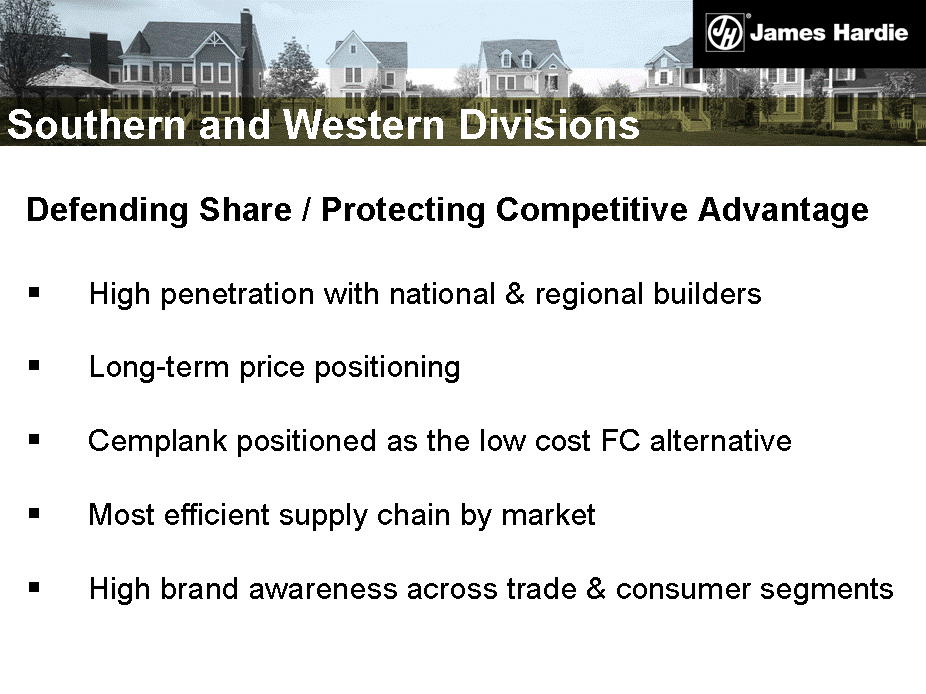
| Defending Share / Protecting Competitive Advantage High penetration with national & regional builders Long-term price positioning Cemplank positioned as the low cost FC alternative Most efficient supply chain by market High brand awareness across trade & consumer segments Southern and Western Divisions |
36
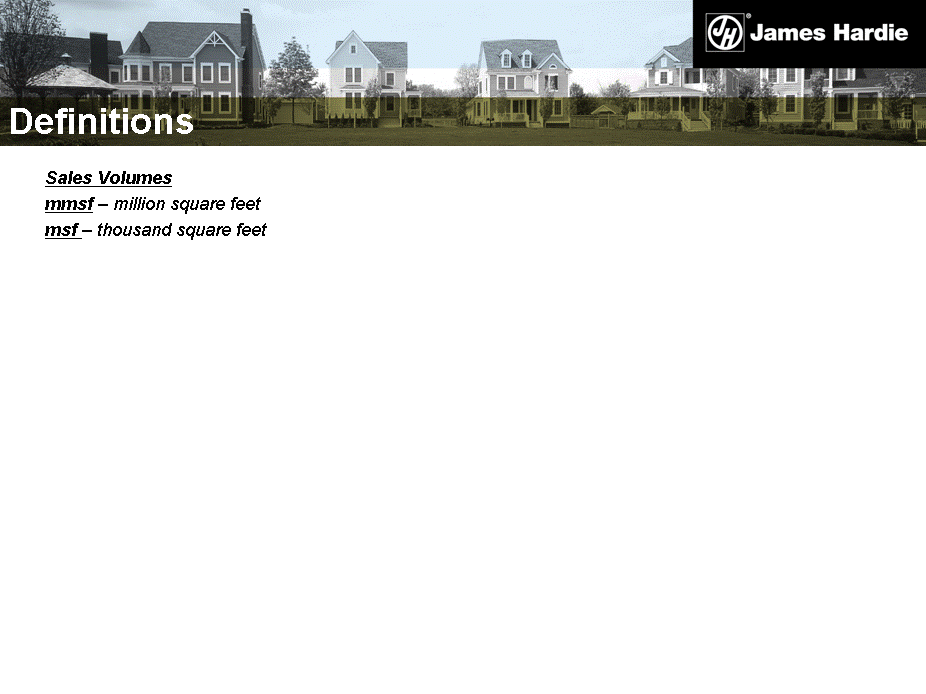
| Sales Volumes mmsf - million square feet msf - thousand square feet Definitions |
37

| Disclaimer This Management Presentation contains forward-looking statements. We may from time to time make forward-looking statements in our periodic reports filed with or furnished to the United States Securities and Exchange Commission on Forms 20-F and 6-K, in our annual reports to shareholders, in offering circulars and prospectuses, in media releases and other written materials and in oral statements made by our officers, directors or employees to analysts, institutional investors, representatives of the media and others. Examples of forward-looking statements include: expectations that the conditions precedent to the Final Funding Agreement will be satisfied; expectations about payments to a special purpose fund for the compensation of proven asbestos-related personal injury and death claims; expectations concerning the Australian Tax Office amended assessment; expectations that our credit facilities will be extended or renewed; projections of our operating results or financial condition; statements regarding our plans, objectives or goals, including those relating to competition, acquisitions, dispositions and our products; statements about our future performance; and statements about product or environmental liabilities. Words such as "believe," "anticipate," "plan," "expect," "intend," "target," "estimate," "project," "predict," "forecast," "guideline," "should," "aim" and similar expressions are intended to identify forward-looking statements but are not the exclusive means of identifying such statements. Forward-looking statements involve inherent risks and uncertainties. We caution you that a number of important factors could cause actual results to differ materially from the plans, objectives, expectations, estimates and intentions expressed in such forward-looking statements. These factors, some of which are discussed under "Risk Factors" beginning on page 5 of our Form 20-F filed on 29 September 2006 with the Securities and Exchange Commission, include but are not limited to: all matters relating to or arising out of the prior manufacture of products that contained asbestos by current and former James Hardie subsidiaries; compliance with and changes in tax laws and treatments; competition and product pricing in the markets in which we operate; the consequences of product failures or defects; exposure to environmental, asbestos or other legal proceedings; general economic and market conditions; the supply and cost of raw materials; the success of our research and development efforts; our reliance on a small number of product distributors; compliance with and changes in environmental and health and safety laws; risks of conducting business internationally; compliance with and changes in laws and regulations; foreign exchange risks; the successful implementation of new software systems; and the successful implementation of the internal control over financial reporting requirements of Section 404 of the Sarbanes-Oxley Act of 2002, as codified by Item 308 of regulation S-K. We caution you that the foregoing list of factors is not exhaustive and that other risks and uncertainties may cause actual results to differ materially from those in forward-looking statements. Forward-looking statements speak only as of the date they are made. |
38
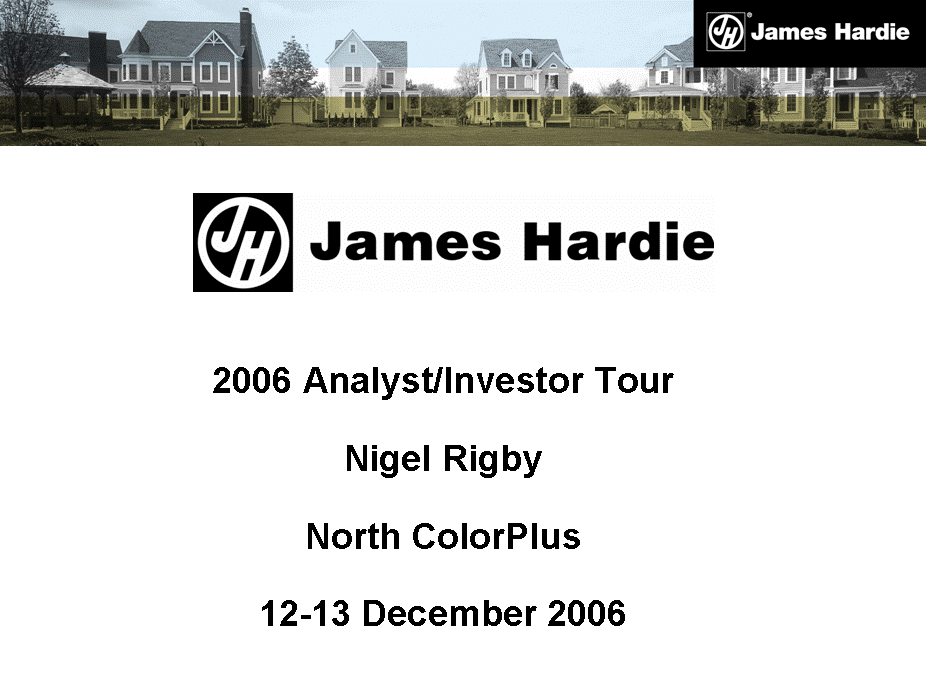
| 2006 Analyst/Investor Tour Nigel Rigby North ColorPlus 12-13 December 2006 |
39
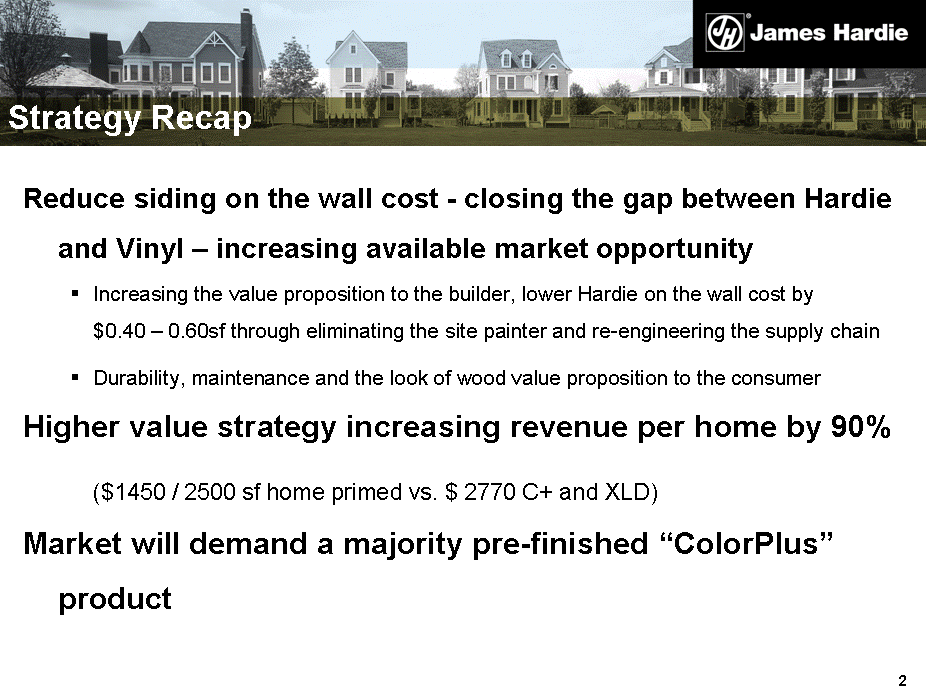
| Reduce siding on the wall cost - closing the gap between Hardie and Vinyl - increasing available market opportunity Increasing the value proposition to the builder, lower Hardie on the wall cost by $0.40 - 0.60sf through eliminating the site painter and re-engineering the supply chain Durability, maintenance and the look of wood value proposition to the consumer Higher value strategy increasing revenue per home by 90% ($1450 / 2500 sf home primed vs. $ 2770 C+ and XLD) Market will demand a majority pre-finished "ColorPlus" product Strategy Recap |
40
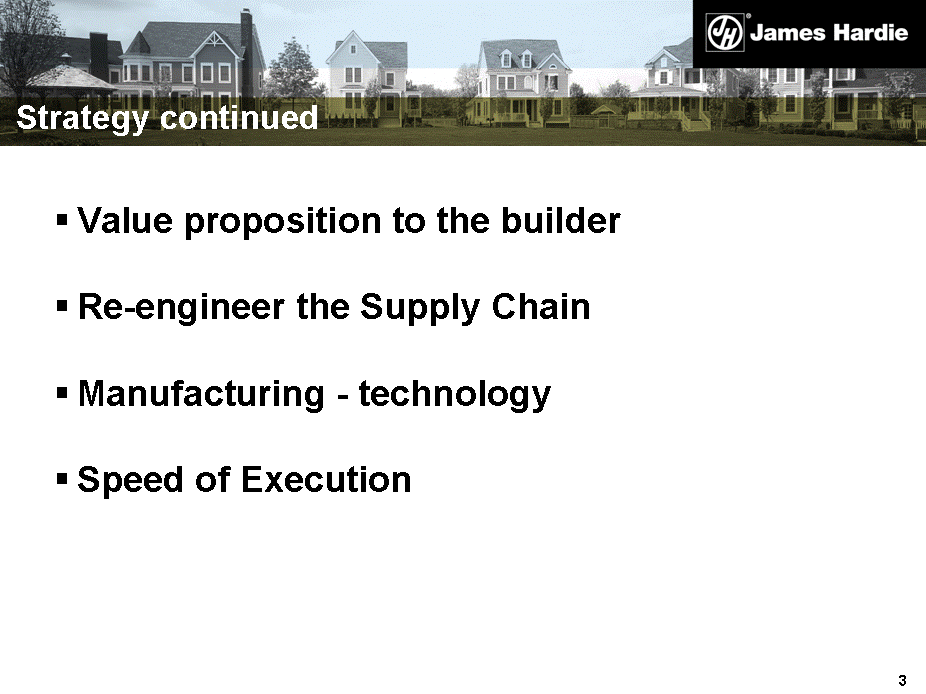
| Strategy continued Value proposition to the builder Re-engineer the Supply Chain Manufacturing - technology Speed of Execution |
41
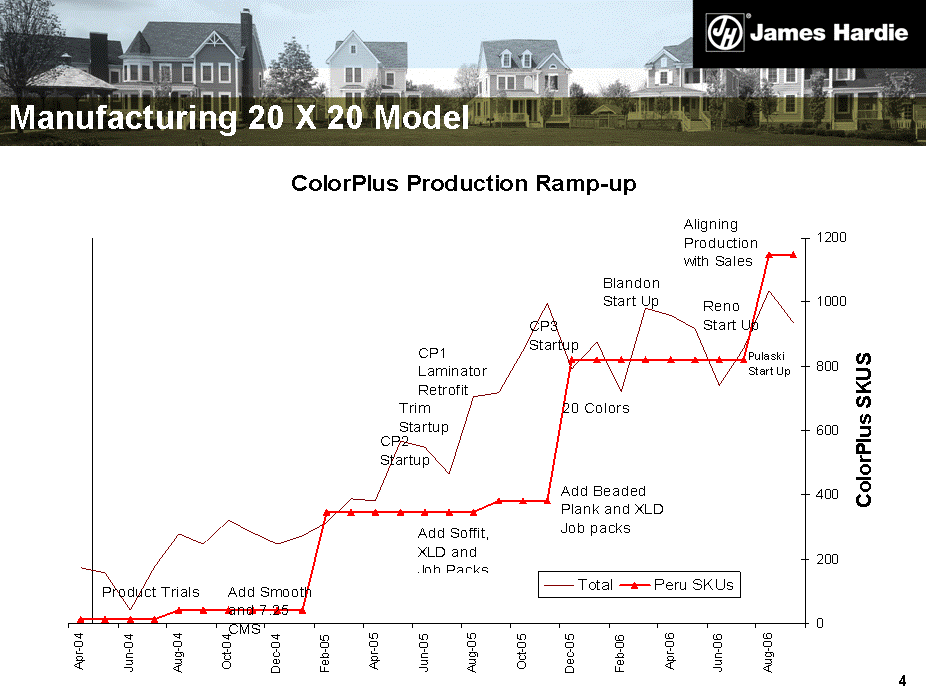
| Manufacturing 20 X 20 Model |
42

| ColorPlus Capacity * Does not include ColorPlus Trim capacity Blandon, PA Peru, IL Reno, NV Pulaski, VA |
43
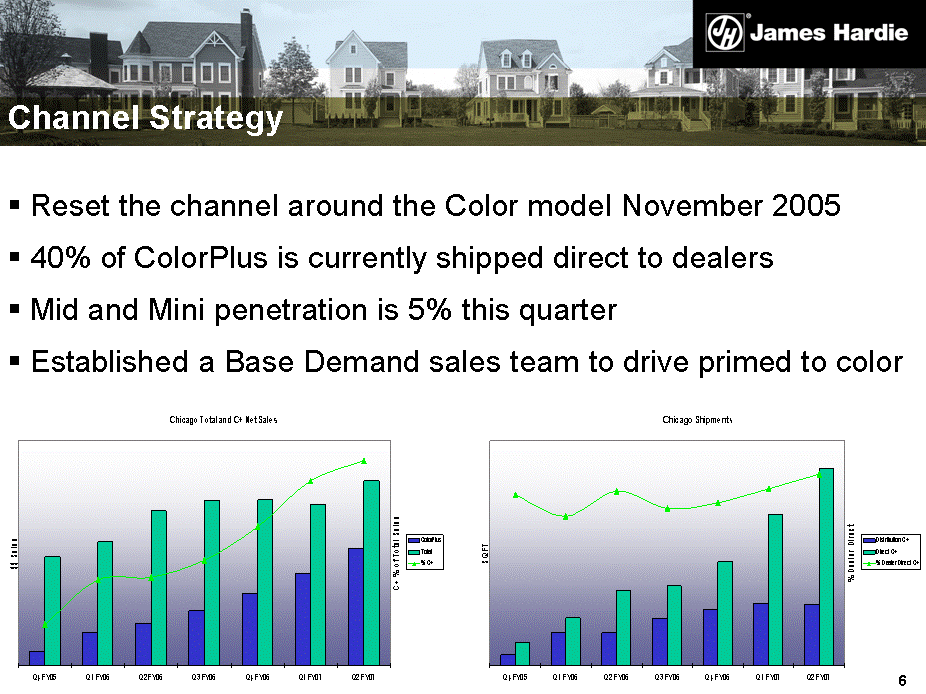
| Reset the channel around the Color model November 2005 40% of ColorPlus is currently shipped direct to dealers Mid and Mini penetration is 5% this quarter Established a Base Demand sales team to drive primed to color Channel Strategy |
44
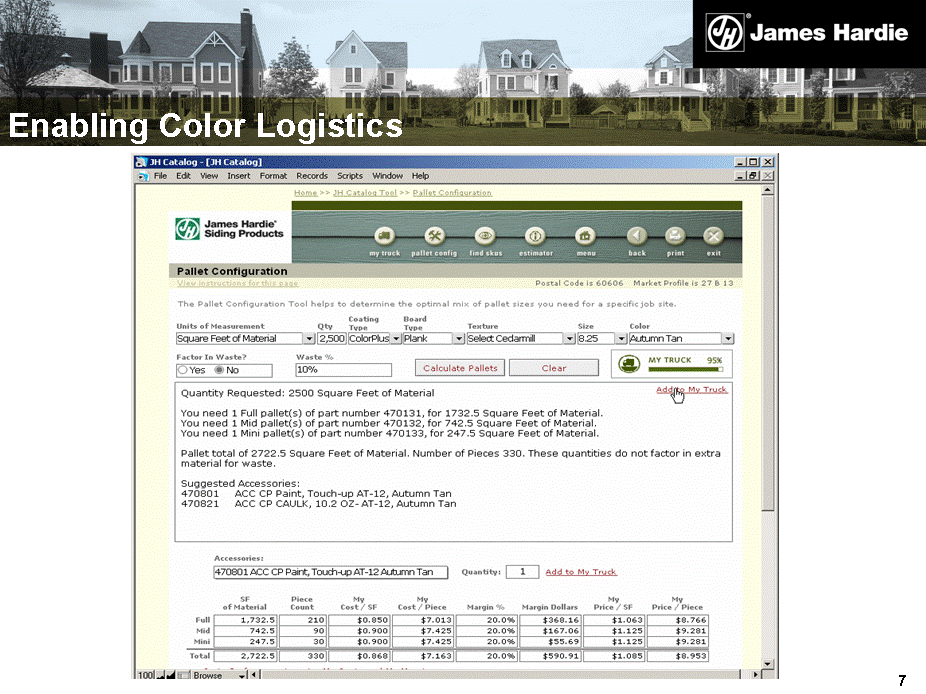
| Enabling Color Logistics Enabling Color Logistics |
45

| Service internal standards are currently higher than the market commitment as we move through the learning curve Service |
46
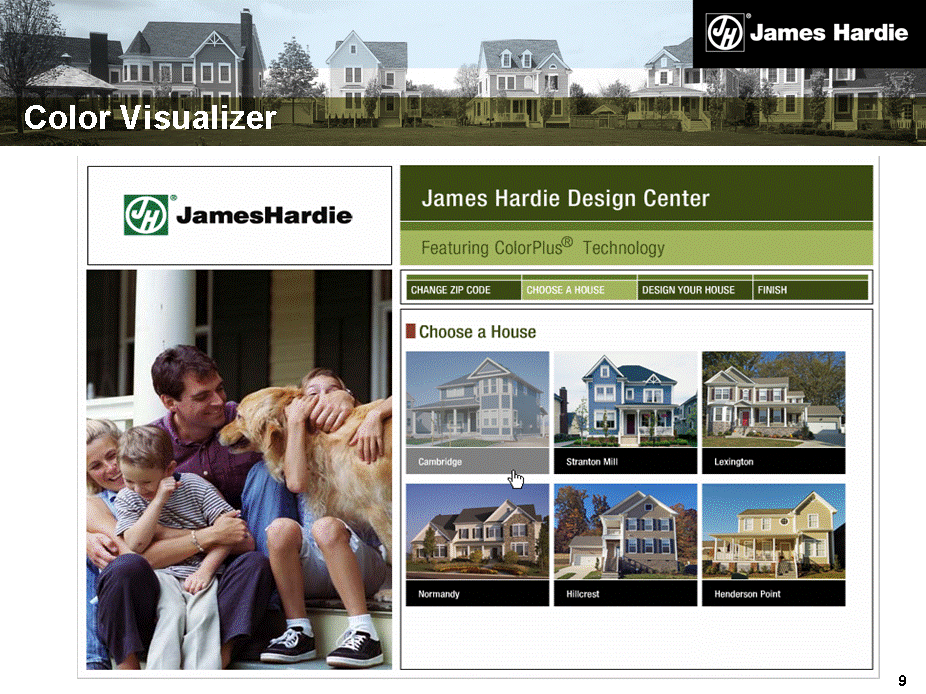
| Color Visualizer |
47
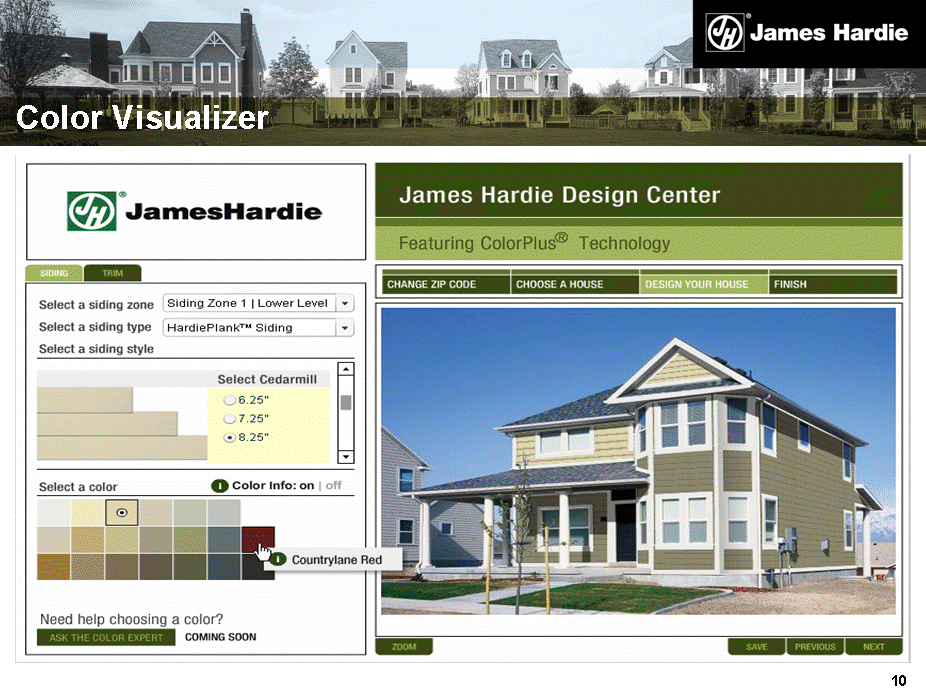
| Color Visualizer Color Visualizer |
48
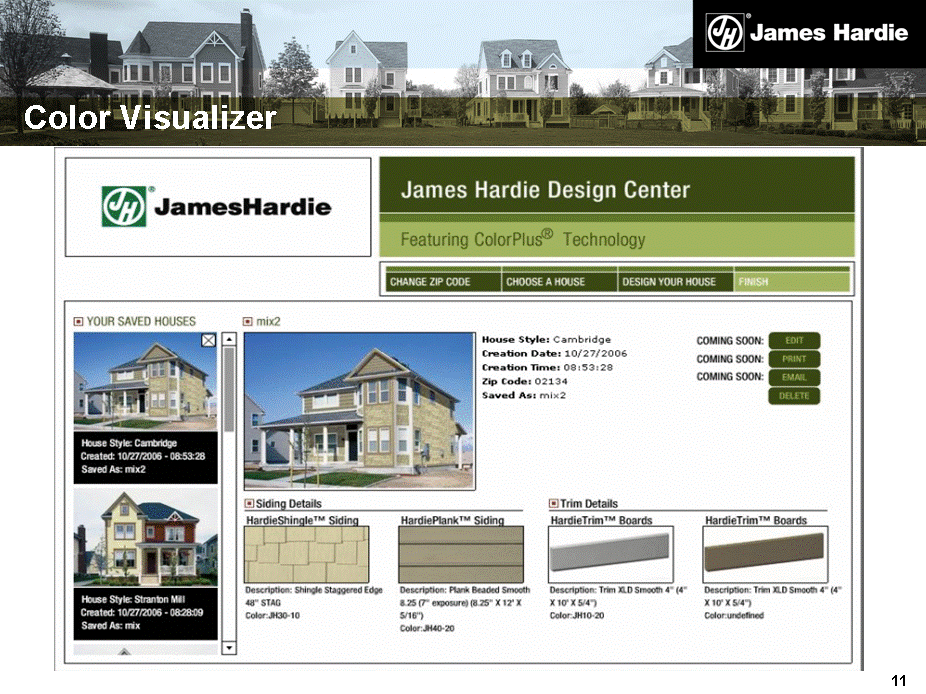
| Color Visualizer Color Visualizer |
49
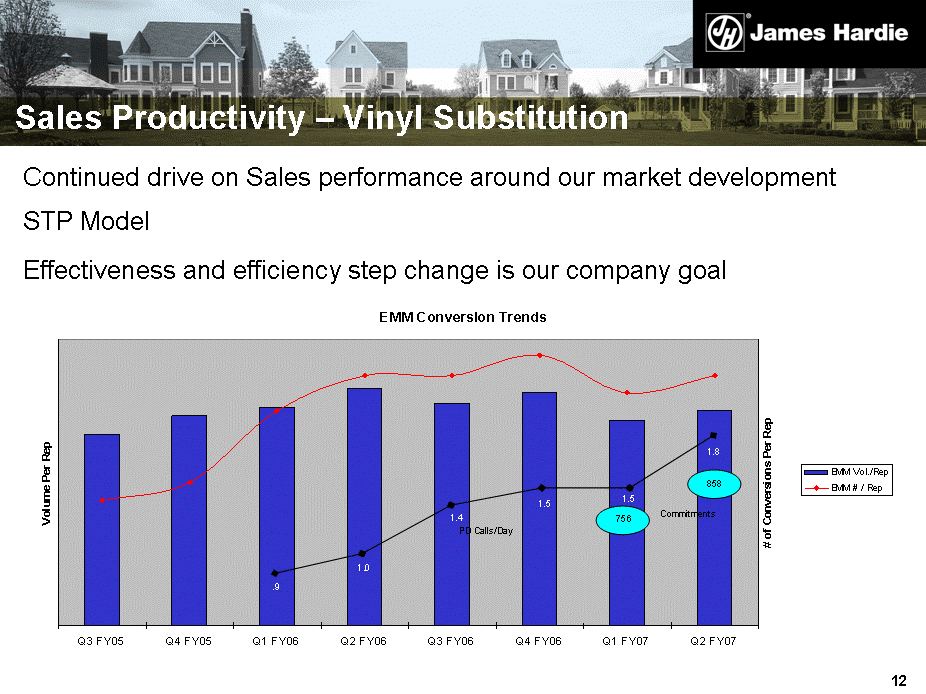
| Continued drive on Sales performance around our market development STP Model Effectiveness and efficiency step change is our company goal Sales Productivity - Vinyl Substitution |
50

| ColorPlus Sales Performance ColorPlus Sales Performance |
51
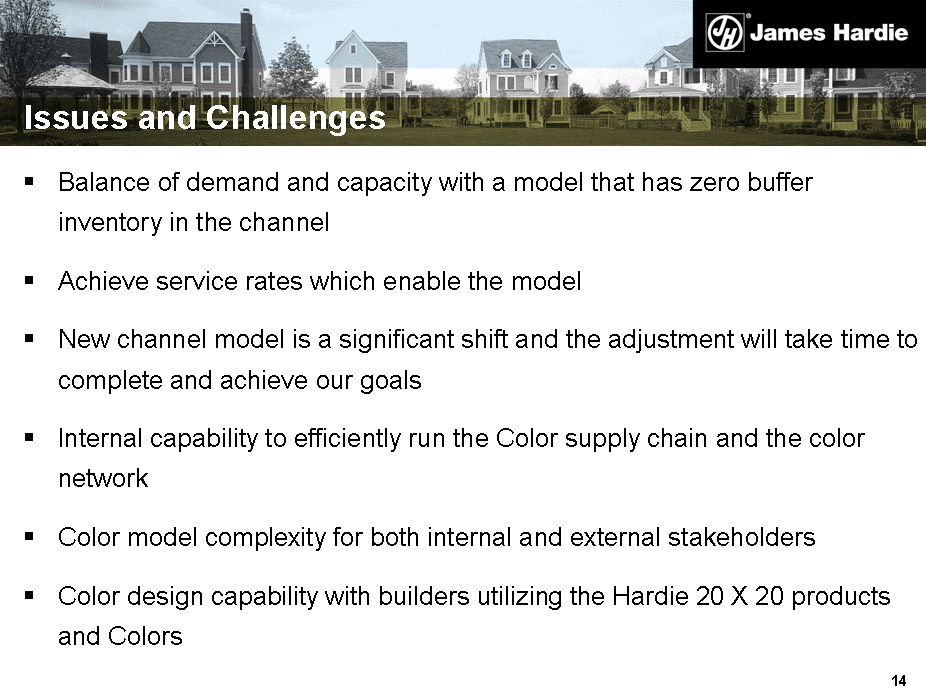
| Balance of demand and capacity with a model that has zero buffer inventory in the channel Achieve service rates which enable the model New channel model is a significant shift and the adjustment will take time to complete and achieve our goals Internal capability to efficiently run the Color supply chain and the color network Color model complexity for both internal and external stakeholders Color design capability with builders utilizing the Hardie 20 X 20 products and Colors Issues and Challenges |
52
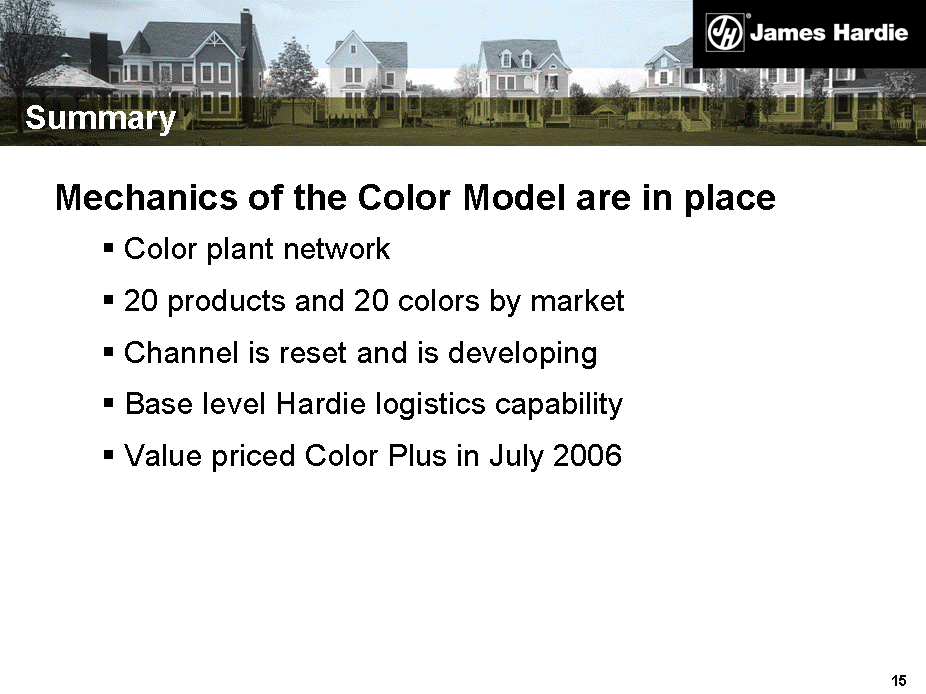
| Mechanics of the Color Model are in place Color plant network 20 products and 20 colors by market Channel is reset and is developing Base level Hardie logistics capability Value priced Color Plus in July 2006 Summary |
53
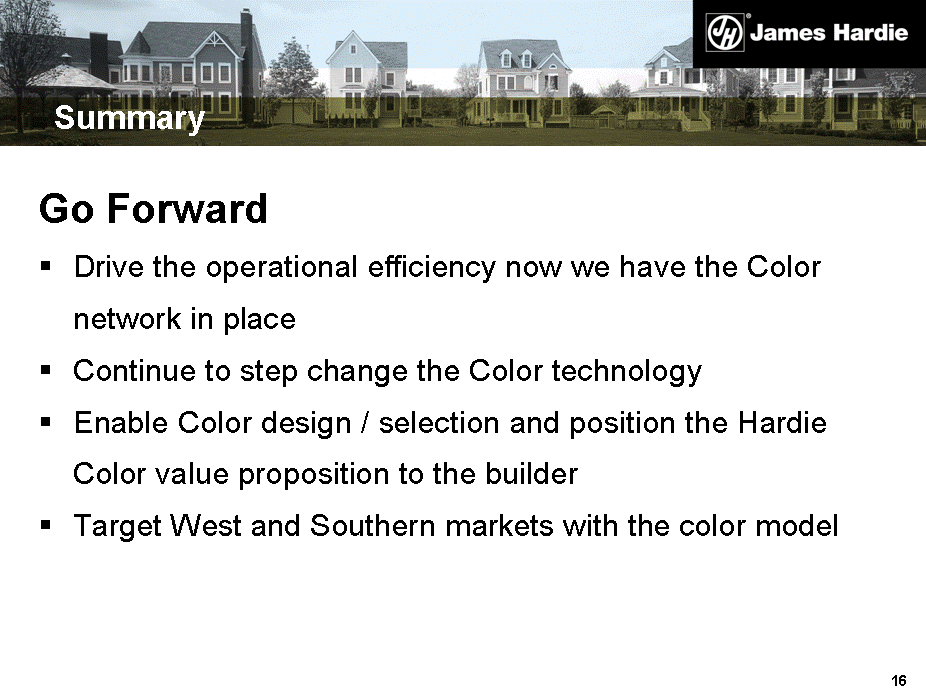
| Go Forward Drive the operational efficiency now we have the Color network in place Continue to step change the Color technology Enable Color design / selection and position the Hardie Color value proposition to the builder Target West and Southern markets with the color model Summary |
54
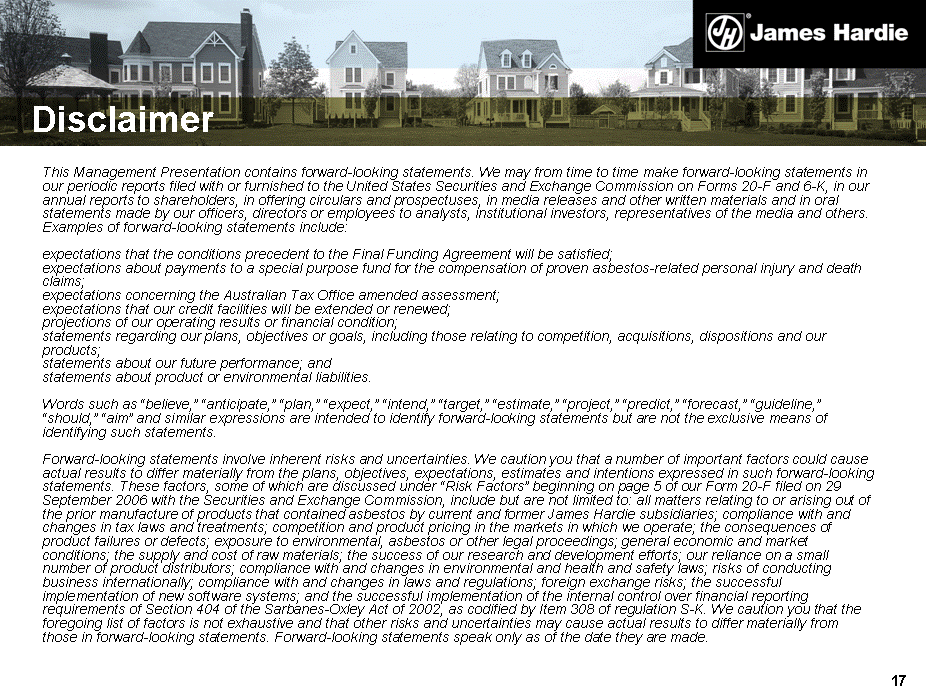
| This Management Presentation contains forward-looking statements. We may from time to time make forward-looking statements in our periodic reports filed with or furnished to the United States Securities and Exchange Commission on Forms 20-F and 6-K, in our annual reports to shareholders, in offering circulars and prospectuses, in media releases and other written materials and in oral statements made by our officers, directors or employees to analysts, institutional investors, representatives of the media and others. Examples of forward-looking statements include: expectations that the conditions precedent to the Final Funding Agreement will be satisfied; expectations about payments to a special purpose fund for the compensation of proven asbestos-related personal injury and death claims; expectations concerning the Australian Tax Office amended assessment; expectations that our credit facilities will be extended or renewed; projections of our operating results or financial condition; statements regarding our plans, objectives or goals, including those relating to competition, acquisitions, dispositions and our products; statements about our future performance; and statements about product or environmental liabilities. Words such as "believe," "anticipate," "plan," "expect," "intend," "target," "estimate," "project," "predict," "forecast," "guideline," "should," "aim" and similar expressions are intended to identify forward-looking statements but are not the exclusive means of identifying such statements. Forward-looking statements involve inherent risks and uncertainties. We caution you that a number of important factors could cause actual results to differ materially from the plans, objectives, expectations, estimates and intentions expressed in such forward-looking statements. These factors, some of which are discussed under "Risk Factors" beginning on page 5 of our Form 20-F filed on 29 September 2006 with the Securities and Exchange Commission, include but are not limited to: all matters relating to or arising out of the prior manufacture of products that contained asbestos by current and former James Hardie subsidiaries; compliance with and changes in tax laws and treatments; competition and product pricing in the markets in which we operate; the consequences of product failures or defects; exposure to environmental, asbestos or other legal proceedings; general economic and market conditions; the supply and cost of raw materials; the success of our research and development efforts; our reliance on a small number of product distributors; compliance with and changes in environmental and health and safety laws; risks of conducting business internationally; compliance with and changes in laws and regulations; foreign exchange risks; the successful implementation of new software systems; and the successful implementation of the internal control over financial reporting requirements of Section 404 of the Sarbanes-Oxley Act of 2002, as codified by Item 308 of regulation S-K. We caution you that the foregoing list of factors is not exhaustive and that other risks and uncertainties may cause actual results to differ materially from those in forward-looking statements. Forward-looking statements speak only as of the date they are made. Disclaimer |
55
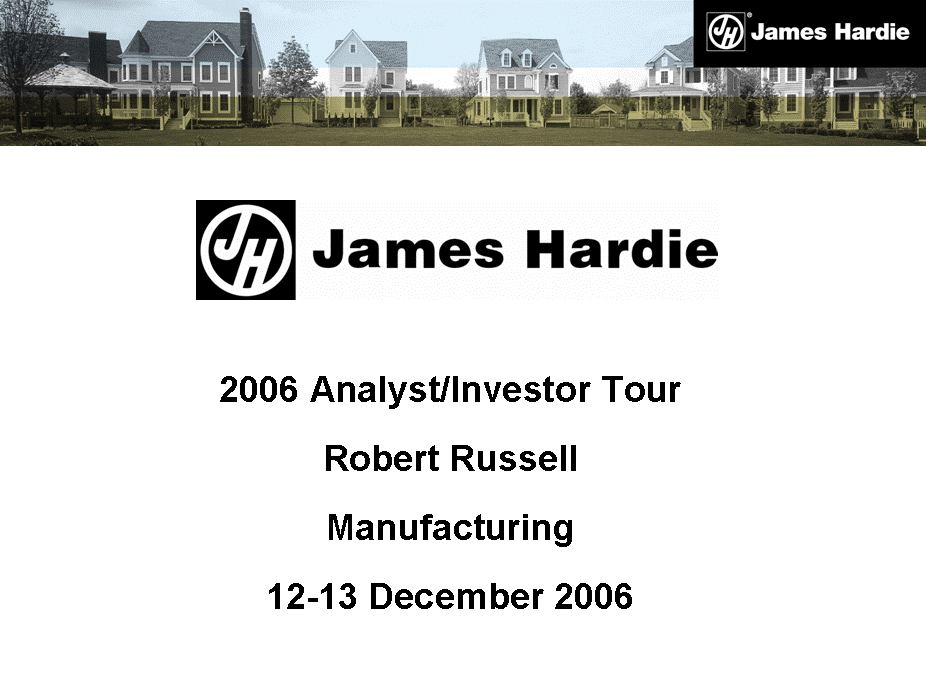
| 2006 Analyst/Investor Tour Robert Russell Manufacturing 12-13 December 2006 |
56
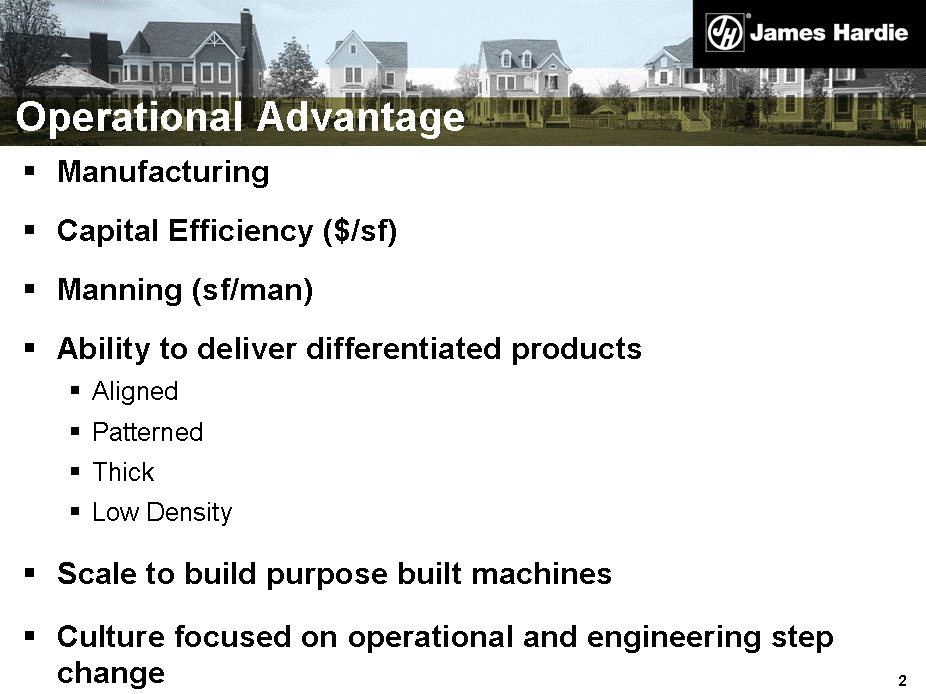
| Operational Advantage Manufacturing Capital Efficiency ($/sf) Manning (sf/man) Ability to deliver differentiated products Aligned Patterned Thick Low Density Scale to build purpose built machines Culture focused on operational and engineering step change |
57

| Evolution of Equipment Hatschek Forming 1917 - First machine purchased from Swiss Eternit 1980's - JH standardizes around 4'wide x 2 or 3 tub machines Mid 1980's to Present - JH pushes equipment design envelope |
58
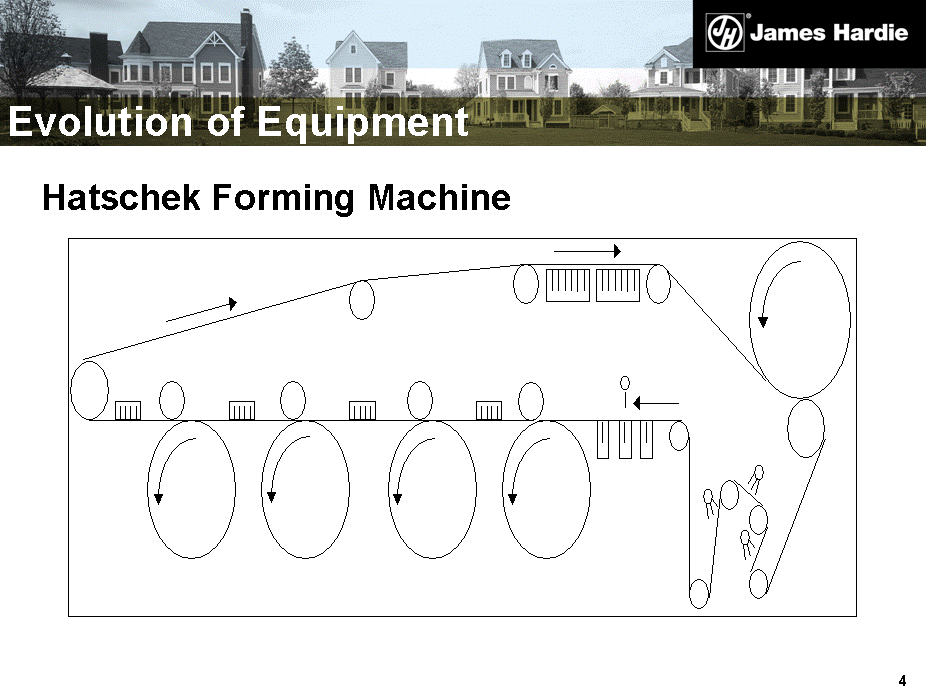
| Evolution of Equipment Hatschek Forming Machine |
59
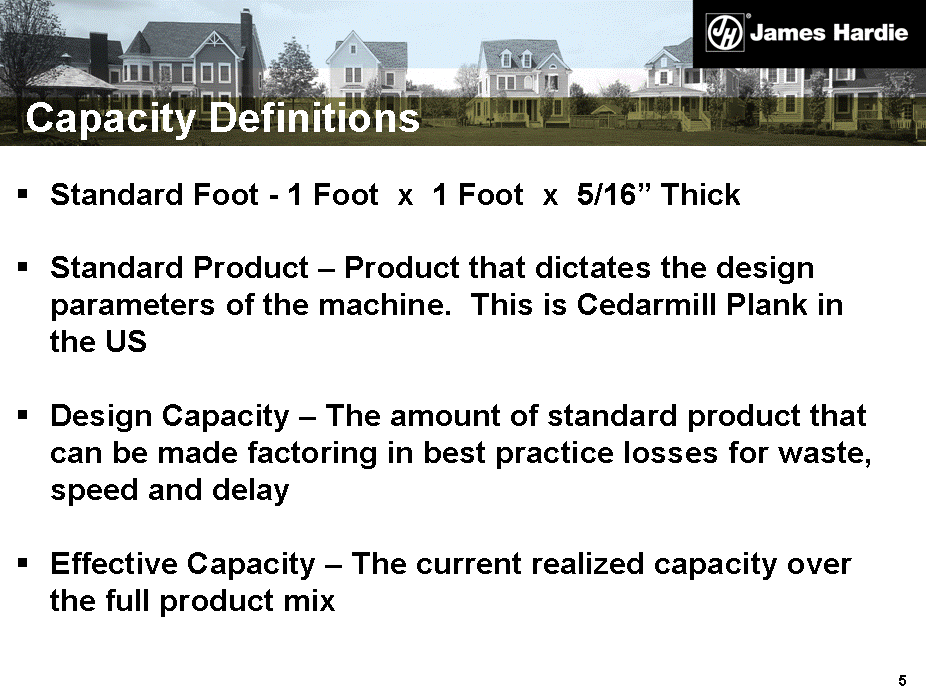
| Capacity Definitions Standard Foot - 1 Foot x 1 Foot x 5/16" Thick Standard Product - Product that dictates the design parameters of the machine. This is Cedarmill Plank in the US Design Capacity - The amount of standard product that can be made factoring in best practice losses for waste, speed and delay Effective Capacity - The current realized capacity over the full product mix |
60
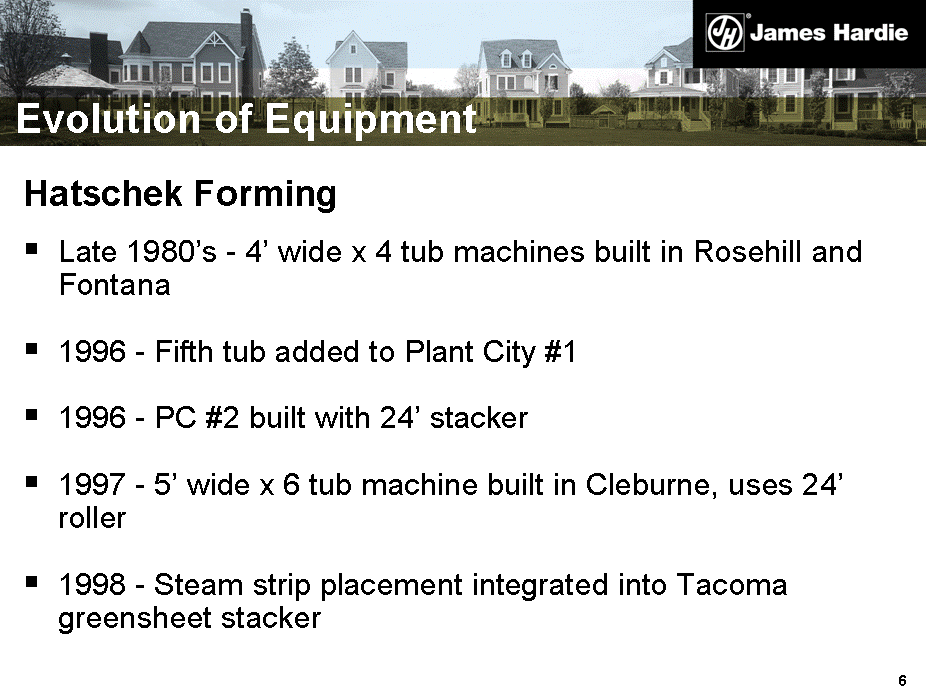
| Evolution of Equipment Hatschek Forming Late 1980's - 4' wide x 4 tub machines built in Rosehill and Fontana 1996 - Fifth tub added to Plant City #1 1996 - PC #2 built with 24' stacker 1997 - 5' wide x 6 tub machine built in Cleburne, uses 24' roller 1998 - Steam strip placement integrated into Tacoma greensheet stacker |
61
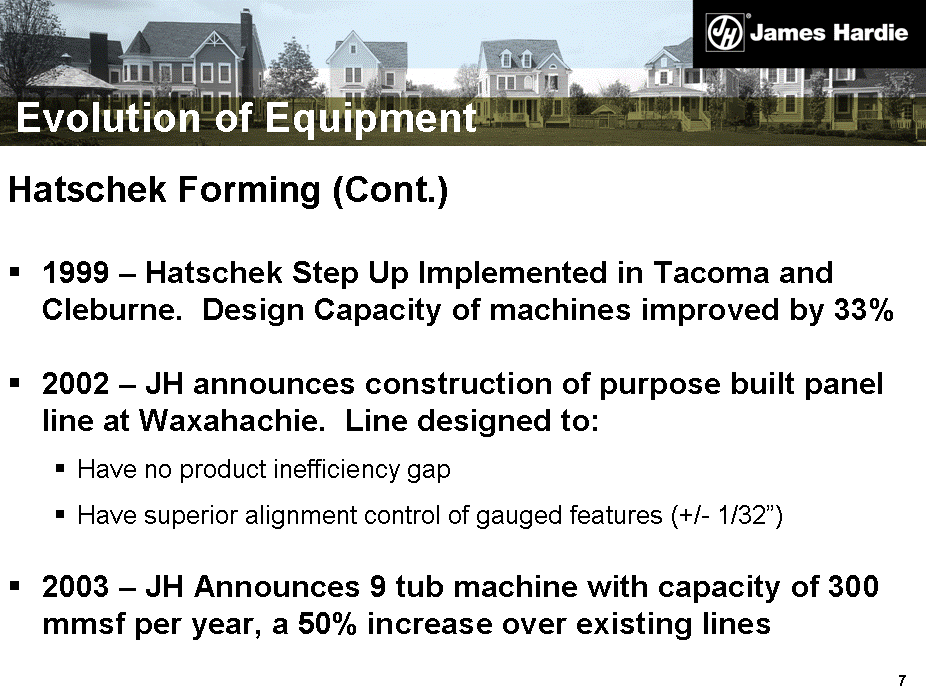
| Evolution of Equipment Hatschek Forming (Cont.) 1999 - Hatschek Step Up Implemented in Tacoma and Cleburne. Design Capacity of machines improved by 33% 2002 - JH announces construction of purpose built panel line at Waxahachie. Line designed to: Have no product inefficiency gap Have superior alignment control of gauged features (+/- 1/32") 2003 - JH Announces 9 tub machine with capacity of 300 mmsf per year, a 50% increase over existing lines |
62
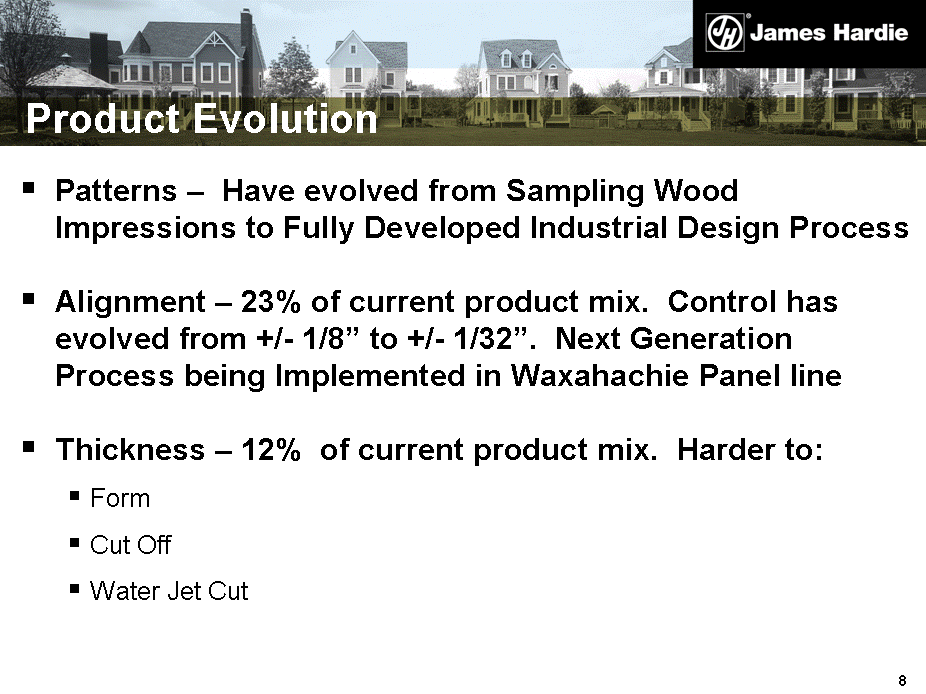
| Product Evolution Patterns - Have evolved from Sampling Wood Impressions to Fully Developed Industrial Design Process Alignment - 23% of current product mix. Control has evolved from +/- 1/8" to +/- 1/32". Next Generation Process being Implemented in Waxahachie Panel line Thickness - 12% of current product mix. Harder to: Form Cut Off Water Jet Cut |
63
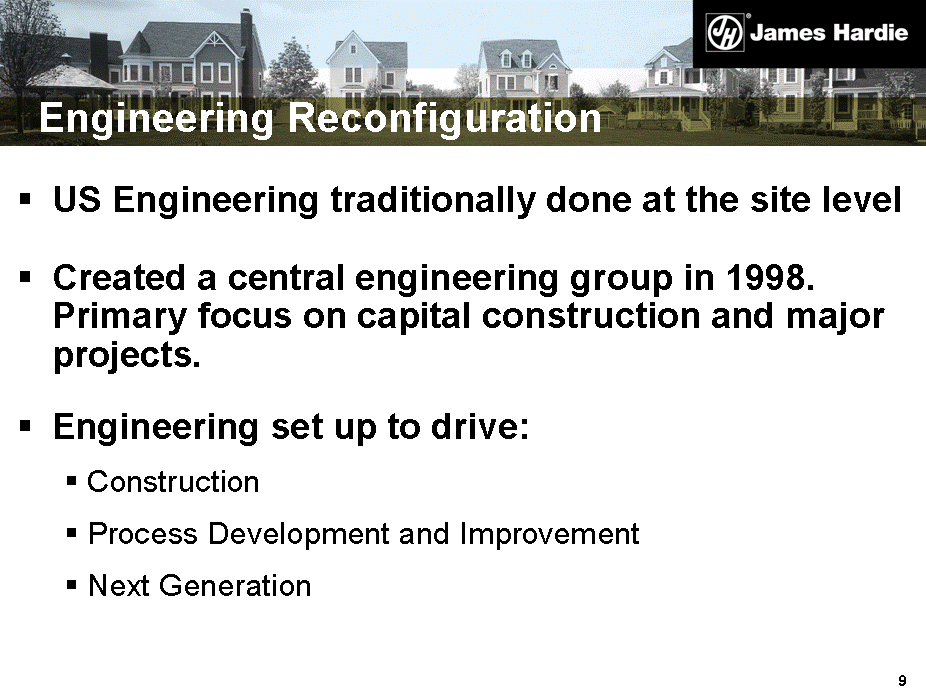
| Engineering Reconfiguration US Engineering traditionally done at the site level Created a central engineering group in 1998. Primary focus on capital construction and major projects. Engineering set up to drive: Construction Process Development and Improvement Next Generation |
64
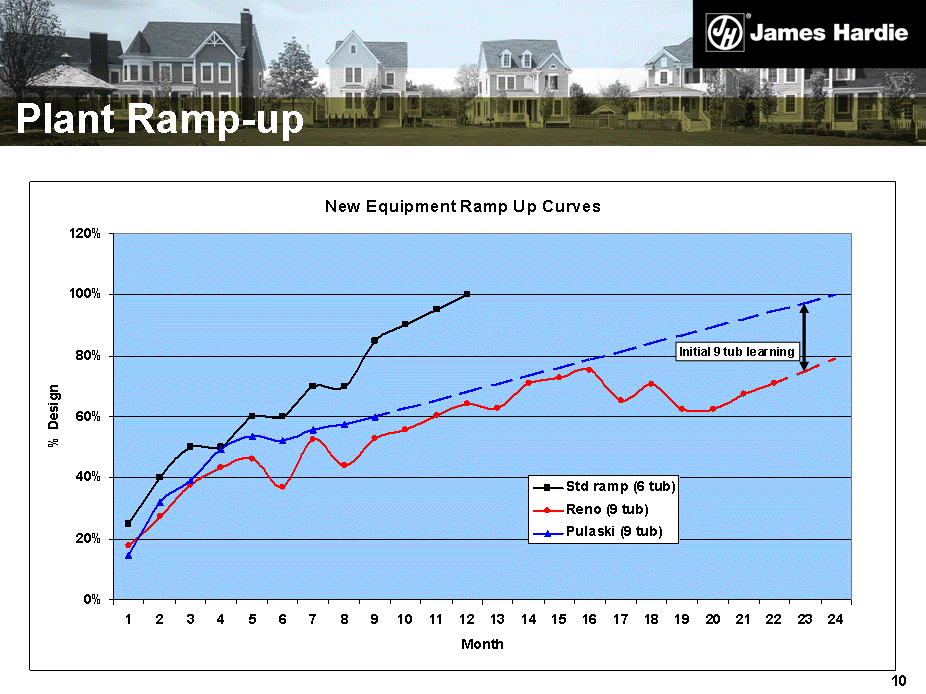
| Plant Ramp-up |
65
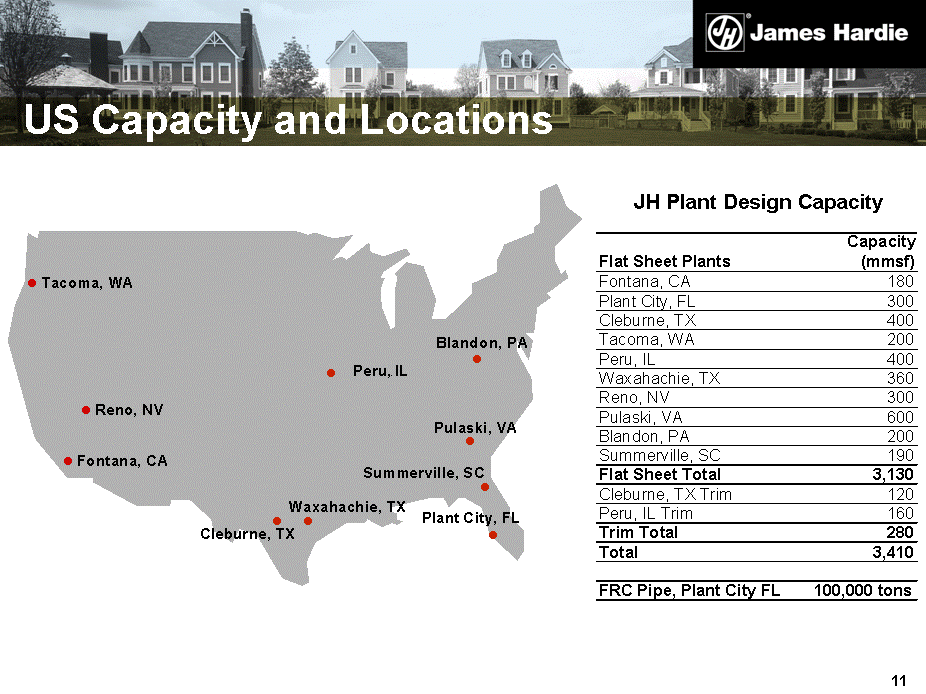
| JH Plant Design Capacity Tacoma, WA Plant City, FL Waxahachie, TX Cleburne, TX Peru,, IL Blandon, PA Summerville, SC Pulaski, VA Reno, NV US Capacity and Locations Fontana, CA |
66

| Strong Efficiency Gains Over Past 3 Years |
67
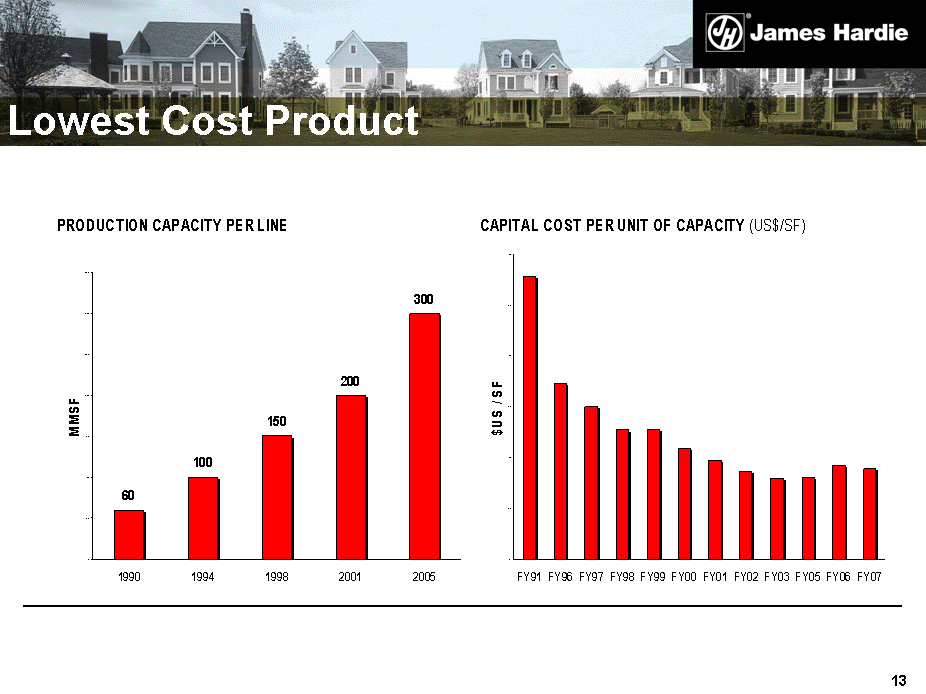
| Lowest Cost Product |
68
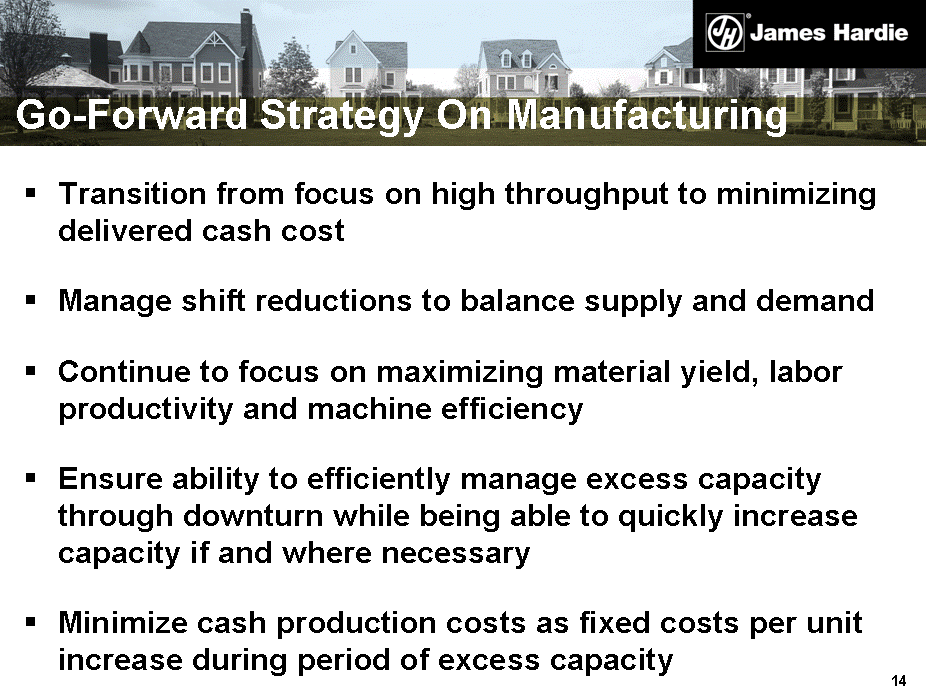
| Transition from focus on high throughput to minimizing delivered cash cost Manage shift reductions to balance supply and demand Continue to focus on maximizing material yield, labor productivity and machine efficiency Ensure ability to efficiently manage excess capacity through downturn while being able to quickly increase capacity if and where necessary Minimize cash production costs as fixed costs per unit increase during period of excess capacity Go-Forward Strategy On Manufacturing |
69
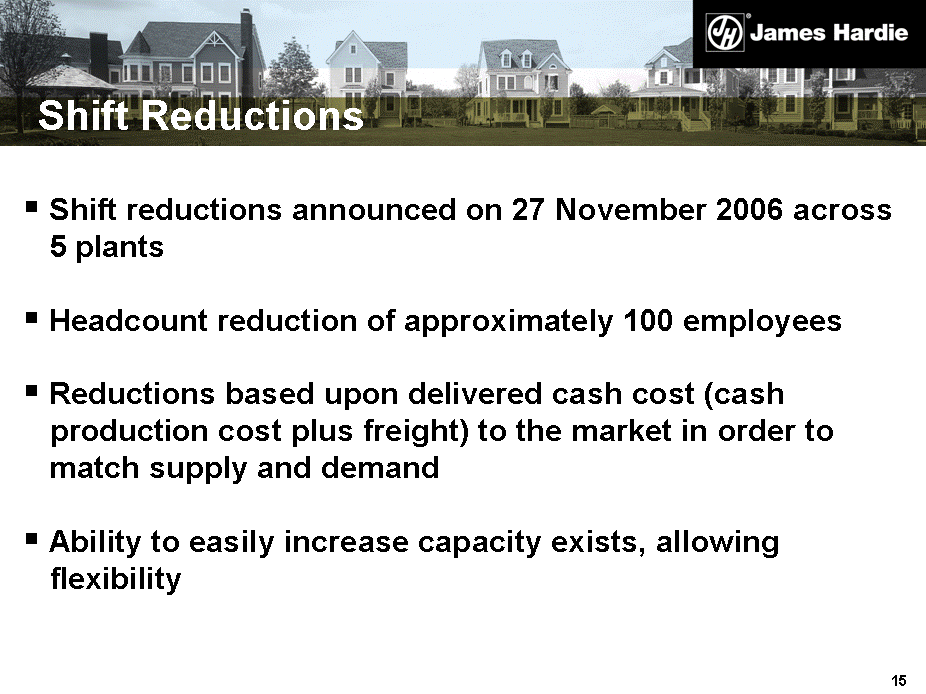
| Shift reductions announced on 27 November 2006 across 5 plants Headcount reduction of approximately 100 employees Reductions based upon delivered cash cost (cash production cost plus freight) to the market in order to match supply and demand Ability to easily increase capacity exists, allowing flexibility Shift Reductions |
70
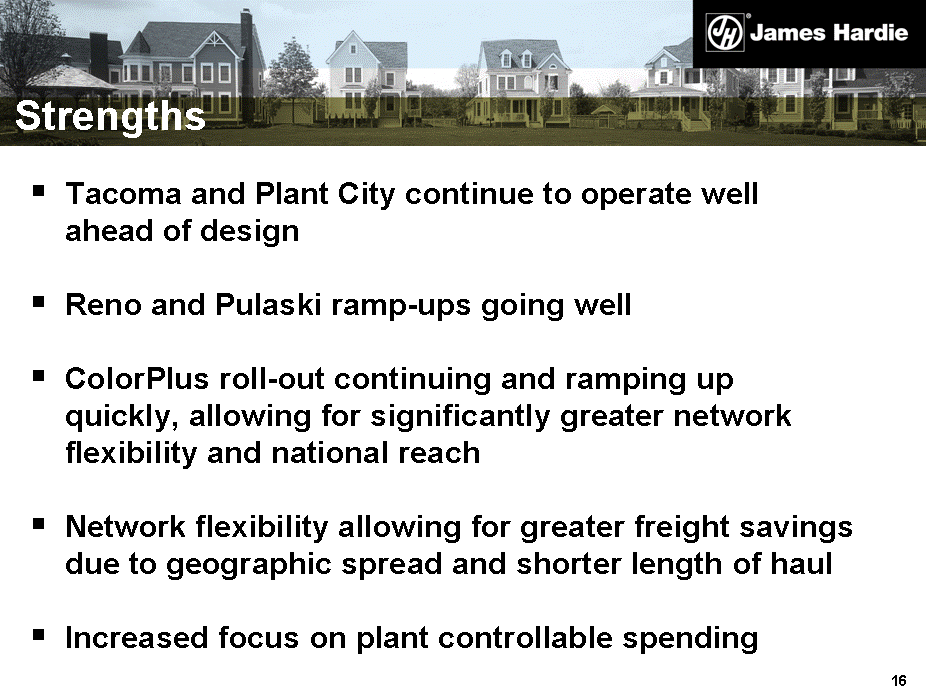
| Tacoma and Plant City continue to operate well ahead of design Reno and Pulaski ramp-ups going well ColorPlus roll-out continuing and ramping up quickly, allowing for significantly greater network flexibility and national reach Network flexibility allowing for greater freight savings due to geographic spread and shorter length of haul Increased focus on plant controllable spending Strengths |
71
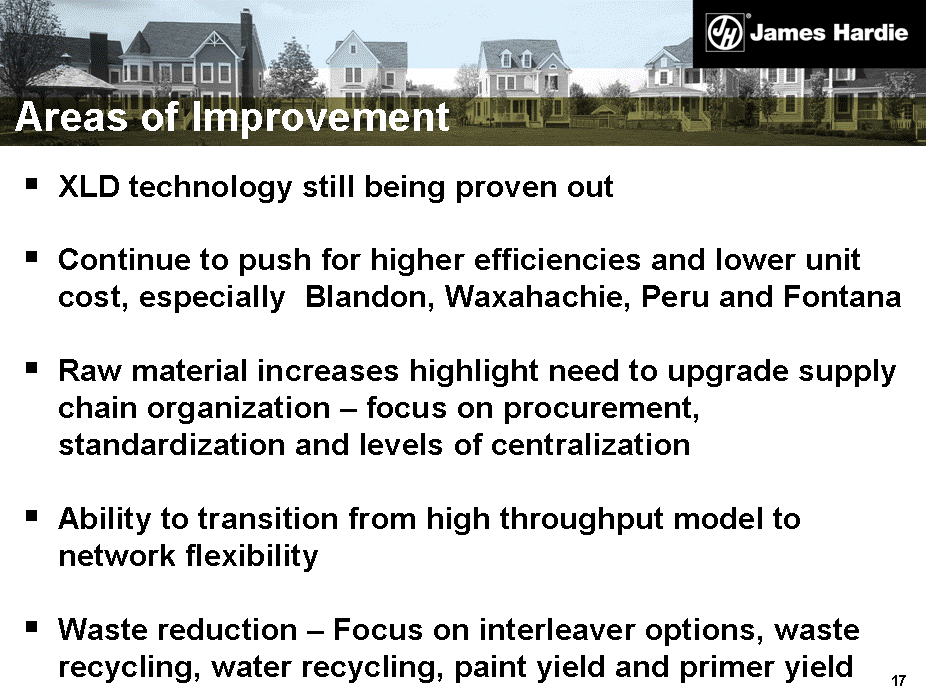
| XLD technology still being proven out Continue to push for higher efficiencies and lower unit cost, especially Blandon, Waxahachie, Peru and Fontana Raw material increases highlight need to upgrade supply chain organization - focus on procurement, standardization and levels of centralization Ability to transition from high throughput model to network flexibility Waste reduction - Focus on interleaver options, waste recycling, water recycling, paint yield and primer yield Areas of Improvement |
72
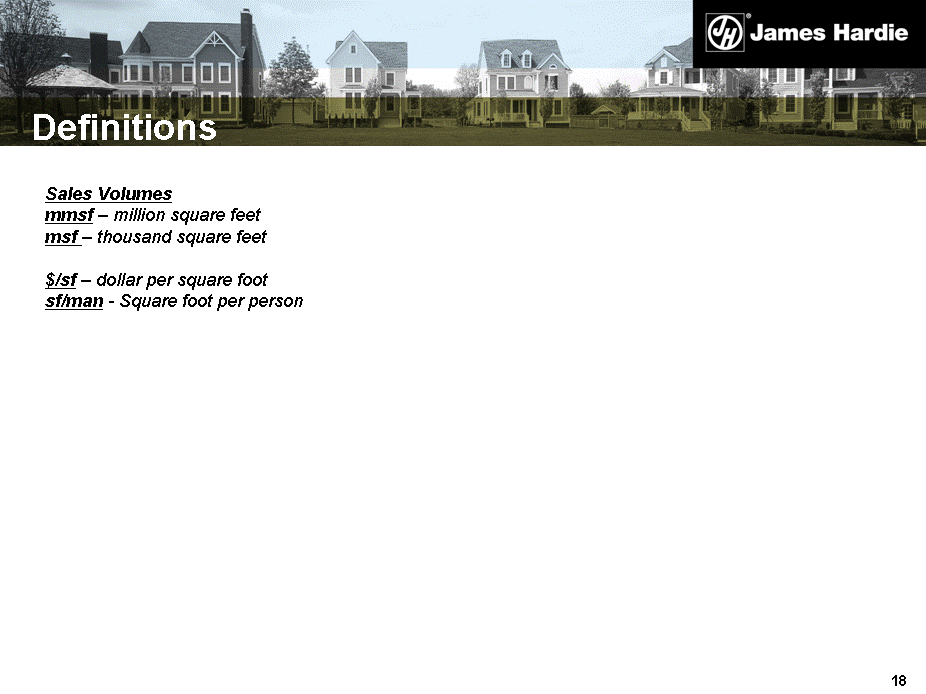
| Sales Volumes mmsf - million square feet msf - thousand square feet $/sf - dollar per square foot sf/man - Square foot per person Definitions |
73
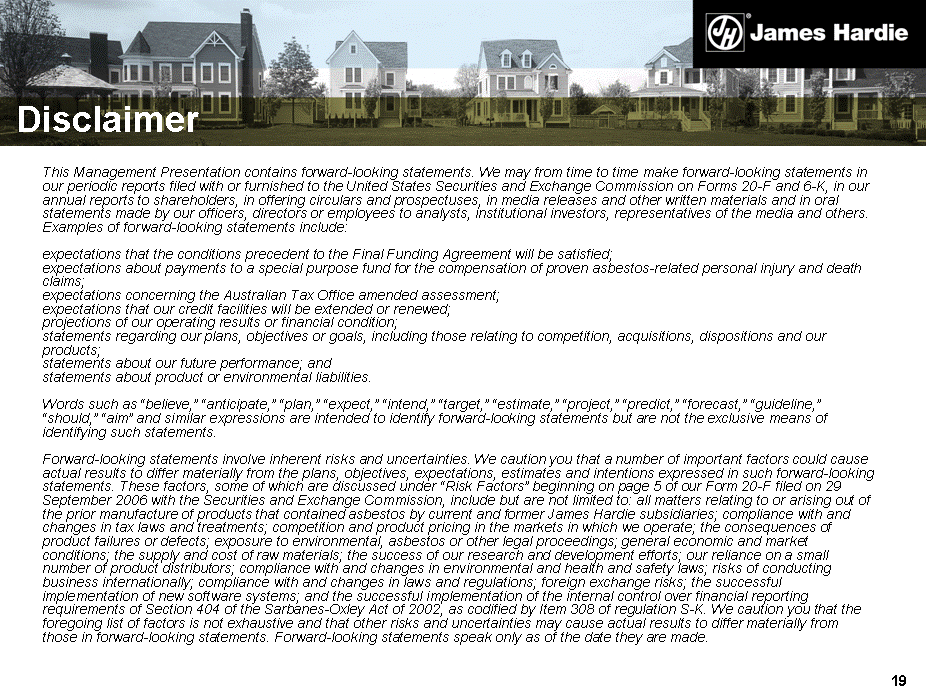
| This Management Presentation contains forward-looking statements. We may from time to time make forward-looking statements in our periodic reports filed with or furnished to the United States Securities and Exchange Commission on Forms 20-F and 6-K, in our annual reports to shareholders, in offering circulars and prospectuses, in media releases and other written materials and in oral statements made by our officers, directors or employees to analysts, institutional investors, representatives of the media and others. Examples of forward-looking statements include: expectations that the conditions precedent to the Final Funding Agreement will be satisfied; expectations about payments to a special purpose fund for the compensation of proven asbestos-related personal injury and death claims; expectations concerning the Australian Tax Office amended assessment; expectations that our credit facilities will be extended or renewed; projections of our operating results or financial condition; statements regarding our plans, objectives or goals, including those relating to competition, acquisitions, dispositions and our products; statements about our future performance; and statements about product or environmental liabilities. Words such as "believe," "anticipate," "plan," "expect," "intend," "target," "estimate," "project," "predict," "forecast," "guideline," "should," "aim" and similar expressions are intended to identify forward-looking statements but are not the exclusive means of identifying such statements. Forward-looking statements involve inherent risks and uncertainties. We caution you that a number of important factors could cause actual results to differ materially from the plans, objectives, expectations, estimates and intentions expressed in such forward-looking statements. These factors, some of which are discussed under "Risk Factors" beginning on page 5 of our Form 20-F filed on 29 September 2006 with the Securities and Exchange Commission, include but are not limited to: all matters relating to or arising out of the prior manufacture of products that contained asbestos by current and former James Hardie subsidiaries; compliance with and changes in tax laws and treatments; competition and product pricing in the markets in which we operate; the consequences of product failures or defects; exposure to environmental, asbestos or other legal proceedings; general economic and market conditions; the supply and cost of raw materials; the success of our research and development efforts; our reliance on a small number of product distributors; compliance with and changes in environmental and health and safety laws; risks of conducting business internationally; compliance with and changes in laws and regulations; foreign exchange risks; the successful implementation of new software systems; and the successful implementation of the internal control over financial reporting requirements of Section 404 of the Sarbanes-Oxley Act of 2002, as codified by Item 308 of regulation S-K. We caution you that the foregoing list of factors is not exhaustive and that other risks and uncertainties may cause actual results to differ materially from those in forward-looking statements. Forward-looking statements speak only as of the date they are made. Disclaimer |
74

| 2006 Analyst/Investor Tour Mark Fisher Research and Development 12-13 December 2006 |
75

| Technology Strategy Enable JH product leadership strategy Provide sustainable advantage Balance between Research and Development Integration with business units Leverage portfolio of systems and technologies Use IP to protect competitive advantage |
76

| Organization Two research centers - Australia and US Development - focused organization around implementing technologies Research - core understanding of materials and the science behind them Resources Knowledge management and innovation focused Diverse organization Building science Material science Chemistry |
77
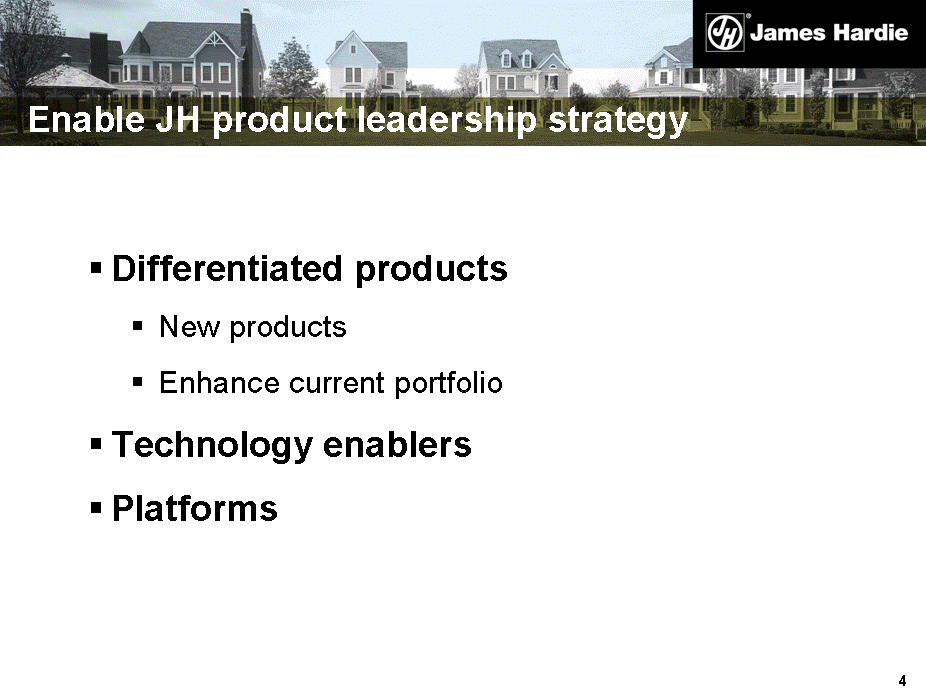
| Enable JH product leadership strategy Differentiated products New products Enhance current portfolio Technology enablers Platforms |
78
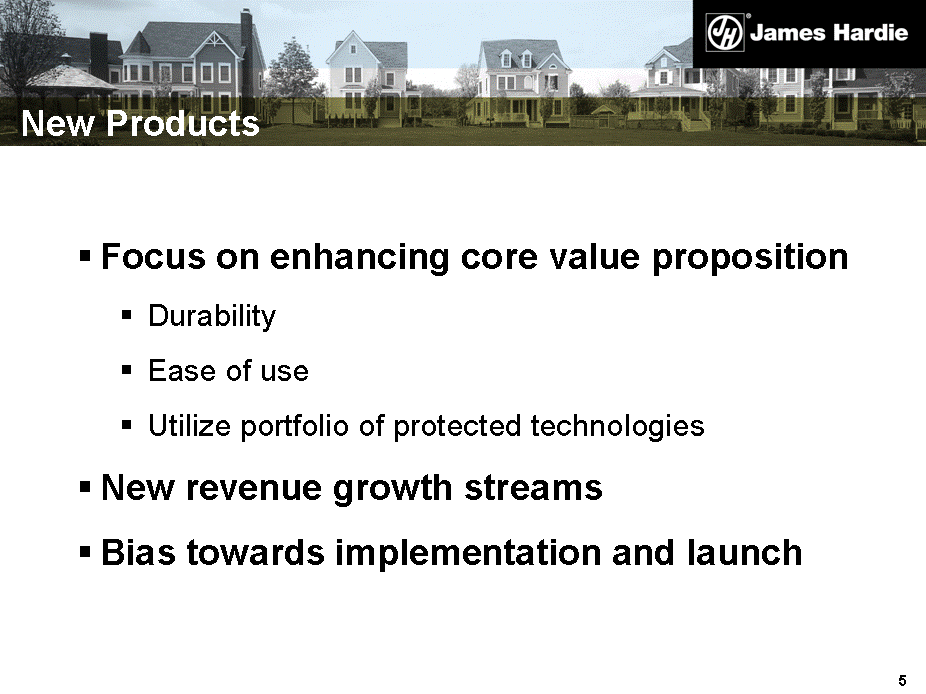
| New Products Focus on enhancing core value proposition Durability Ease of use Utilize portfolio of protected technologies New revenue growth streams Bias towards implementation and launch |
79
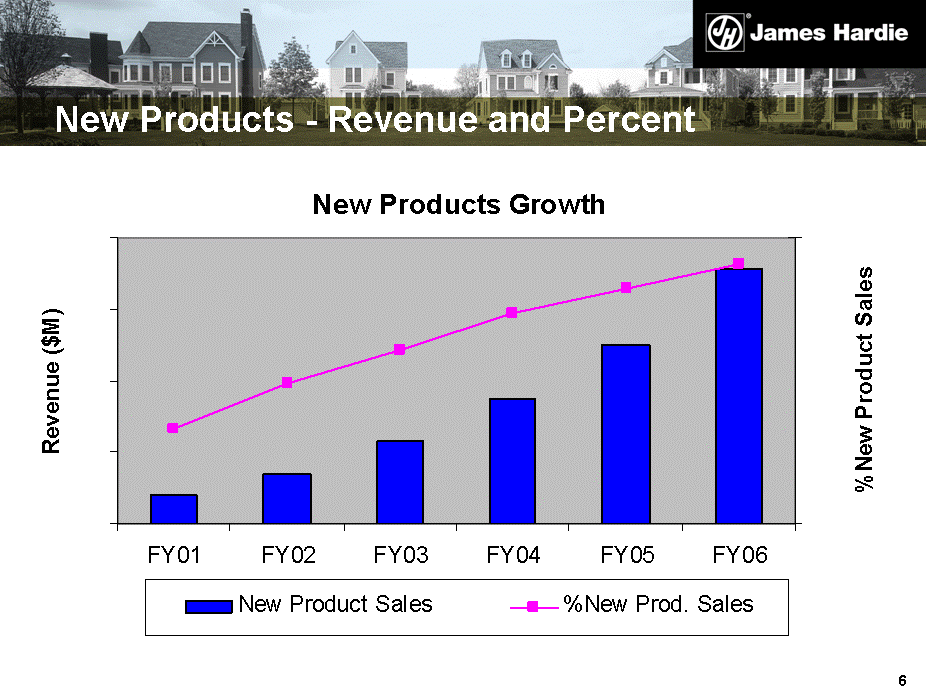
| New Products - Revenue and Percent |
80
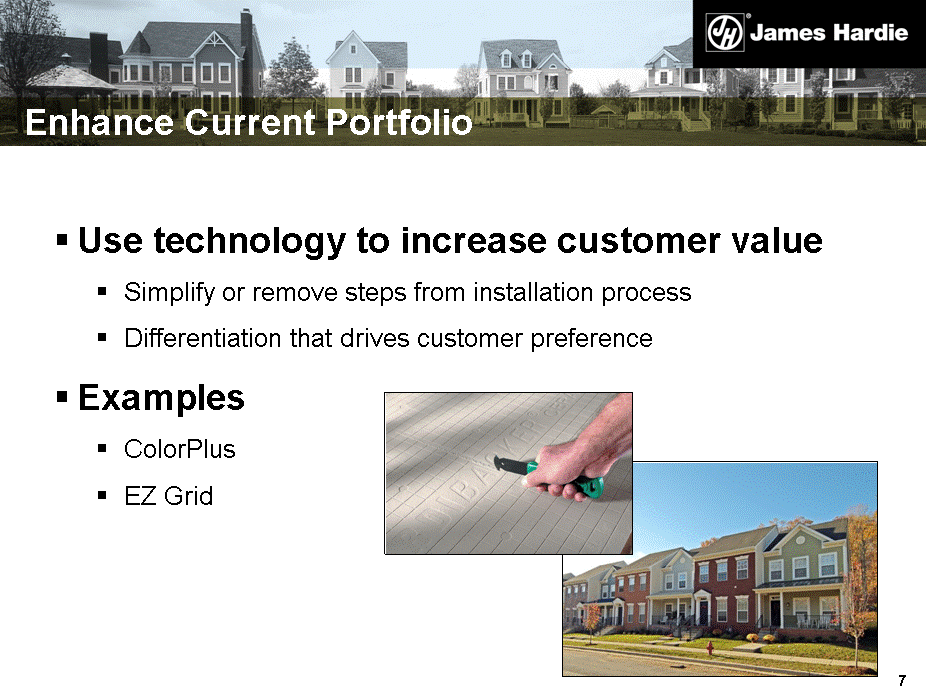
| Enhance Current Portfolio Use technology to increase customer value Simplify or remove steps from installation process Differentiation that drives customer preference Examples ColorPlus EZ Grid |
81

| Enablers Additional technologies that sustain core technologies Systems that can cross multiple product families Examples Laminate system for prefinished products Mold block technologies for interior products Pattern embossing for exterior products |
82

| Platforms Enhance efficiency and value of current platform Develop new platforms Examples Scale- shift Hatschek from 100mmsf to 300mmsf / line XLD technology platform |
83
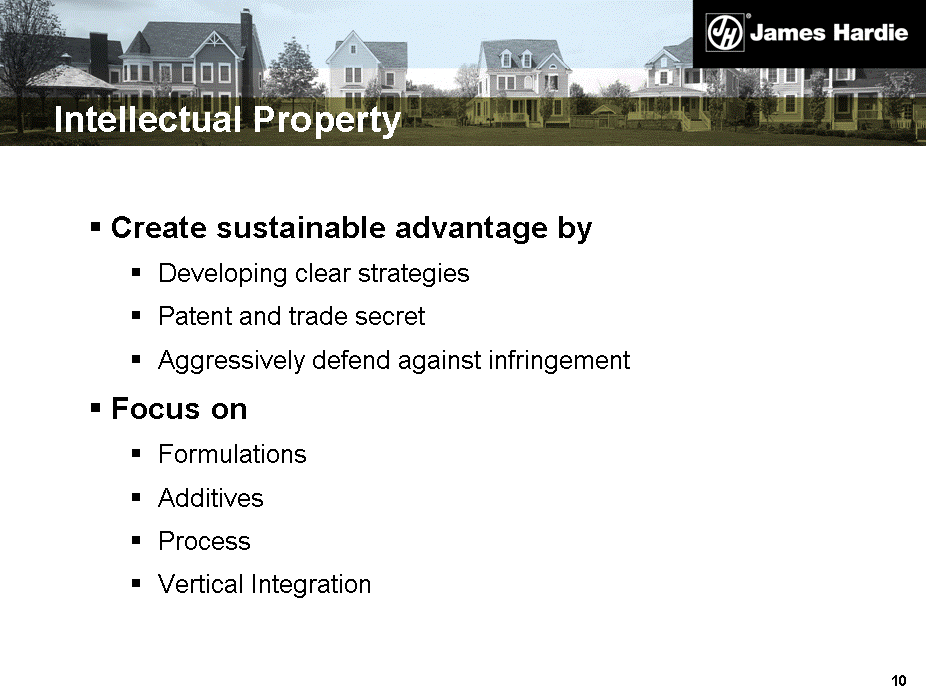
| Intellectual Property Create sustainable advantage by Developing clear strategies Patent and trade secret Aggressively defend against infringement Focus on Formulations Additives Process Vertical Integration |
84
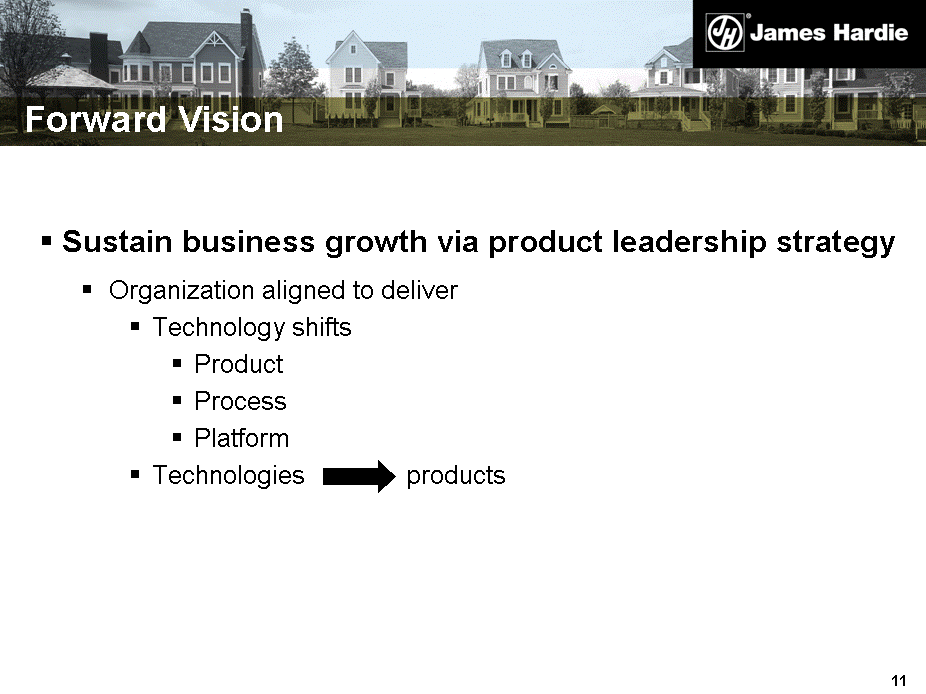
| Forward Vision Sustain business growth via product leadership strategy Organization aligned to deliver Technology shifts Product Process Platform Technologies products |
85
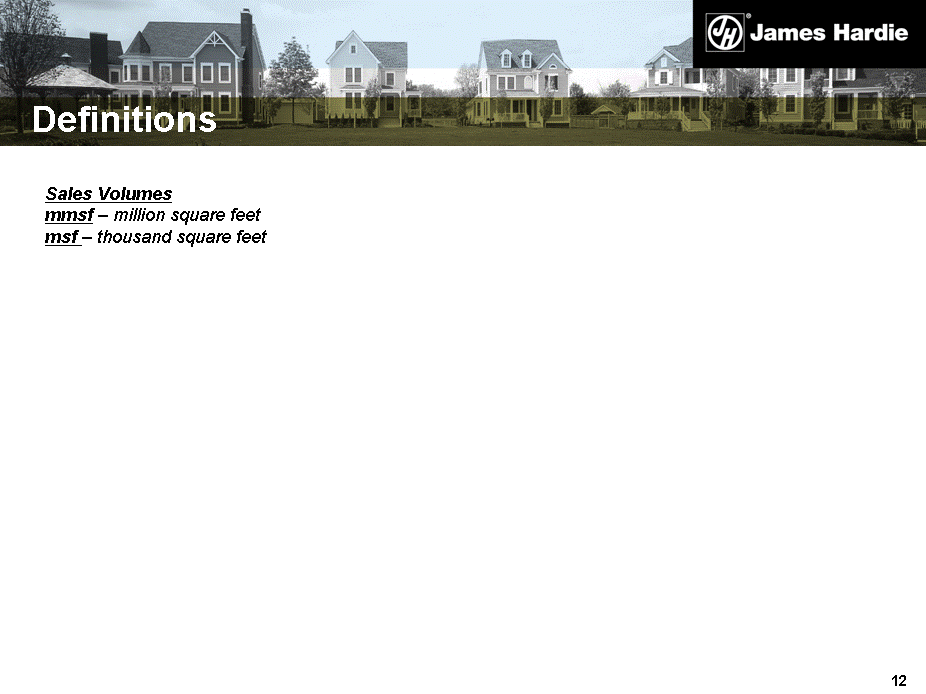
| Sales Volumes mmsf - million square feet msf - thousand square feet Definitions |
86
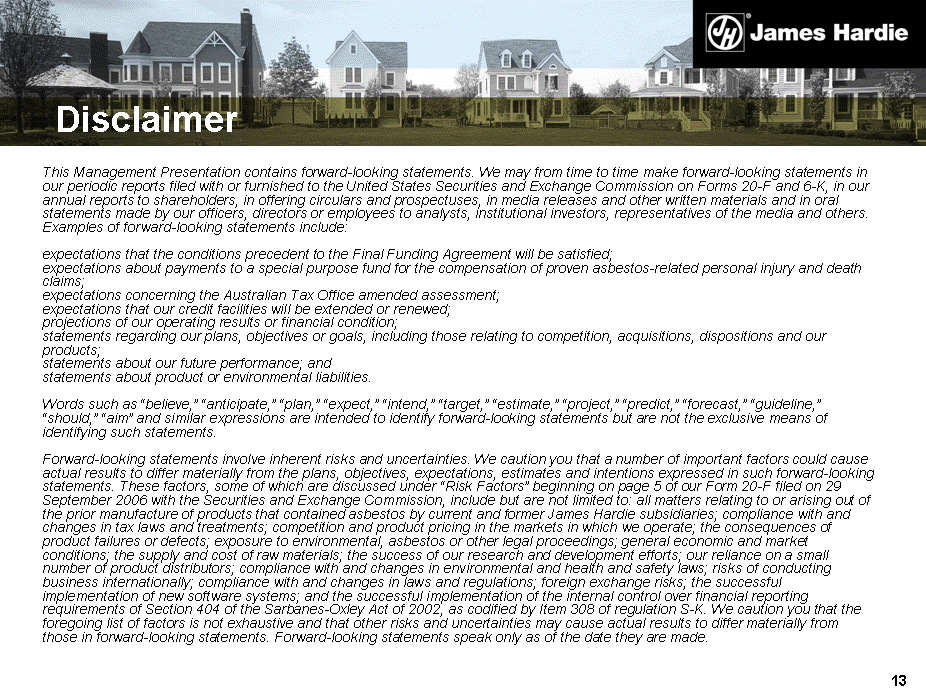
| This Management Presentation contains forward-looking statements. We may from time to time make forward-looking statements in our periodic reports filed with or furnished to the United States Securities and Exchange Commission on Forms 20-F and 6-K, in our annual reports to shareholders, in offering circulars and prospectuses, in media releases and other written materials and in oral statements made by our officers, directors or employees to analysts, institutional investors, representatives of the media and others. Examples of forward-looking statements include: expectations that the conditions precedent to the Final Funding Agreement will be satisfied; expectations about payments to a special purpose fund for the compensation of proven asbestos-related personal injury and death claims; expectations concerning the Australian Tax Office amended assessment; expectations that our credit facilities will be extended or renewed; projections of our operating results or financial condition; statements regarding our plans, objectives or goals, including those relating to competition, acquisitions, dispositions and our products; statements about our future performance; and statements about product or environmental liabilities. Words such as "believe," "anticipate," "plan," "expect," "intend," "target," "estimate," "project," "predict," "forecast," "guideline," "should," "aim" and similar expressions are intended to identify forward-looking statements but are not the exclusive means of identifying such statements. Forward-looking statements involve inherent risks and uncertainties. We caution you that a number of important factors could cause actual results to differ materially from the plans, objectives, expectations, estimates and intentions expressed in such forward-looking statements. These factors, some of which are discussed under "Risk Factors" beginning on page 5 of our Form 20-F filed on 29 September 2006 with the Securities and Exchange Commission, include but are not limited to: all matters relating to or arising out of the prior manufacture of products that contained asbestos by current and former James Hardie subsidiaries; compliance with and changes in tax laws and treatments; competition and product pricing in the markets in which we operate; the consequences of product failures or defects; exposure to environmental, asbestos or other legal proceedings; general economic and market conditions; the supply and cost of raw materials; the success of our research and development efforts; our reliance on a small number of product distributors; compliance with and changes in environmental and health and safety laws; risks of conducting business internationally; compliance with and changes in laws and regulations; foreign exchange risks; the successful implementation of new software systems; and the successful implementation of the internal control over financial reporting requirements of Section 404 of the Sarbanes-Oxley Act of 2002, as codified by Item 308 of regulation S-K. We caution you that the foregoing list of factors is not exhaustive and that other risks and uncertainties may cause actual results to differ materially from those in forward-looking statements. Forward-looking statements speak only as of the date they are made. Disclaimer |
87
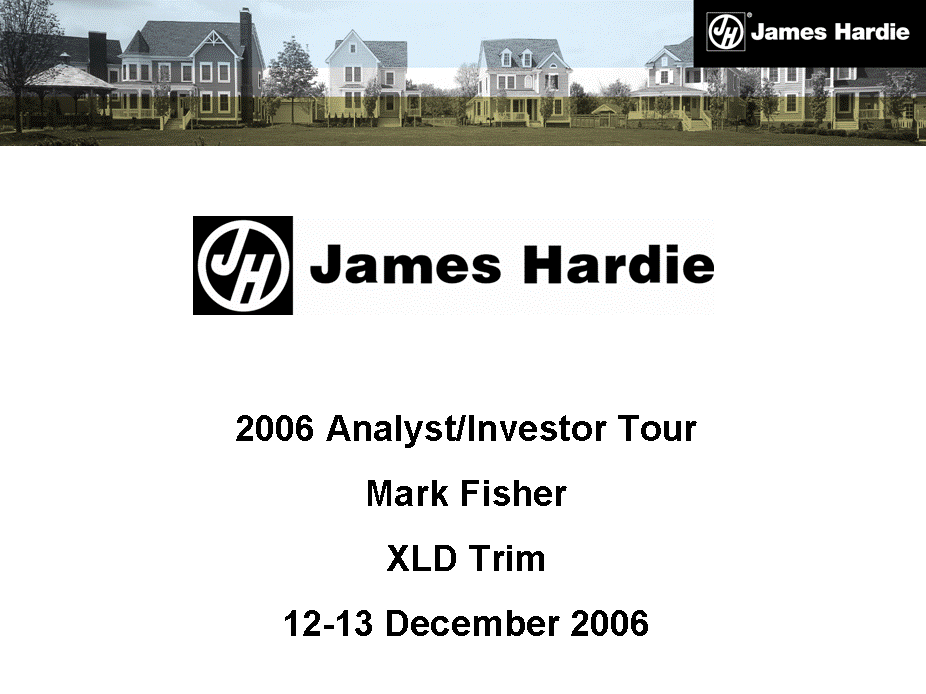
| 2006 Analyst/Investor Tour Mark Fisher XLD Trim 12-13 December 2006 |
88
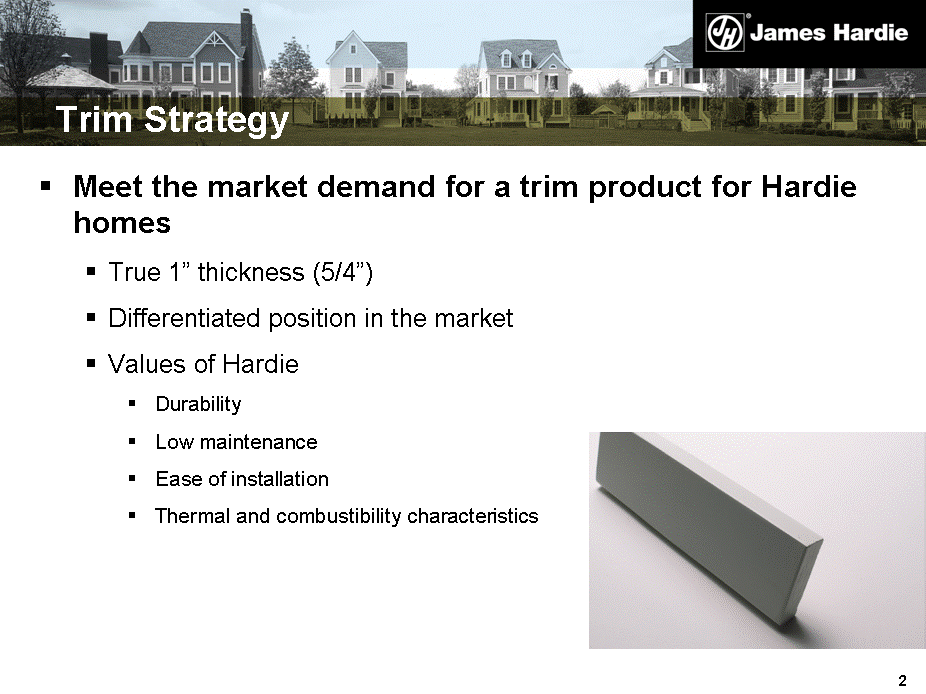
| Trim Strategy Meet the market demand for a trim product for Hardie homes True 1" thickness (5/4") Differentiated position in the market Values of Hardie Durability Low maintenance Ease of installation Thermal and combustibility characteristics |
89

| Manufacturing Production plants Cleburne 1st generation facility Operational since 2000 Peru Latest generation facility Operational since April 2005 Centrally located to access market |
90
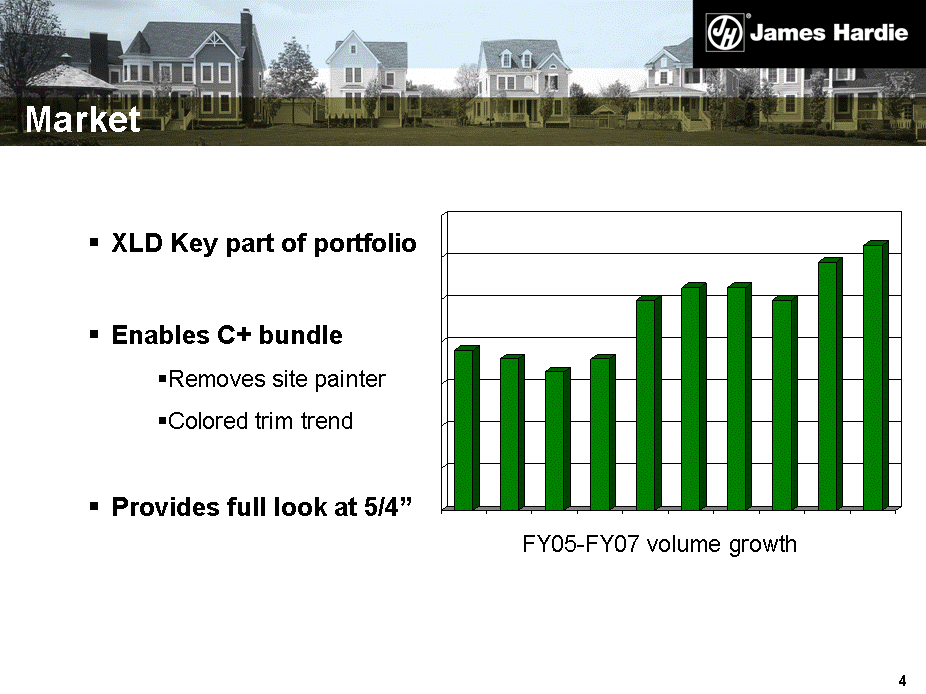
| Market XLD Key part of portfolio Enables C+ bundle Removes site painter Colored trim trend Provides full look at 5/4" FY05-FY07 volume growth |
91
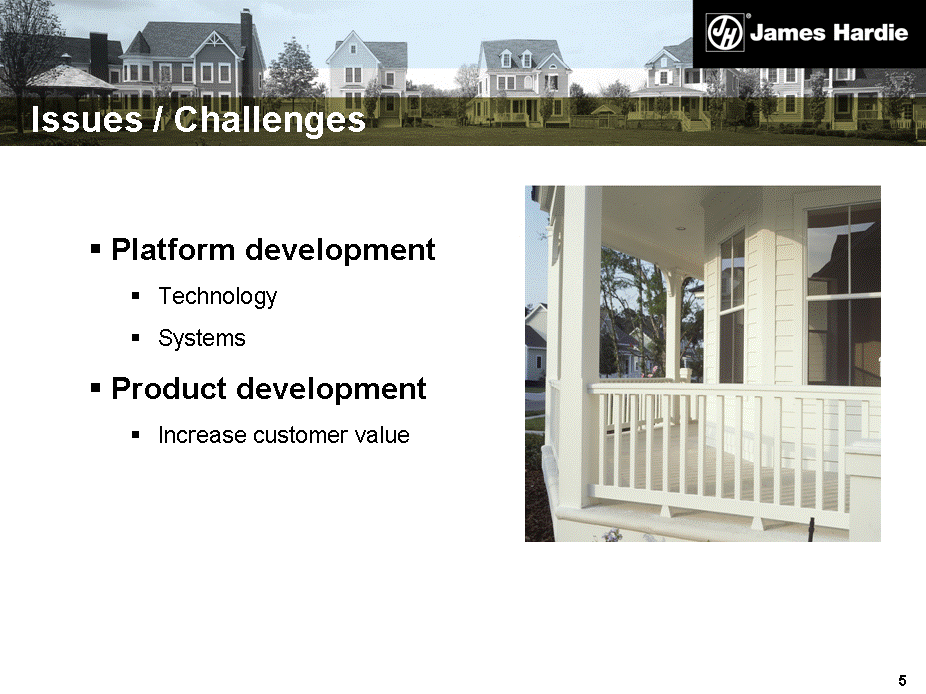
| Issues / Challenges Platform development Technology Systems Product development Increase customer value |
92

| Go Forward Plan Continued growth C+ Bundle Platform / product evolution |
93
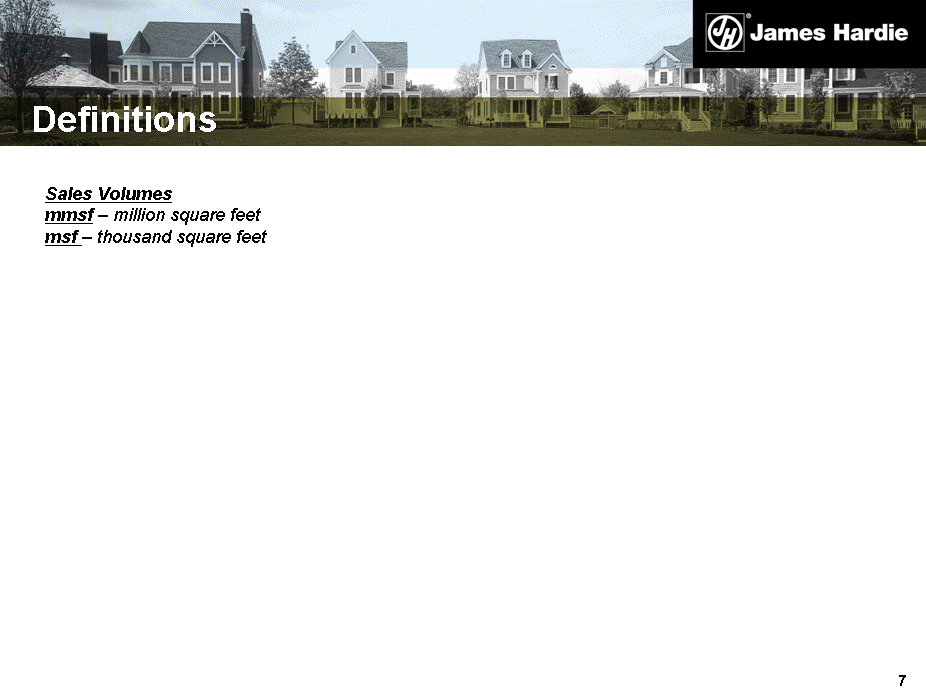
| Sales Volumes mmsf - million square feet msf - thousand square feet Definitions |
94
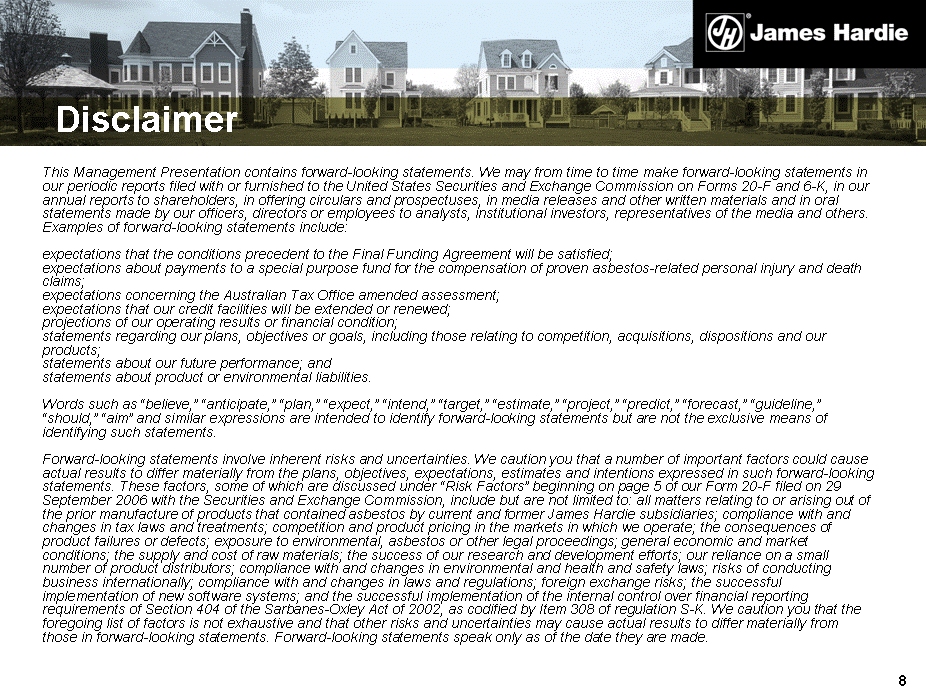
| This Management Presentation contains forward-looking statements. We may from time to time make forward-looking statements in our periodic reports filed with or furnished to the United States Securities and Exchange Commission on Forms 20-F and 6-K, in our annual reports to shareholders, in offering circulars and prospectuses, in media releases and other written materials and in oral statements made by our officers, directors or employees to analysts, institutional investors, representatives of the media and others. Examples of forward-looking statements include: expectations that the conditions precedent to the Final Funding Agreement will be satisfied; expectations about payments to a special purpose fund for the compensation of proven asbestos-related personal injury and death claims; expectations concerning the Australian Tax Office amended assessment; expectations that our credit facilities will be extended or renewed; projections of our operating results or financial condition; statements regarding our plans, objectives or goals, including those relating to competition, acquisitions, dispositions and our products; statements about our future performance; and statements about product or environmental liabilities. Words such as "believe," "anticipate," "plan," "expect," "intend," "target," "estimate," "project," "predict," "forecast," "guideline," "should," "aim" and similar expressions are intended to identify forward-looking statements but are not the exclusive means of identifying such statements. Forward-looking statements involve inherent risks and uncertainties. We caution you that a number of important factors could cause actual results to differ materially from the plans, objectives, expectations, estimates and intentions expressed in such forward-looking statements. These factors, some of which are discussed under "Risk Factors" beginning on page 5 of our Form 20-F filed on 29 September 2006 with the Securities and Exchange Commission, include but are not limited to: all matters relating to or arising out of the prior manufacture of products that contained asbestos by current and former James Hardie subsidiaries; compliance with and changes in tax laws and treatments; competition and product pricing in the markets in which we operate; the consequences of product failures or defects; exposure to environmental, asbestos or other legal proceedings; general economic and market conditions; the supply and cost of raw materials; the success of our research and development efforts; our reliance on a small number of product distributors; compliance with and changes in environmental and health and safety laws; risks of conducting business internationally; compliance with and changes in laws and regulations; foreign exchange risks; the successful implementation of new software systems; and the successful implementation of the internal control over financial reporting requirements of Section 404 of the Sarbanes-Oxley Act of 2002, as codified by Item 308 of regulation S-K. We caution you that the foregoing list of factors is not exhaustive and that other risks and uncertainties may cause actual results to differ materially from those in forward-looking statements. Forward-looking statements speak only as of the date they are made. Disclaimer |
95
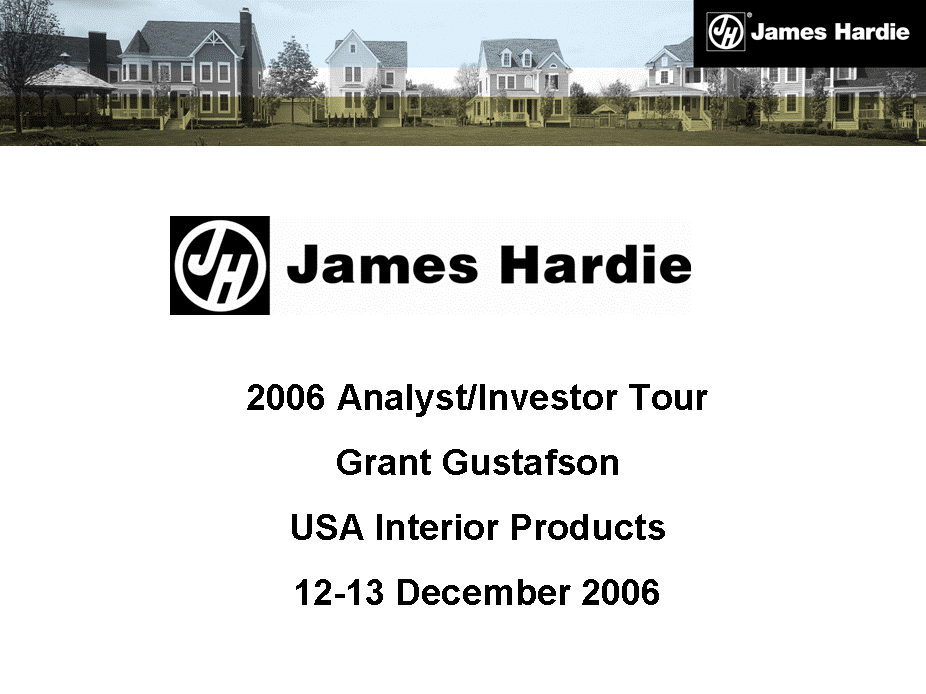
| 2006 Analyst/Investor Tour Grant Gustafson USA Interior Products 12-13 December 2006 |
96
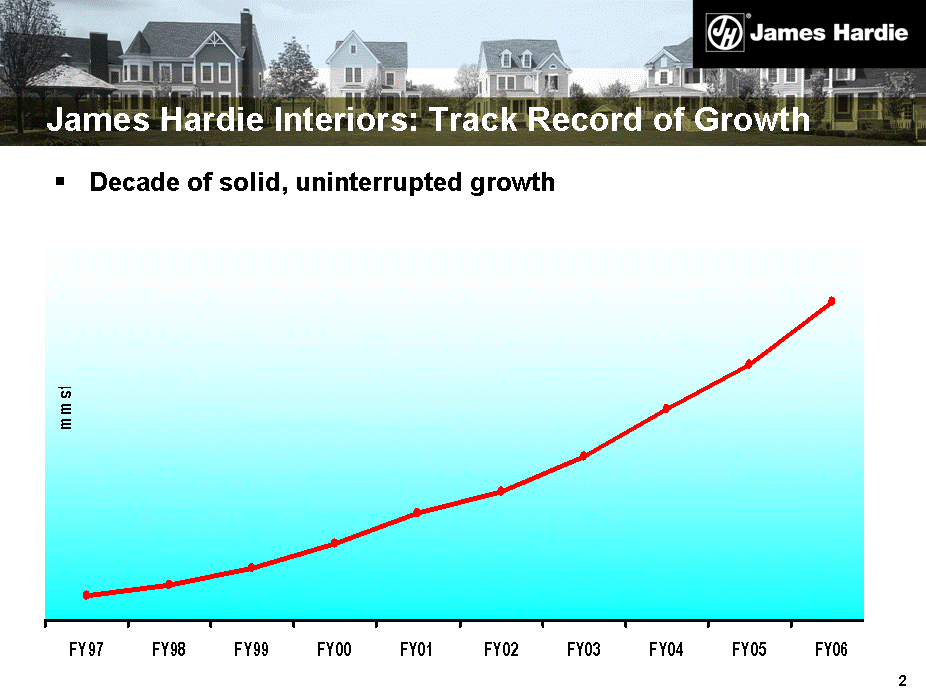
| James Hardie Interiors: Track Record of Growth Decade of solid, uninterrupted growth |
97
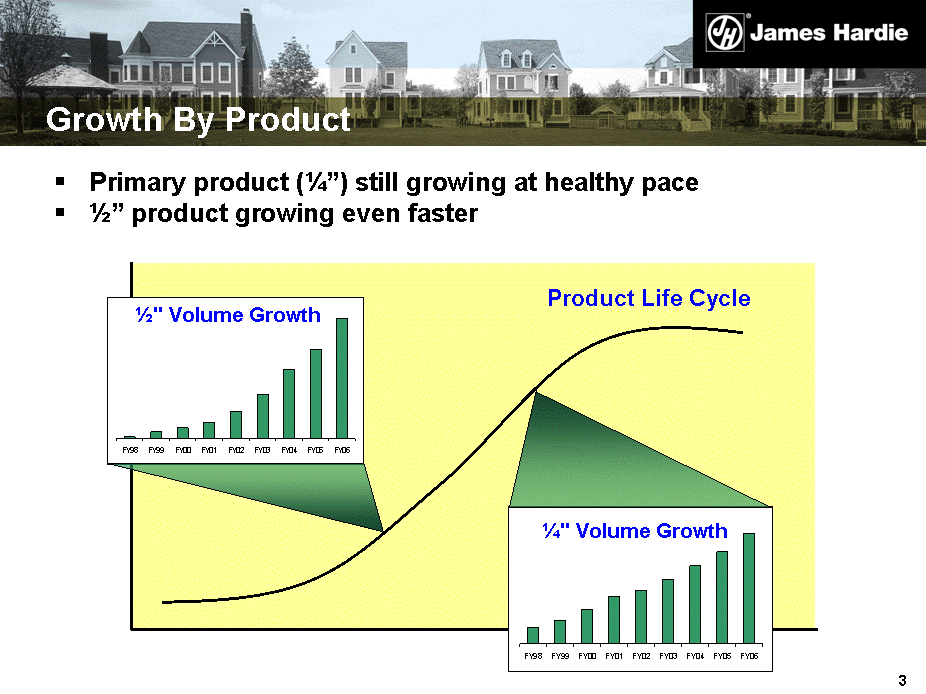
| Primary product (1/4") still growing at healthy pace 1/2" product growing even faster Growth By Product Product Life Cycle 1/4" Volume Growth 1/2" Volume Growth |
98
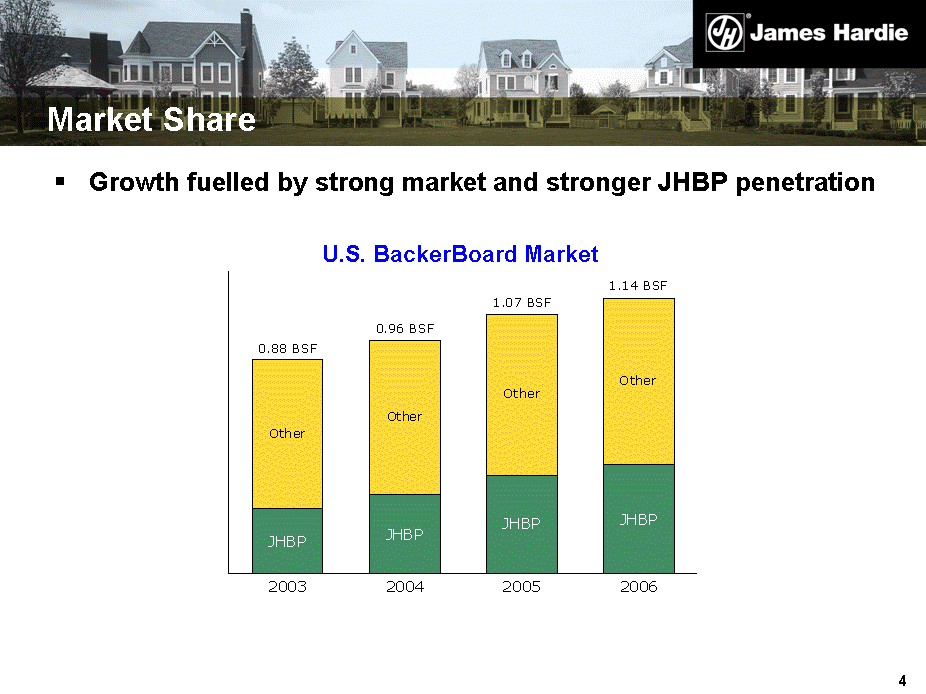
| Market Share Growth fuelled by strong market and stronger JHBP penetration U.S. BackerBoard Market |
99
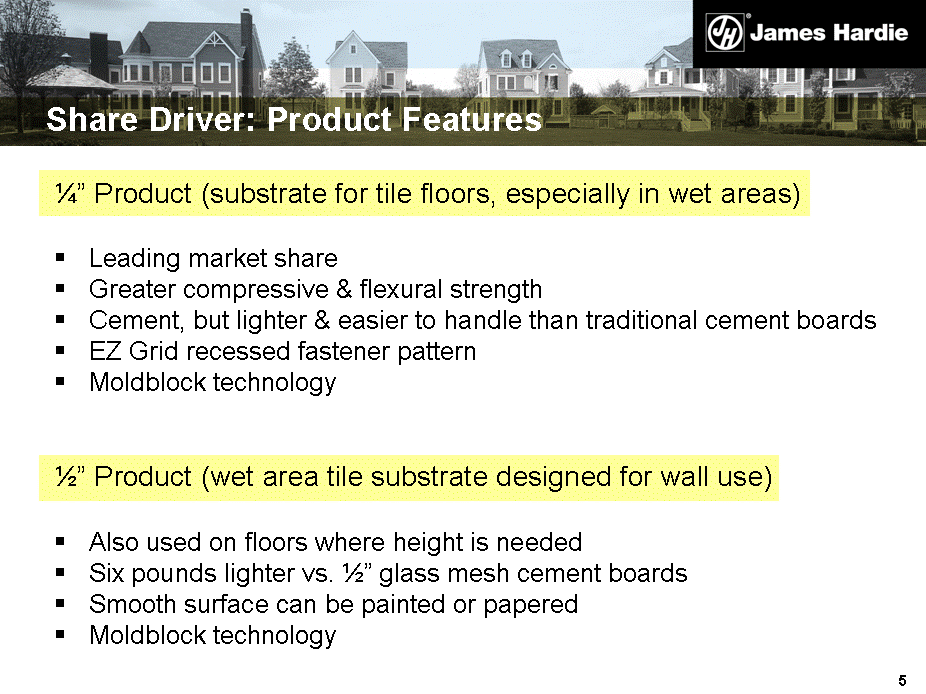
| 1/4" Product (substrate for tile floors, especially in wet areas) Leading market share Greater compressive & flexural strength Cement, but lighter & easier to handle than traditional cement boards EZ Grid recessed fastener pattern Moldblock technology 1/2" Product (wet area tile substrate designed for wall use) Also used on floors where height is needed Six pounds lighter vs. 1/2" glass mesh cement boards Smooth surface can be painted or papered Moldblock technology Share Driver: Product Features |
100
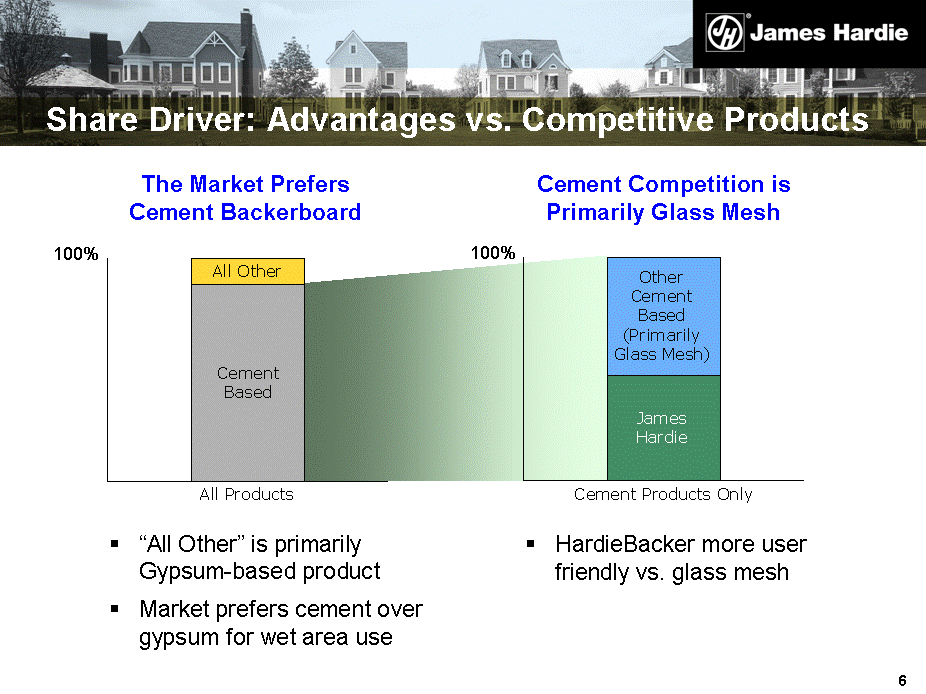
| Share Driver: Advantages vs. Competitive Products 100% The Market Prefers Cement Backerboard 100% Cement Competition is Primarily Glass Mesh "All Other" is primarily Gypsum-based product Market prefers cement over gypsum for wet area use HardieBacker more user friendly vs. glass mesh |
101
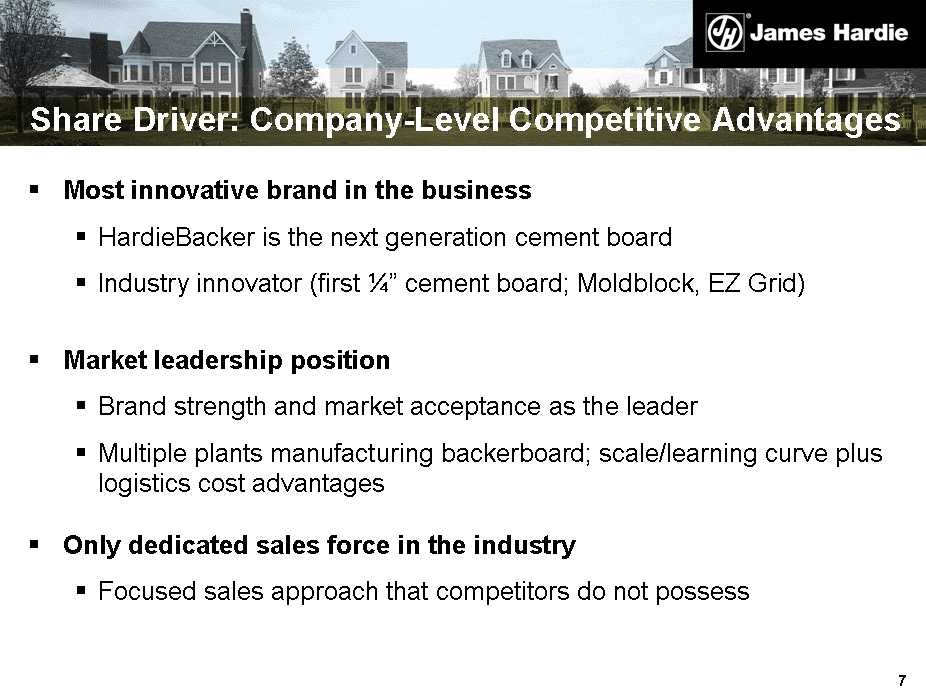
| Most innovative brand in the business HardieBacker is the next generation cement board Industry innovator (first 1/4" cement board; Moldblock, EZ Grid) Market leadership position Brand strength and market acceptance as the leader Multiple plants manufacturing backerboard; scale/learning curve plus logistics cost advantages Only dedicated sales force in the industry Focused sales approach that competitors do not possess Share Driver: Company-Level Competitive Advantages |
102
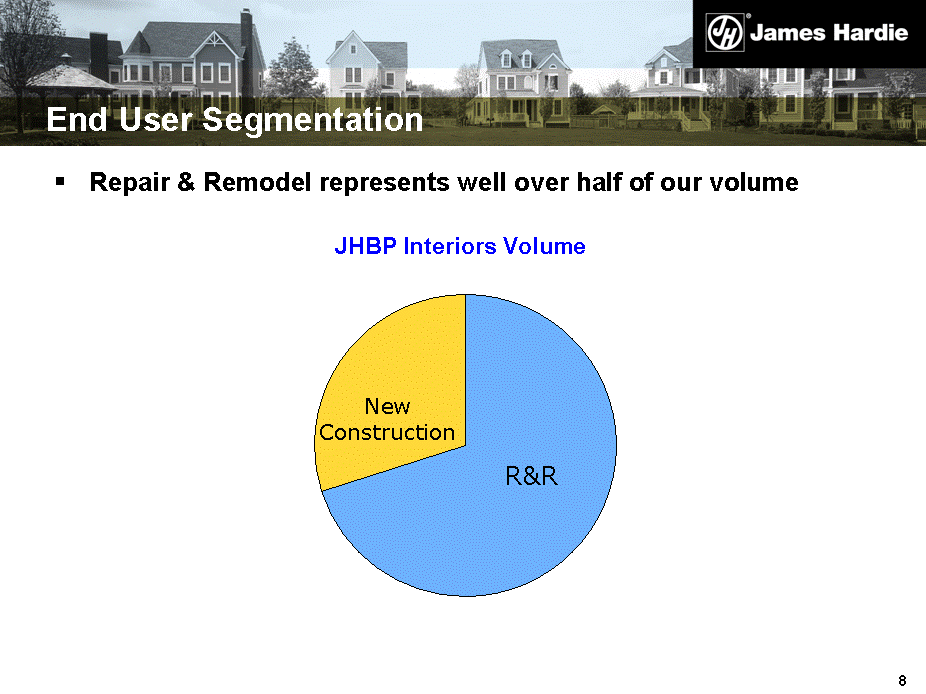
| End User Segmentation Repair & Remodel represents well over half of our volume JHBP Interiors Volume |
103
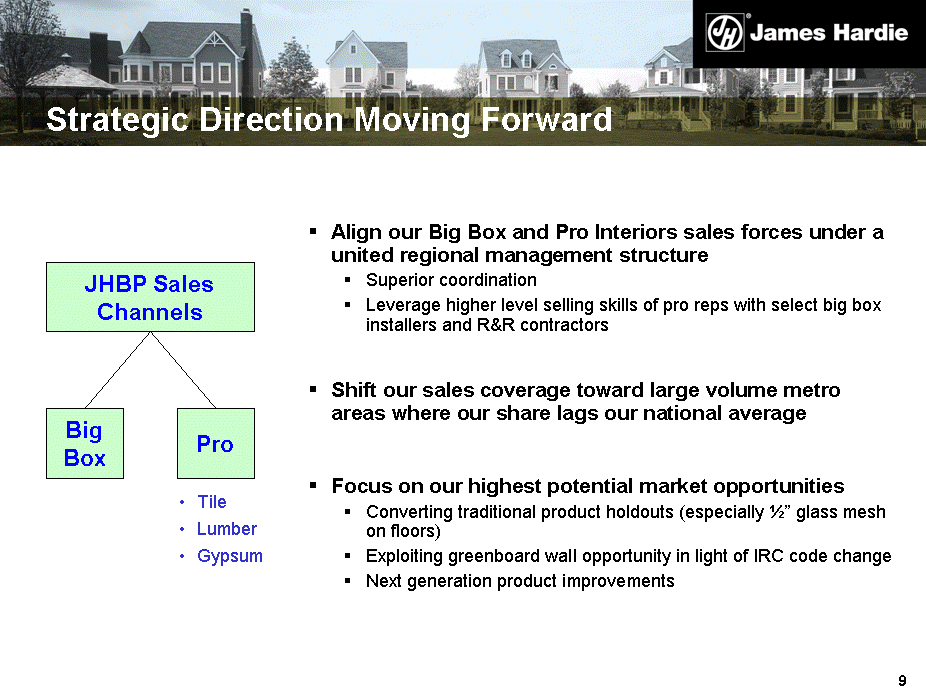
| Strategic Direction Moving Forward Align our Big Box and Pro Interiors sales forces under a united regional management structure Superior coordination Leverage higher level selling skills of pro reps with select big box installers and R&R contractors Shift our sales coverage toward large volume metro areas where our share lags our national average Focus on our highest potential market opportunities Converting traditional product holdouts (especially 1/2" glass mesh on floors) Exploiting greenboard wall opportunity in light of IRC code change Next generation product improvements JHBP Sales Channels Big Box Pro Tile Lumber Gypsum |
104
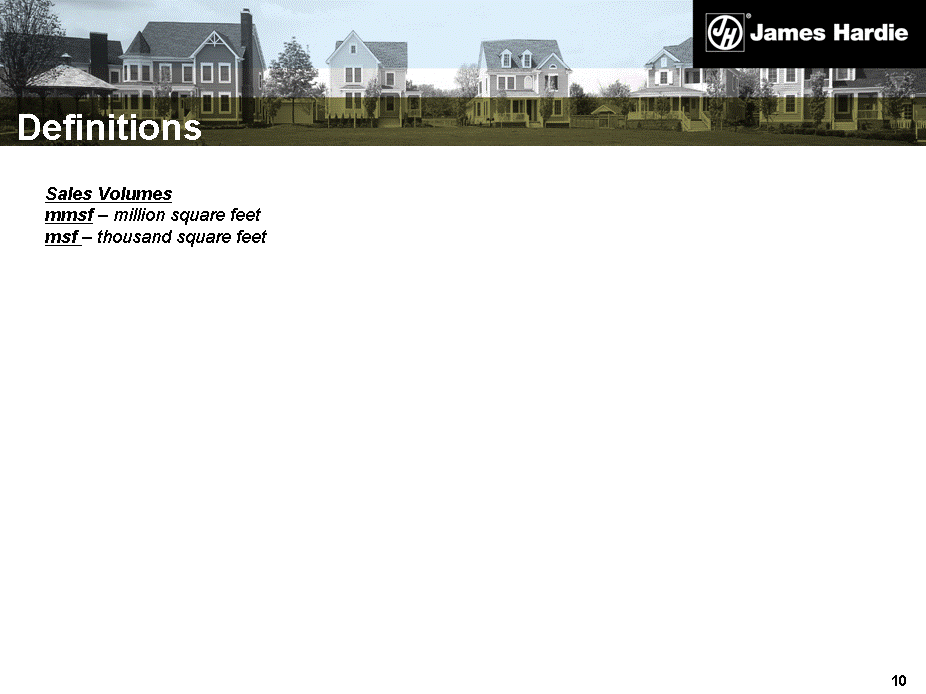
| Sales Volumes mmsf - million square feet msf - thousand square feet Definitions |
105
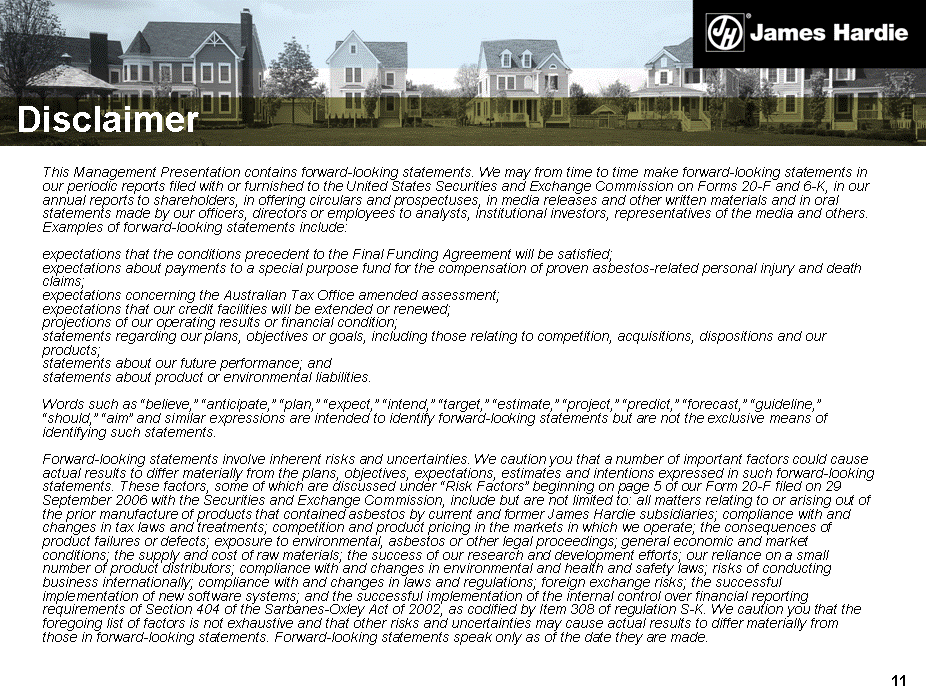
| This Management Presentation contains forward-looking statements. We may from time to time make forward-looking statements in our periodic reports filed with or furnished to the United States Securities and Exchange Commission on Forms 20-F and 6-K, in our annual reports to shareholders, in offering circulars and prospectuses, in media releases and other written materials and in oral statements made by our officers, directors or employees to analysts, institutional investors, representatives of the media and others. Examples of forward-looking statements include: expectations that the conditions precedent to the Final Funding Agreement will be satisfied; expectations about payments to a special purpose fund for the compensation of proven asbestos-related personal injury and death claims; expectations concerning the Australian Tax Office amended assessment; expectations that our credit facilities will be extended or renewed; projections of our operating results or financial condition; statements regarding our plans, objectives or goals, including those relating to competition, acquisitions, dispositions and our products; statements about our future performance; and statements about product or environmental liabilities. Words such as "believe," "anticipate," "plan," "expect," "intend," "target," "estimate," "project," "predict," "forecast," "guideline," "should," "aim" and similar expressions are intended to identify forward-looking statements but are not the exclusive means of identifying such statements. Forward-looking statements involve inherent risks and uncertainties. We caution you that a number of important factors could cause actual results to differ materially from the plans, objectives, expectations, estimates and intentions expressed in such forward-looking statements. These factors, some of which are discussed under "Risk Factors" beginning on page 5 of our Form 20-F filed on 29 September 2006 with the Securities and Exchange Commission, include but are not limited to: all matters relating to or arising out of the prior manufacture of products that contained asbestos by current and former James Hardie subsidiaries; compliance with and changes in tax laws and treatments; competition and product pricing in the markets in which we operate; the consequences of product failures or defects; exposure to environmental, asbestos or other legal proceedings; general economic and market conditions; the supply and cost of raw materials; the success of our research and development efforts; our reliance on a small number of product distributors; compliance with and changes in environmental and health and safety laws; risks of conducting business internationally; compliance with and changes in laws and regulations; foreign exchange risks; the successful implementation of new software systems; and the successful implementation of the internal control over financial reporting requirements of Section 404 of the Sarbanes-Oxley Act of 2002, as codified by Item 308 of regulation S-K. We caution you that the foregoing list of factors is not exhaustive and that other risks and uncertainties may cause actual results to differ materially from those in forward-looking statements. Forward-looking statements speak only as of the date they are made. Disclaimer |
106
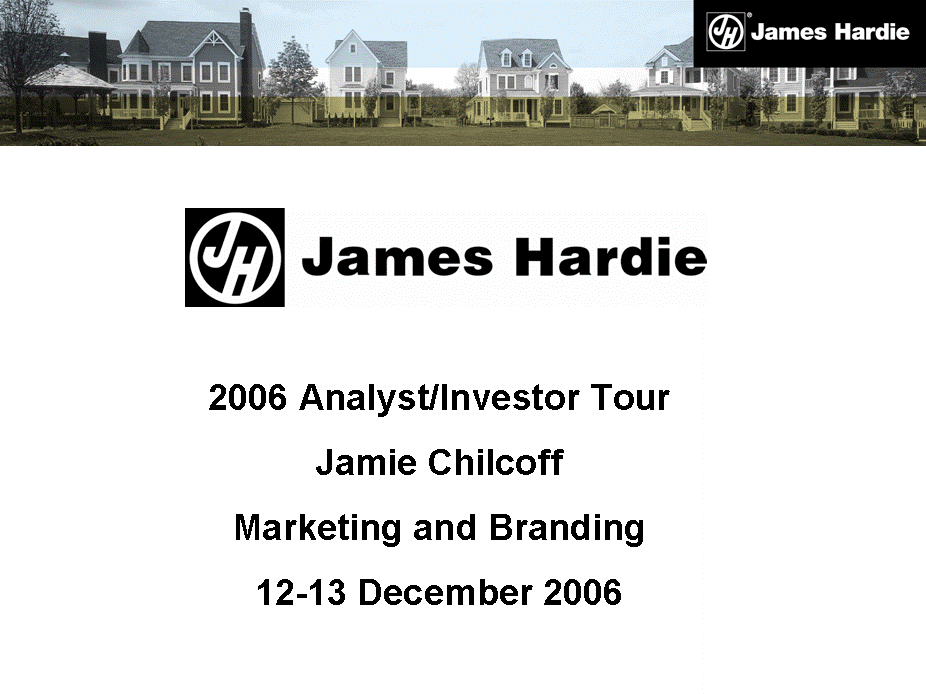
| 2006 Analyst/Investor Tour Jamie Chilcoff Marketing and Branding 12-13 December 2006 |
107
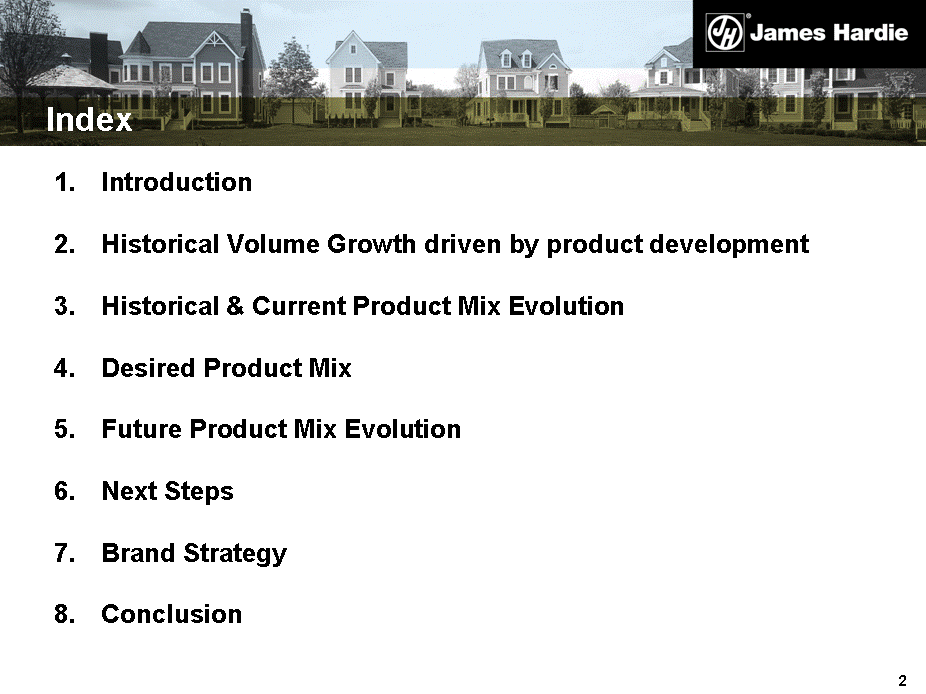
| Index Introduction Historical Volume Growth driven by product development Historical & Current Product Mix Evolution Desired Product Mix Future Product Mix Evolution Next Steps Brand Strategy Conclusion |
108
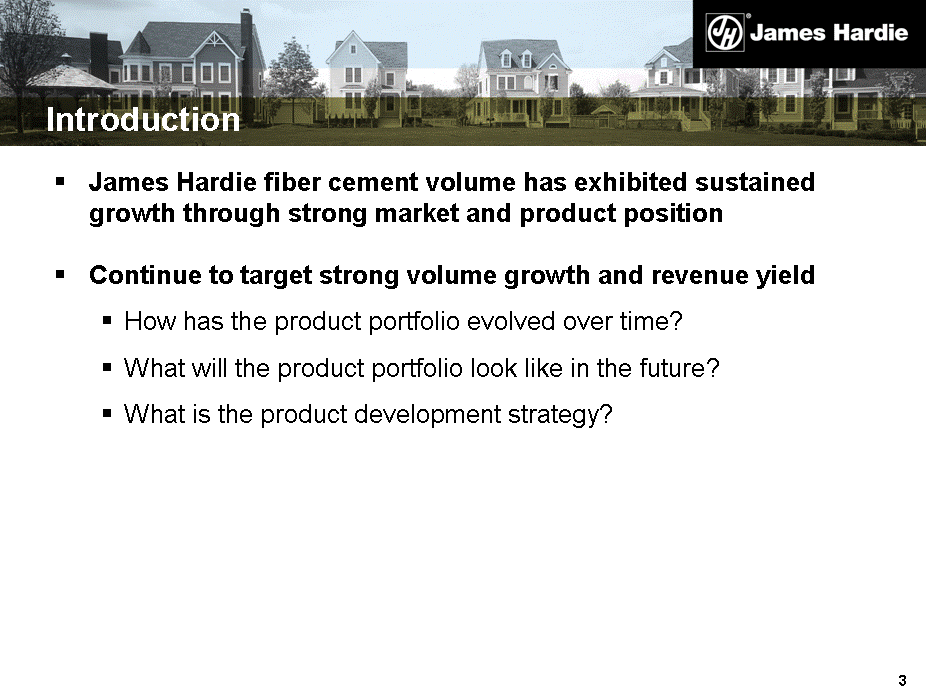
| Introduction James Hardie fiber cement volume has exhibited sustained growth through strong market and product position Continue to target strong volume growth and revenue yield How has the product portfolio evolved over time? What will the product portfolio look like in the future? What is the product development strategy? |
109
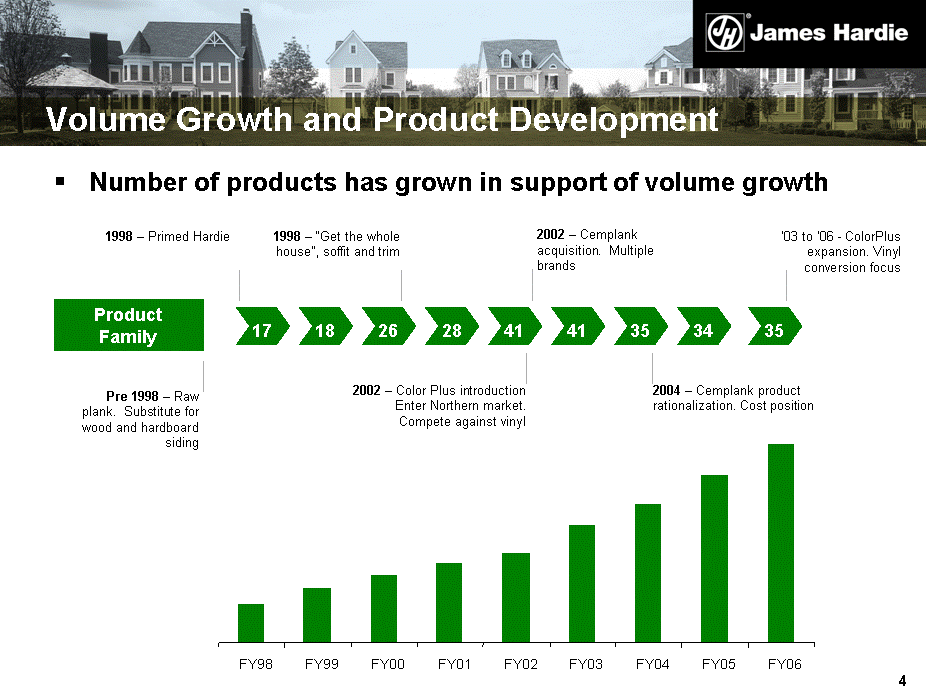
| FY98 FY99 FY00 FY01 FY02 FY03 FY04 FY05 FY06 Volume Growth and Product Development Number of products has grown in support of volume growth 18 26 28 41 41 35 34 35 Product Family 2002 - Color Plus introduction Enter Northern market. Compete against vinyl 2002 - Cemplank acquisition. Multiple brands 2004 - Cemplank product rationalization. Cost position Pre 1998 - Raw plank. Substitute for wood and hardboard siding 1998 - Primed Hardie '03 to '06 - ColorPlus expansion. Vinyl conversion focus 1998 - "Get the whole house", soffit and trim |
110
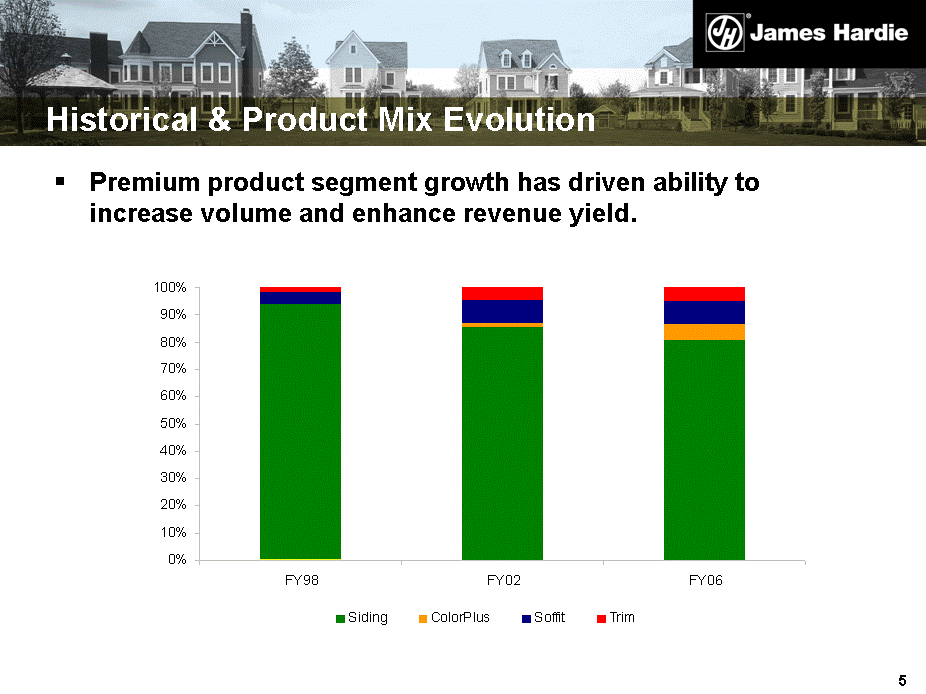
| Historical & Product Mix Evolution Premium product segment growth has driven ability to increase volume and enhance revenue yield. |
111

| Future Product Mix - Evolution Continue to grow core volume through product leadership and increase revenue yield through differentiated product position Pursue strategy to grow and defend market position Continue to gain share in existing markets to secure, strengthen and grow the core business Brand development..."Good, Better, Best" positioning Regional market focus Defend market share Enhance revenue yield through differentiated products Aggressively grow revenue yield through provision of new products Continued product innovation and differentiation as market position matures Leverage proven product leadership position |
112
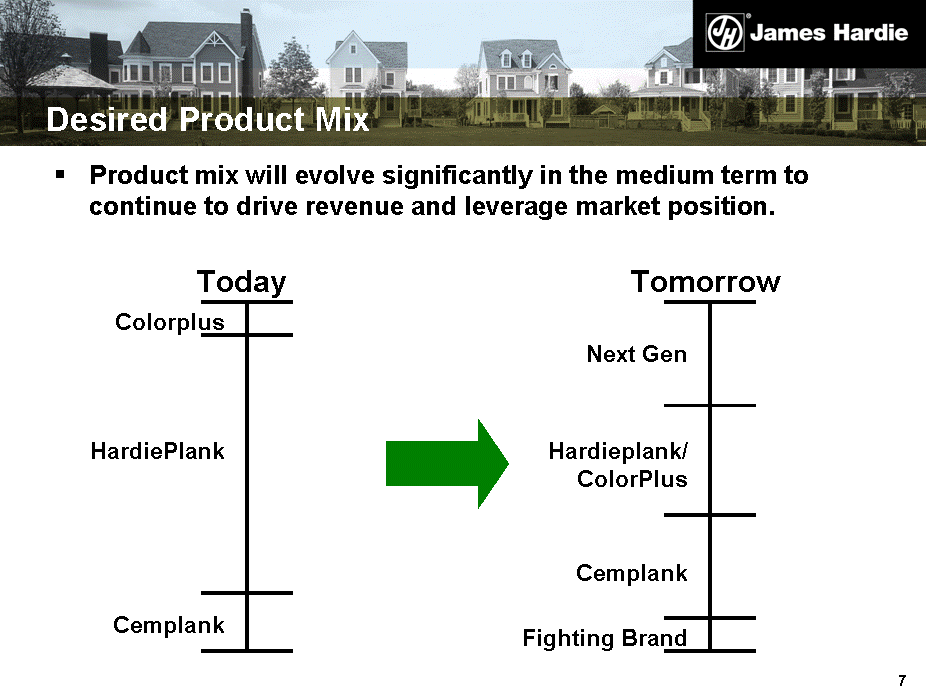
| Desired Product Mix HardiePlank Colorplus Cemplank Next Gen Fighting Brand Cemplank Hardieplank/ ColorPlus Today Tomorrow Product mix will evolve significantly in the medium term to continue to drive revenue and leverage market position. |
113
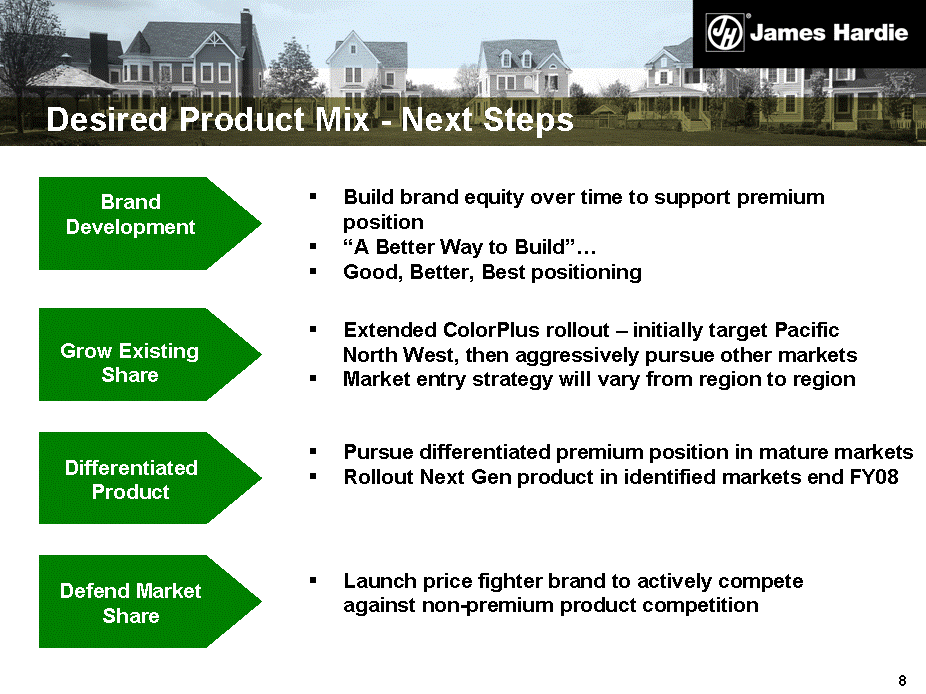
| Desired Product Mix - Next Steps Extended ColorPlus rollout - initially target Pacific North West, then aggressively pursue other markets Market entry strategy will vary from region to region Grow Existing Share Differentiated Product Defend Market Share Pursue differentiated premium position in mature markets Rollout Next Gen product in identified markets end FY08 Launch price fighter brand to actively compete against non-premium product competition Build brand equity over time to support premium position "A Better Way to Build"... Good, Better, Best positioning Brand Development |
114
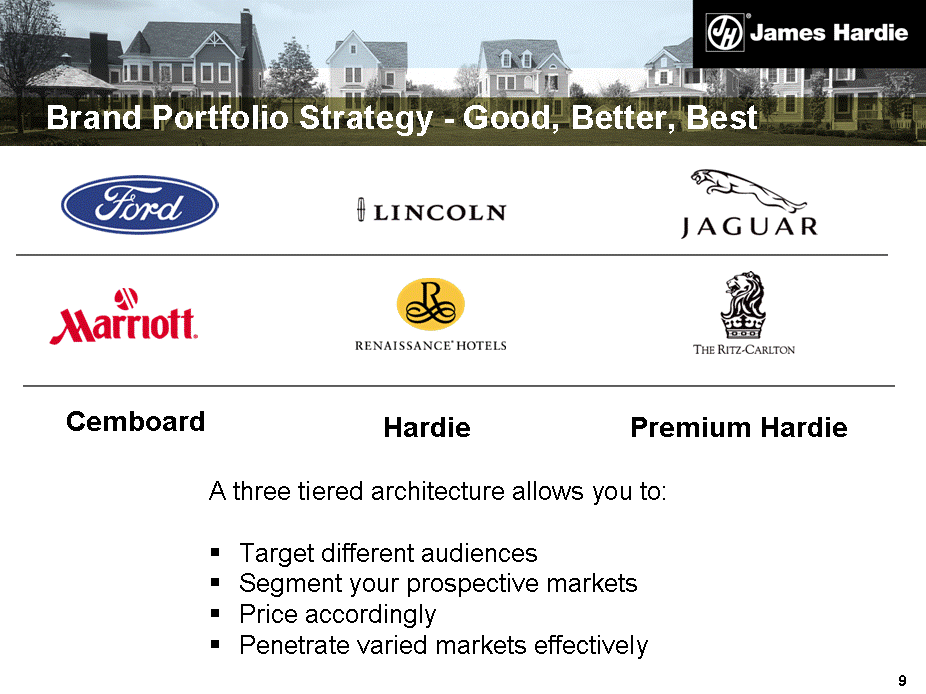
| Brand Portfolio Strategy - Good, Better, Best A three tiered architecture allows you to: Target different audiences Segment your prospective markets Price accordingly Penetrate varied markets effectively Cemboard Hardie Premium Hardie |
115

| Brand Strategy - New Branding Launching a new brand with a consistent look and feel across the product portfolio. A brand promise that connects with customers - - "A Better Way To Build." |
116
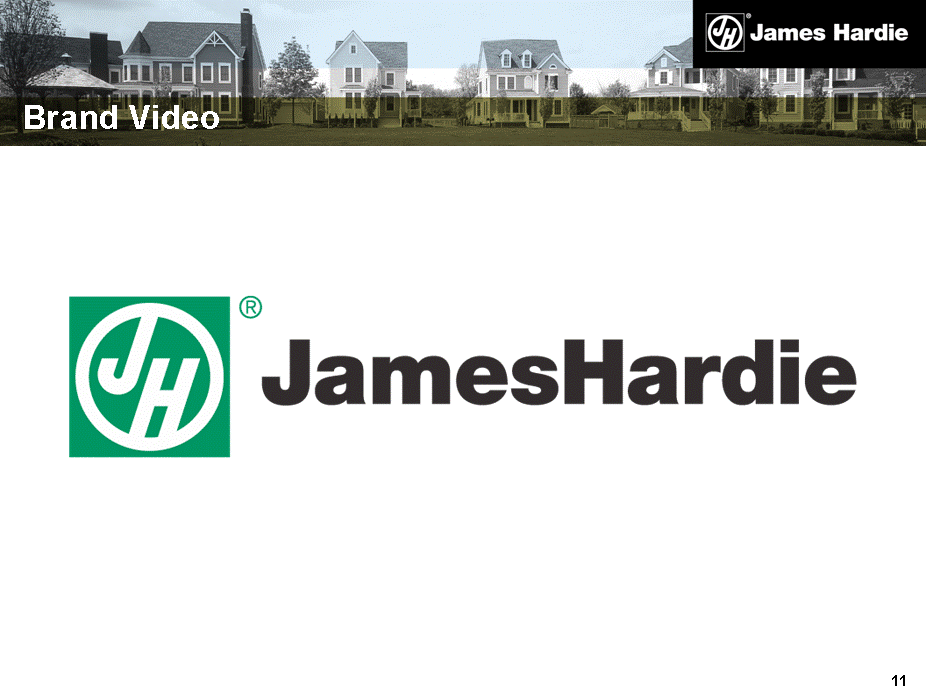
| Brand Video |
117
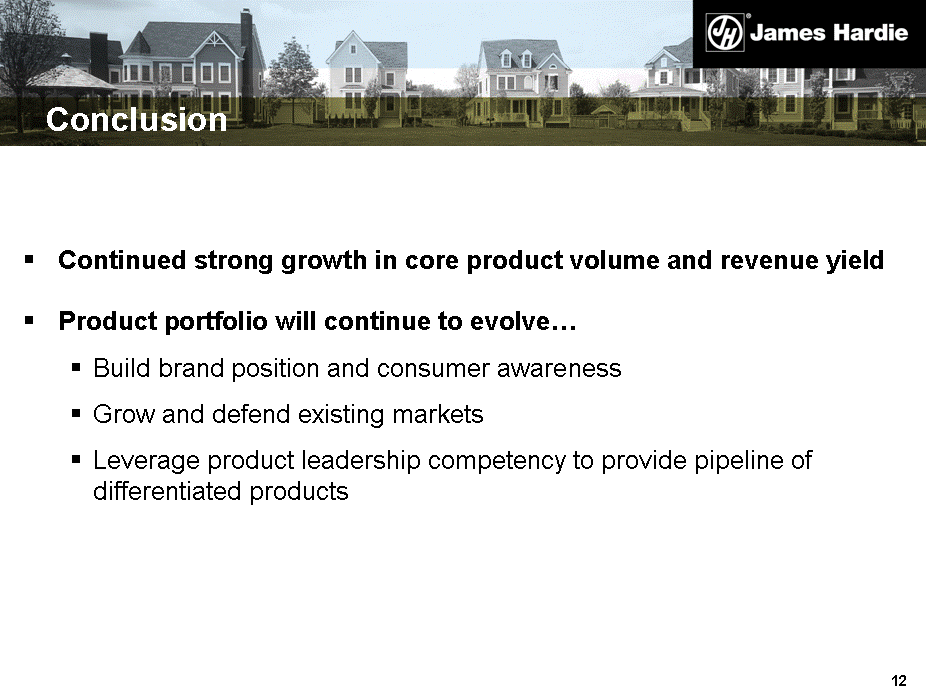
| Conclusion Continued strong growth in core product volume and revenue yield Product portfolio will continue to evolve... Build brand position and consumer awareness Grow and defend existing markets Leverage product leadership competency to provide pipeline of differentiated products |
118

| Sales Volumes mmsf - million square feet msf - thousand square feet Definitions |
119
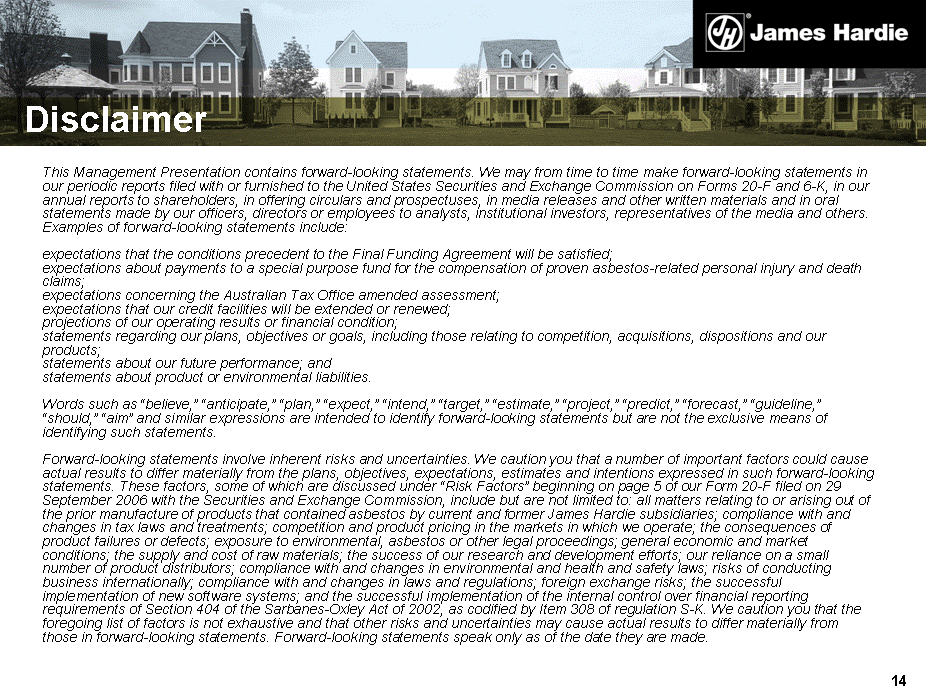
| This Management Presentation contains forward-looking statements. We may from time to time make forward-looking statements in our periodic reports filed with or furnished to the United States Securities and Exchange Commission on Forms 20-F and 6-K, in our annual reports to shareholders, in offering circulars and prospectuses, in media releases and other written materials and in oral statements made by our officers, directors or employees to analysts, institutional investors, representatives of the media and others. Examples of forward-looking statements include: expectations that the conditions precedent to the Final Funding Agreement will be satisfied; expectations about payments to a special purpose fund for the compensation of proven asbestos-related personal injury and death claims; expectations concerning the Australian Tax Office amended assessment; expectations that our credit facilities will be extended or renewed; projections of our operating results or financial condition; statements regarding our plans, objectives or goals, including those relating to competition, acquisitions, dispositions and our products; statements about our future performance; and statements about product or environmental liabilities. Words such as "believe," "anticipate," "plan," "expect," "intend," "target," "estimate," "project," "predict," "forecast," "guideline," "should," "aim" and similar expressions are intended to identify forward-looking statements but are not the exclusive means of identifying such statements. Forward-looking statements involve inherent risks and uncertainties. We caution you that a number of important factors could cause actual results to differ materially from the plans, objectives, expectations, estimates and intentions expressed in such forward-looking statements. These factors, some of which are discussed under "Risk Factors" beginning on page 5 of our Form 20-F filed on 29 September 2006 with the Securities and Exchange Commission, include but are not limited to: all matters relating to or arising out of the prior manufacture of products that contained asbestos by current and former James Hardie subsidiaries; compliance with and changes in tax laws and treatments; competition and product pricing in the markets in which we operate; the consequences of product failures or defects; exposure to environmental, asbestos or other legal proceedings; general economic and market conditions; the supply and cost of raw materials; the success of our research and development efforts; our reliance on a small number of product distributors; compliance with and changes in environmental and health and safety laws; risks of conducting business internationally; compliance with and changes in laws and regulations; foreign exchange risks; the successful implementation of new software systems; and the successful implementation of the internal control over financial reporting requirements of Section 404 of the Sarbanes-Oxley Act of 2002, as codified by Item 308 of regulation S-K. We caution you that the foregoing list of factors is not exhaustive and that other risks and uncertainties may cause actual results to differ materially from those in forward-looking statements. Forward-looking statements speak only as of the date they are made. Disclaimer |